HORSES AND THEIR MANAGEMENT.
131
IN AND ABOUT THE BARN.
HORSES AND THEIR MANAGEMENT.
After Fasting........................ 136
Air, Circulation of................... 133
Bread for the Stable................. 137
Breeding and Training:
Abortion........................... 138
Bearing-Rein, the.................. 142
" Breaking” Horses................ 140
Breed for what you want........... 137
Breeding in-and-in................. 138
Check-Rein, the.................... 142
Colt, Training the.................. 140
Directions, Rarey’s................ 139
Exercise........................... 138
Foaling............................ 138
Foaling Time, Indications of....... 138
In-and-in Breeding................ 138
Indications of Foaling Time....... 138
Mare and Colt, the................. 138
Not too Early...................... 137
Proper Time, the.................. 138
Rarey’s Directions................. 139
Rein, the Check- .................. 142
Slinking the Foal.................. 138
Training the Colt.................. 140
Young Colt, the................... 139
Circulation of Air.................... 133
Corn, Indian......................... 136
Diseases and Accidents, and their
Treatment:
Abdomen, Dropsy of the........... 165
Abdominal Injuries................ 164
Abraded Wounds.................. 192
Abscess of the Brain............... 164
Acites.............................. 165
Acute Dysentery................... 165
Acute Gastritis..................... 165
Acute Laminitis.................... 165
Albuminous Urine................. 166
Angles of the Mouth, Excoriated .. 173
Aphtha............................ 166
Back Sinews, Clap of the........... 170
Back Sinews, Sprain of the......... 188
Biting, Crib....................... 172
Bladder, Inflammation of the...... 172
Bloody Urine...................... 176
Bog Spavin........................ 166
Bots............................... 166
Brain, Abscess of the.............. 164
Brain, Inflammation of the......... 166
Breaking Down.................... 166
Broken Knees...................... 167
Broken Wind...................... 167
Bronchitis.......................... 167
Bronchocele....................... 168
Bruise of the Sole.................. 168
Calculi............................. 168
Calculus........................... 164
Canker............................. 168
Capped Elbow..................... 169
Capped Hock...................... 169
Capped Knee...................... 169
Cartilages, Ossified................. 181
Gataract........................... 169
Diseases and Accidents:
Cavities, Open Synovial........... 181
Choking........................... 169
Chronic Dysentery................. 170
Chronic Gastritis................... 170
Chronic Hepatitis.................. 170
Clap of the Back Sinews........... 170
Cold............................... 171
Colic, Spasmodic................... 187
Colic, Windy...................... 191
Congestion in the Field............ 171
Congestion in the Stable........... 171
Contused Wounds.................. 192
Corns.............................. 171
Cough............................. 172
Cracked Heels...................... 172
Crib-Biting........................ 172
Curb............................... 172
Cystitis............................ 172
Diabetes........................... 173
Diagram showing seat of diseases.. 163
Diaphragm, Spasm of.............. 187
Dropsy of the Abdomen........... 165
Dysentery, Acute.................. 165
Dysentery, Chronic................ 170
Elbow, Capped.................... 169
Enteritis........................... 173
Epizoöty.......................... 173
Excoriated Angles of the Mouth... 173
Eyes, Fungoid Tumor in the....... 174
Eyelid, Lacerated.................. 177
False Quarter...................... 173
Farcy.............................. 173
Farcy, Water...................... 191
Feet, Fever in the.................. 165
Fever in the Feet.................. 165
Field, Congestion in the........... 171
Fistulous Parotid Duct............. 174
Fistulous Withers.................. 174
Flexor Tendons, Strain of the...... 189
Foot, Pumice...................... 184
Fret.............................. 187
Fungoid Tumor in the Eyes....... 174
Gastritis, Acute.................... 165
Gastritis, Chronic.......,.......... 170
Glanders........................... 175
Gleet, Nasal....................... 179
Grease............................. 175
Gripes............................. 187
Gutta Serena....................... 175
Heart-Disease...................... 176
Heels, Cracked..................... 172
Hematuria......................... 176
Hemorrhagica, Purpura........... 184
Hepatitis, Chronic.................. 170
Hide-Bound....................... 176
High-Blowing...................... 176
Hock, Capped..................... 169
Hydrophobia...................... 176
Hydrothorax...................... 176
Impediment in Lachrymal Duct.... 177
Incised Wounds.................... 192
Inflammation of the Bladder....... 172
Diseases and Accidents:
Inflammation of the Brain......... 166
Inflammation of the Kidneys....... 180
Inflammation of the Vein.......... 182
Influenza........................... 177
Injuries, Abdominal................ 164
Injuries to the Jaw................. 177
Insipidus Diabetes................. 173
Introsusception.................... 164
Invagination....................... 164
Jaw, Injuries to the................ 177
Joints, Open Synovial.............. 181
Kidneys, Inflammation of the...... 180
Knees, Broken..................... 167
Knee, Capped...................... 169
Lacerated Eyelid.................. 177
Lacerated Tongue................. 177
Lacerated Wounds................. 192
Lachrymal Duct, Impediment in... 177
Laminitis, Acute.................. 165
Laminitis, Subacute................ 177
Laryngitis......................... 177
Larva in the Skin.................. 178
Legs, Swollen...................... 190
Lice............................... 178
Luxation of the Patella............ 178
Mallenders........................ 178
Mange............................. 178
Megrims........................... 179
Melanosis......................... 179
Mouth, Excoriated Angles of...... 173
Mouth, Scald...................... 186
Nasal Gleet....................... 179
Nasal Polypus..................... 179
Navicular Disease.................. 179
Nephritis.......................... 180
Occult Spavin..................... 180
Œsophagus, Stricture of........... 185
Open Synovial Cavities............ 181
Open Synovial Joints.............. 181
Ophthalmia, Simple................ 186
Ophthalmia, Specific............... 188
Ossified Cartilages................. 181
Overreach........................ 181
Paralysis, Partial.................. 182
Parotid Duct, Fistulous............ 174
Partial Paralysis................... 182
Patella, Luxation of the............ 178
Phlebitis........................... 182
Phrenitis................ .......... 182
Pleurisy............................ 182
Pneumonia......................... 183
Poll Evil........................... 183
Polypus, Nasal..................... 179
Prick of the Sole.................. 183
Profuse Staling.................... 173
Prurigo............................ 183
Pumice Foot....................... 184
Punctured Wounds................ 193
Purpura Hemorrhagica............ 184
Quarter, False..................... 173
Quittor............................ 184
Rheumatism....................... 184
132
THE FRIEND OF ALL.
Diseases and Accidents :
Ring-Bone......................... 185
Ringworm......................... 185
Roaring............................ 185
Rupture........................... 185
Ruptured Spleen................... 164
Ruptured Stomach................. 164
Sallenders......................... 178
Sand-Crack........................ 185
Scald Mouth....................... 186
Seedy Toe......................... 186
Simple Ophthalmia................ 186
Sinews, Sprain of the Back........ 188
Sitfast............................. 186
Skin, Larva in the................. 178
Sole, Bruise of the................. 168
Sole, Prick of the.................. 183
Sore Throat;....................... 186
Spasm of the Diaphragm.......... 187
Spasm of the Urethra.............. 187
Spasmodic Colic................... 187
Spavin............................. 187
Spavin, Bog....................... 166
Spavin, Occult..................... 180
Specific Ophthalmia................ 188
Spleen, Ruptured.................. 164
Splint.............................. 188
Sprain of the Back Sinews......... 188
Stable, Congestion in the........... 171
Staggers........................... 188
Staling, Profuse................... 173
Strain of the Flexor Tendons....... 189
Stomach, Ruptured................ 164
Strangles.......................... 189
Strangulation...................... 164
Stricture of the Œsophagus........ 185
Stringhalt.......................... 189
Surfeit............................. 189
Swollen Legs...................... 190
Synovial, Open Cavities............ 181
Synovial, Open Joints.............. 181
Teeth.............................. 190
Tendons, Flexor, Strain of......... 189
Tetanus............................ 190
Thorough-Pin..................... 190
Throat, Sore....................... 186
Thrush............................. 190
Toe, Seedy......................... 186
Tongue, Lacerated................ 177
Tread............................. 190
Tumors............................ 191
Tumors, Fungoid, in the Eye...... 174
Urine, Albuminous................ 166
Urine, Bloody...................... 176
Urethra, Spasm of................. 187
Vein, Inflammation of the...... ... 182
Warts............................ 191
Diseases and Accidents:
Water-Farcy....................... 191
Wheezing.......................... 176
Wind, Broken...................... 167
Wind-galls......................... 191
Windy Colic....................... 191
Withers, Fistulous................. 174
Worms............................. 192
Wounds............................ 192
Drainage............................ 134
Exercise............................. 135
Fasting, After....................... 136
Floors, and Paving.................. 133
Good Mashes........................ 137
Grooming............................ 134
Gruel for Horses..................... 136
Hay.................................. 135
Hay-Tea.............,............... 136
History, the Horse in................ 132
Horse in History, the................ 132
How to Feed........................ 136
Indian Corn.......................... 136
Light................................ 134
Litter................................ 134
Mashes, Good........................ 137
Oats................................. 135
Paving and Floors................... 133
Points:
Abdomen, the...................... 157
Back, the.......................... 154
Ear, the............................ 155
Eye, the........................... 156
Head, the.......................... 155
Lips, the........................... 156
Legs and Shoulders, the........... 158
Lower Leg, the.................... 158
Lumbar Region, the............... 153
Lungs and Thorax, the............ 158
Neck, the.......................... 155
Nostrils, the........................ 156
Shoulders and Legs, the............ 158
Stem and Rudder.................. 153
Tail, the........................... 154
Thorax and Lungs, the............ 157
Withers, the....................... 158
Remedies, and their Administration:
Aloes.............................. 194
Balling-Iron....................... 194
Ball passing down Gullet.......... 196
Balls............................... i94
Bleeding........................... 199
Blisters............................ 198
Cut of Swallowing Ball............ 196
Cut of Bleeding a Horse........... 199
Cuts of Giving a Draught......... 198
Draughts, Giving.................. 197
Drinks............................. 196
Remedies, and their Administration:
Fleam, Open and Shut............. 199
Giving Draughts.................. 197
Holding the Pail..................200
Horse-Balls........................ 194
Horses not all Alike................ 193
Mashes, Warm..................... 193
New Balling Iron.................. 195
New Way of Giving Ball.......... 195
Old Way of Giving Ball........... 194
Other Physics...................... 194
Process of Drinking................ 196
Quiet Method of Giving Draught.. 198
Suture, Twisted.................... 200
Third Avenue Stables.............. 201
Tongue and Mouth................ 197
Turkish Bath....................... 200
Twisted Suture.................... 200
Warm Mashes..................... 193
Roots................................ 137
Shoeing:
Arab Method, the.................. 148
Boots.............................. 152
Calks.............................. 150
Cutting............................ 152
Hoof, Structure of................. 148
Interfering........................ 152
Method, the Arab.................. 148
Method, the Usual................. 148
Mischief from Separation.......... 148
Paring too Small........,.......... 151
Rarey‘s Directions................. 146
Shoe, the Slipper.................. 150
Slipper-Shoe, the.................. 150
Slippery Weather.................. 151
Structure of the Hoof.............. 148
Usual Method, the................. 148
Weather, Slippery................. 151
Sieve, Value of a..................... 137
Stable, the........................... 133
Stalls................................ 133
Straw................................ 137
Trash................................ 137
Teeth, the............................ 142
Value of a Sieve..................... 137
“ Vices,” so called :
Balking, or Jibbing................ 160
Chink in the Back................. 161
Horses not totally Depraved....... 160
Jibbing, or Balking................ 160
“ Kidney-Dropping”.............. 161
Rolling............................ 163
Shying and Swerving.............. 162
Tearing the Clothing.............. 162
“ Toothy” and “ Temper”......... 159
When to Feed........................ 136
Far back in History.—The origin of the horse
lies far back in antiquity, and his is a familiar
figure in almost all extant literature. Homer,
Hesiod and Pindar tell us not only of horses,
but of centaurs, half man and half horse, so that
long before their time the horse must have been
sufficiently conquered to the use of man to have
originated the old legend. The usual chronology
puts the Book of Job more than fifteen hundred
years before Christ; late investigators put it
nearly nine hundred years later. But the de
scription Jahweh gives Job of the horse indicates
that he must have been the same essentially
then as now: “ Hast thou given the horse
strength ? hast thou clothed his neck with thun
der? . . . the glory of his nostrils is terrible. . . .
He paweth in the valley, and rejoiceth in his
strength ; he goeth to meet the armed men,” etc.
The whole account is appropriate to the modern
war-horse; and it is quite doubtful whether the
naturalist, if he had the horse of Job‘s time,
Alexanders Bucephalus, and the charger Gen.
Sheridan rode to Winchester, could from any in
ternal indications determine which was which.
Undoubtedly if the best trotting-horses of each
age at intervals of five hundred years could be
speeded together, the date could be assigned to
each. When Hi. Woodruff drove at Fashion and
Union courses, the aim was a “ two-forty” gait;
now the flyers are hovering between " two-ten”
HORSES AND THEIR MANAGEMENT. 133
and “two-eleven,” and will soon be shading off
inside the ten. Such an animal as is now with
out any great difficulty to be had, deserves, and
will repay, careful and intelligent treatment.
The Stable.—This is a very important part of
the subject and one which is too often neglected
by people who own horses and who leave their
general management to stable-keepers or grooms
often grossly neglectful or ignorant. Many
horses die yearly from the neglect of their own
ers to enforce the ordinary laws of health in the
stable. A site should be chosen, nearly or quite
as well situated as that for the dwelling, and the
stable may be, if possible, separate and distinct
from the barn with advantage. Hide it if you
like behind trees, but do not cut off the
Circulation of Air.—A supply of pure air is as
necessary to the life and health of a horse as of
a man. In many stables air is carelessly ad
mitted and blows either on the head of the horse
or in such a way that cold and cough is the in
evitable result. The practice of feeding hay
through a hole above the head of the horse in
vites fatal results in the way of cold, not to men
tion the possibility of hayseed falling into the
eyes of the horse when it is looking up for its
food. An opposite error, however, is to exclude
every possible breath of air and have the atmos
phere of the stable hot and unwholesome. The
effect of several horses being shut up in one sta
ble is to render the air unpleasantly warm and
foul. A person coming from the open air can
not breathe it many minutes without perspiring.
In this temperature the horse stands, hour by
hour, often with a covering on; this is suddenly
stripped off, and it is led into the open air, the
temperature of which is many degrees below
that of the stable. It is true that while it is ex
ercising it has no need of protection ; but unfor
tunately it too often has to stand awaiting its
master’s convenience, and this perhaps after a
brisk trot which has opened every pore, and its
susceptibility to cold has been excited to the ut
most extent. In ventilating stables it should
never be forgotten that the health of a horse de
pends on an abundant supply of fresh dry air, in
troduced in such a manner as to prevent a pos
sible chance of a draught on any of its inmates.
Many old stables may be greatly benefited by
the introduction of a window or windows which
will require but little expenditure and save
many dollars worth of horseflesh.
Stalls.—Large stalls are to be preferred, and
each horse should have his separate stall. Each
stall should be ten feet from front to rear, and
with a width of five to five and a half feet. At
the foot of each stall should be a round partition
post set slightly inclining, so that the bottom
shall be ten feet and the top eight feet from the
head of the stall; the sides four and a half feet
high, of two-inch plank; and if unruly horses are
to be placed there, a couple of feet in height of
woven wire cloth should be added at the top.
Or, the stalls may be placed in rows each six
feet wide, nine feet long, with the height above
to the extent of fourteen feet. Three feet in
front of the manger gives room for the feed
to be brought and given, and six feet behind
the stalls gives space for proper cleaning.
If the size of the stable will admit of it, loose
boxes are of great benefit; and at all events there
should be one loose box for cases of sickness,
and this should be situated at some distance
from the other stalls, to prevent the spread of
any contagious disease.
Floors, and their Paving.—One good plan is to
make the floor double, the upper one in three
parts; the first three feet in front, of two-inch
hardwood plank, should be laid close and nailed
solid; the other two sections of narrow hardwood
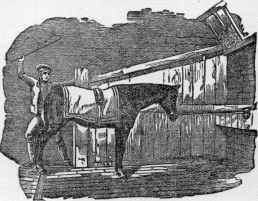
The Hind Feet are Eased in the Gutter.
plank, to be nailed on strong end-pieces, with half-
inch spaces between. These are to be hinged to
other plank nine inches wide, next the sides of the
stall, so as to shut together at the middle, to
within half an inch of each other. Thus, all the
liquid matter passes directly through to the solid
and water-tight floor beneath, made of planed
and grooved plank, and ending, just inside the
posts, in a narrow gutter, whence it may be con
veyed away to a tank.
Where there are irregularities, cleanliness is
almost impossible. A good material is stone
when well jointed. Cement, however, is the
best when properly laid, as its elasticity is a great
relief to the feet of a horse.
A slanting of the floor of the stalls should
never be allowed, as it is frequently the cause of
lameness and contraction of the heels. To keep
the feet on a level, horses will sometimes stand
out of their stalls with the hind feet over the
gutter, as in the cut above.
134 THE FRIEND OF ALL.
Drainage.—The stable snould be so contrived
that the urine shall quickly run off, and the of
fensive and injurious vapor from the decompos
ing urine and the litter will thus be materially
lessened : if, however, the urine be carried away
by means of a gutter running along the stable, it
must be so done as not to raise the level of the
horse’s hind feet above that of his forefeet. The
farmer should not lose any of the urine. It is
from the dung of the horse that he derives a
principal and the most valuable part of his ma
nure. It is that which earliest takes on the pro
cess of decomposition, and forms one of the
strongest and most durable dressings. That
which is most of all concerned with the rapidity
and perfection of the process is the urine.
Litter.—Some intelligent persons have com
plained much of the influence of litter. If the
horse stand many hours in the day with his foot
embedded in straw, it is supposed that the hoof
must be unnaturally heated ; and it is said that
the horn will contract under the influence of
heat. It is seldom, however, that the foot is so
surrounded by the litter that its heat will be
sufficiently increased to produce this effect on
the thick horn. The foot is not sufficiently long
or deeply covered by the litter to produce a tem
perature high enough to warp the hoof. We are
not the disciples of those who would, during the
day, remove all litter from under the horse; we
do not like the naked and uncomfortable appear
ance of the stable. Humanity and a proper care
of the foot of the horse should induce us to keep
some litter under him during the day; but his
feet need not sink so deeply in it that their tem
perature should be much affected.
Great care should be taken that every portion
of litter be removed that has been wet by urine,
as decay commences very quickly and the gases
given off in that state are highly injurious. In
some stables piles of litter are allowed to accu
mulate and serve as a cloak for great unclean-
liness; this should never be permitted.
Light.-This neglected branch of stable-manage
ment is of far more consequence than is generally
imagined. The stable is frequently destitute of
any glazed window; and has only a shutter,
which is raised in warm, and shut down in cold
weather. When the horse is in the stable only
during a few hours of the day, this is not of so
much consequence ; nor of so much, probably, to
horses of slow work ; but to carriage and road
horses, so far at least as the eyes are concerned, a
dark stable is little less injurious than a foul and
heated one. To illustrate this, reference may be
made to the unpleasant feeling and the utter im
possibility of seeing distinctly, when a man sud
denly emerges from a dark place into the full
blaze of day. The sensation of mingled pain and
giddiness is not soon forgotten; and some time
passes before the eye can accommodate itself to
the increased light. If this were to happen every
day, or several times in the day, the sight would
be irreparably injured; or, possibly, blindness
would ensue. Can we wonder, then, that the
horse taken from a dark stable into a glare of
light, and feeling, probably, as we should under
similar circumstances, and unable, for a consider
able time, to see anything around him distinctly,
should become a starter, or that the frequently
repeated violent effect of sudden light should in
duce inflammation of the eye, so intense as to
terminate in blindness? There is, indeed, no
doubt, in the mind of any one familiar with the
subject, that horses kept in a dark stable are fre
quently notorious starters, and that starting has
been evidently traced to this cause.
If plenty of light be admitted, the walls of the
stable, and especially that portion of them which
is before the horse’s head, must not be of too
glaring a color. The constant reflection from a
white wall, and especially if the sun shines into
the stable, will be as injurious to the eye as the
sudden changes from darkness to light. The
perpetual slight excess of stimulus will do as
much mischief as the occasional but more violent
one, when the animal is taken from a kind of
twilight to the blaze of day. The color of the
stable, therefore, should depend on the quantity
of light. Where much can be admitted, the walls
should be of a gray hue. Where darkness would
otherwise prevail, frequent whitewashing may in
some degree dissipate the gloom.
Grooming.—Of this much need not be said.
The animal that is worked in all weathers needs
little more than a good brushing of his legs. It
is to the stabled horse, highly fed, and irregularly
worked, that grooming is of so much consequence.
Good rubbing with the brush opens the pores of
the skin, circulates the blood and therefore pro
duces a healthy perspiration, and stands in the
room of exercise. No horse will carry a fine
coat without either heat or dressing. They both
effect the same purpose ; they both increase the
insensible perspiration ; but the first does it at
the expense of health and strength, while the
second, at the same time that it produces a glow
on the skin, and a determination of blood to it,
rouses all the energies of the frame. It would
be well for the proprietor of the horse if he were
to insist upon it, and to see that his orders are
really obeyed, that the fine coat he delights in, is
produced by honest rubbing, and not by a heated
stable and thick clothing. When the weather
will permit the horse to be taken out, he should
never be groomed in the stable. Experience
teaches that if the cold is not too great, the ani
mal is invigorated from being dressed in the
HORSES AND THEIR MANAGEMENT. 135
open air. inere is no necessity, however, for
half the punishment which many a groom inflicts
upon the horse in the act of dressing; and par
ticularly on one whose skin is thin and sensible.
The currycomb should at all times be lightly ap
plied. With many horses its use may be almost
dispensed with ; and even the brush need not be
so hard, nor the points of the bristles so irregular
as they often are. A soft brush, with a little
more weight of the hand, will be equally effec
tual and a great deal more pleasant to the horse.
A haircloth, while it will seldom irritate and
tease, will be almost sufficient with horses that
have thin hair, and that have not been neglected.
Whoever would be convinced of the benefit of
friction to the horse‘s skin, and to the horse
generally, need only observe the effect produced
by well hand-rubbing the legs of a tired horse.
Every enlargement subsides, the painful stiffness
disappears, the legs attain their natural warmth
and become fine, and the animal is evidently and
rapidly reviving ; he attacks his food with ap
petite, and then quietly lies down to rest.
Exercise.—The work of a farm-horse is usually
regular and not exhausting. He is neither pre
disposed to disease by idleness, nor worn out by
excessive exertion. He has enough to do to
keep him in health, and not enough to distress
or injure him : on the contrary, the regularity of
his work prolongs life. For those who keep a
horse for business or pleasure, the first rule we
would lay down is, that every horse should have
daily exercise. The horse that, with the usual
stable feeding, stands idle for three or four days,
as is the case in many establishments, must suffer.
He is disposed to fever, or to grease, or, most of
all, to diseases of the foot; and if, after these
three or four days of inactivity, he is ridden fast
and far, is almost sure to have inflammation of
the lungs or of the feet.
A road-horse is apt to suffer a great deal more
from idleness than he does from work. A stable-
fed horse should have two hours’ exercise every
day, if he is to be kept free from disease. And
this should be moderate at the beginning and
at the end. Nothing of extraordinary or even
of ordinary labor can be effected on the road
or in the field without sufficient and regular
exercise. It is this alone which can give energy
to the system, or develop the powers of any ani
mal. How then is this exercise to be given ? As
much as possible by, or under the superintendence
of, the owner. The exercise given by any em
ployee is rarely to be depended upon. It is in
efficient, or it is extreme. It is in many cases
both irregular and injurious. It is dependent on
the caprice of him who is performing a task, and
who will render that task subservient to his own
pleasure or purposes.
In training the horse, regular exercise is the
most important of all considerations, however it
may be forgotten in the usual management of
the stable. The exercised horse will discharge
his task, sometimes a severe one, with ease and
pleasure, while the idle and neglected one will
be fatigued ere half his labor be accomplished,
and if he be pushed a little too far, dangerous in
flammation will ensue. How often, nevertheless,
does it happen, that the horse that has stood in
active in the stable three or four days, is ridden
or driven thirty or forty miles in the course of
a single day ? This rest is often purposely given
to prepare for extra exertion ; to lay in a stock
of strength for the performance of the task re
quired of him : and then the owner is surprised
and dissatisfied, if the animal is fairly knocked
up, or possibly becomes seriously ill.
Hay.—The best kinds of hay for horses are the
Timothy, sometimes called Herdsgrass; Orchard
grass; Red-top; and Fowl-meadow. A sweet-
scented vernal grass is common in Northern and
Eastern meadows, and gives the peculiar odor to
new-mown hay so universally admired. A great
part of the hay sold has been pressed and baled,
and in that condition cannot be easily examined;
and if it could, it would even then be hard for
the purchaser exactly to suit himself, supposing
him to know just what is best. For very few
people know how to tell a good from a bad
sample of hay. And yet the characteristics of
good hay are very marked, and such only should
be purchased by the careful horse-owner. Clover
is apt to be dusty, and not properly cured, and
ought not to be fed to horses.
The report of the United States Department
of Agriculture for 1911 estimates that there
were devoted to hay in the United States in
1910, 45,691,000 acres producing 60,978,000
tons valued at $747,769,000; an average to the
acre of 1.33 tons worth $12.26 per ton or
$16.31 per acre. The average farm price of
hay per ton of 2,000 pounds on December 1st,
1904, was $8.72; in 1905, $8.52; in 1906, $10.37;
in 1907, $11.68; in 1908, $8.98; in 1909, $10.62,
and in 1910, $12.26.
Oats.—These with hay constitute what may be
called the standard food of the horse. They
should not be bought by measurement, but by
weight. In Great Britain, a “ prime” sample will
weigh nearly or quite 50 pounds; in the United
States, good oats weigh, say, 35 pounds to the
bushel. A first-rate oat will give three quarters
of its weight in pure grain after the chaff is re
moved ; while a poorer oat gives a less percentage
of solid nutriment. The buyer should be as
careful as to the quality of the oats he buys as to
the quality of his hay. A sound oat should be
I dry and hard ; it should almost chip asunder, and
136
THE FRIEND OF ALL.
not be torn or broken into pieces by compres
sion.
It is estimated that there were devoted to
oats in the United States in 1910, 35,288,000
acres producing 1,126,765,000 bushels valued at
$384,716,000; an average to each acre of 31.9
worth 34.1 cents per bushel or $10.88 per acre.
The great damage done to oats and other cer
eal crops by rusts has been the incentive to
give these diseases further attention. Breed
ing grains for rust resistance is being im
proved by the Department of Agriculture.
Indian Corn.—Next to hay and oats, the most
important food of the horse is corn, or maize.
Corn in the ear should weigh about 70 pounds to
the bushel, and shelled corn about 56. If a pair
of horses require half a bushel of oats a day, they
will require as an equivalent in Indian corn,
half a bushel in the ear, or 28 pounds shelled.
Corn in its natural state is too hard for the teeth
and stomach of many horses, and is a great deal
better for bruising and steaming or softening.
It is estimated that there were devoted to
Indian corn in the United States in 1910, 114,-
002,000 acres, producing 3,125,713,000 bushels,
valued at $1,523,968,000; an average to each
acre of 27.4 bushels, worth 48.8 cents per
bushel, or $13.37 Per acre. The value of the
corn crop in 1910 is more than enough to
cancel the interest bearing debt of the United
States and buy all the gold and silver mined
in all the countries of the earth in 1910.
How, and How Much, to Feed.—What work has the
horse to do ? One kept at slow and exhausting
labor should have three times a day as much
clean, sound grain as he will eat, and as much
clean sweet hay at night as he will consume. In
hot weather the grain should be oats; in winter,
half oats, half corn, with intermediate propor
tions in intermediate weather. For cut feed,
mix with half corn and half oats, ground to
gether, one third the bulk of bran. When the
horses are fed whole grain, this mess is good two
or three times a week, as a change. Farm-horses
should be fed in this way: Give grass at night
when you can instead of hay, but cut the grass
and carry it to the manger; do not turn him out
at night to pasture and make him work to get
his food during the time he ought to be at rest.
Road and pleasure horses should have, in ad
dition to the oats and hay they will eat, a sweet
mash of bran once or twice a week. Don‘t turn
them out to grass. Still, grass in May and early
June, giving a few oats daily with it, is not un-
advisable. Musty or dusty grain ought never to
be fed to horses. It invites heaves and other
disorders. Even washing and kiln-drying will
not cure it.
In the stables of the Third Avenue Railroad
Company, New York, are kept about two thou
sand horses; and according to a very interesting
paper in the St. Nicholas, well worth the reading
of any man or boy, the daily allowance for each
horse is given at twenty-seven pounds of hay,
oats and corn, ground and mixed, equally di
vided into three meals.
When to Feed Horses.—Regularity is as essential
to equine as to human animals. The stomach of
a civilized horse is small, even smaller than that
of his wilder ancestor. Horses that do fast and
exhausting work should be fed grain four times
a day; when at work late in the afternoon or
evening, the last feed should be later than other
wise. Horses are as a rule more apt to undereat
than to overeat; and only when an animal is
gluttonous, should he be restricted in food.
There ought to be an interval of an hour or
more after a meal before a horse is put at work.
After Fasting.—When a horse returns home,
after a long fast, it is most unwise to place the
famished beast before a heaped manger. First
attend to its immediate requirements. These
satisfied, and the harness removed, a pail of gruel
should be offered to the animal. The writer
knows it is said by many grooms that their
horses will not drink gruel; the author likewise
is aware that most servants dislike the bother
attendant on its preparation, while few under
stand the manner in which it should be prepared,
The general plan is to stir a little oatmeal into
any pail containing hot water, and to offer the
mess, under the name of gruel, to the palate which
long abstinence may have rendered fastidious.
The horse only displays its intelligence when it
rejects the potion thus rudely concocted.
Gruel for Horses.—One quart of oatmeal should
be put into a two-gallon pot, which is to be
gradually filled with boiling water, a little cold
being first used, merely to divide the grains. The
saucepan is then placed on the fire, and its con
tents are to be briskly stirred until the liquid has
boiled for ten minutes. After this, it may be put
where it will only just simmer; and in one hour
the gruel will be ready or in shorter time,
should the fire be fierce. The liquid is then
poured through a sieve. The solid part is mingled,
while hot, with an equal quantity of bran, and
this mixture, having been closely covered, is
placed in the manger half an hour after the gruel
has been imbibed.
Hay Tea. —This also is refreshing for a tired
horse. Fill a pail with the best of clean bright
hay, and pour in as much boiling water as the
pail will hold. Keep it covered and hot fifteen
minutes, turn off the water into another pail, and
add a little cold water, enough to make a gallon
and a half or so, and when cold, feed it to the
horse.
HORSES AND THEIR MANAGEMENT. 137
Good Mashes.—Boil a couple of quarts of ground
oats, a pint of flax-seed and a little salt, three
hours. Add bran to bring it to a proper con
sistency, and a little molasses. Cover in, and
feed cold.—Another. Moisten four quarts of bran
gradually with hot water, add enough boiling
water to get the proper consistency, add a sprinkle
of salt, cover with a cloth, and feed cold.
Value of a Sieve.—The sieve is not, but ought to
be, in every stable, and to be used freely and
regularly. How much trash gets into baled hay
and grain, useless and even injurious to the
horse! And while the grain remains in the sieve,
after the refuse has been sifted out, it is well to
wash it, either by dipping, or by pouring water
over and through it.
Straw and Trash.—Hay, which the animal re
fuses to touch when placed in the rack, is often
salted and cut into chaff. Thus seasoned, and
in such a shape being mixed with corn, it may
be eaten. The horse is imposed upon by the
salt and the oats which were mingled with the
trash; but has an unwholesome substance been
changed into a wholesome nutriment? It is like
wise a prevailing custom to cut straw of differ
ent kinds and to throw the rubbish into the chaff-
bin. The quadruped may consume this species
of refuse, but such trash distends the stomach
and does not nourish the body. People who ad
vocate cheapness may be favorable to the use
of straw; but these persons should not deceive
themselves, far less ought they to impose upon
others, by asserting that so exhausted a material
can possibly prove a supporting constituent of
diet.
Bread for the Stable.—The action of heat is well
known to change the nature of corn, while fermen
tation converts the starch of the raw seed into
sugar. Might not a coarse kind of bread be made
for the stable ? Such a plan is common through
out Germany, where it is not unusual to see a
carter feeding himself and steed off the same
loaf. The groom might possibly resist such an-
innovation upon his rights and leisure; but a
better order of dependents could be found, to
whom the extra labor would merely prove a pas
time.
Roots.—There are various roots which might
prove very acceptable in the stable. The diges
tion of all such articles is promoted by the
substances being cooked before they are pre
sented. The fire extracts much of the water
with which they all abound ; heat also, in some
measure, arrests the tendency to ferment. Why
should such simple and natural food be denied
to the creature which nature has sent upon this
earth with an appetite fitted to consume it?
There is ample room for choice ; so far as ex-
periment has hitherto tested the value of such
articles of food for horses, results have been ob
tained which seem to say the change should be
generally adopted. A sameness of diet is
known to derange the human stomach. Under
such a system, the palate loses its relish, while a
loathing is excited which destroys appetite.
How often do grooms complain of certain ani
mals being bad feeders! May not such disincli
nation for sustenance be no more than the
disgust engendered by a constant absence of
variety ? Is there any large stable where one or
more quadrupeds are not equally notorious for
being ravenous feeders? The disinclination for
the necessary sustenance and the morbid desire
for an excess of nutriment are alike symptoms of
deranged digestion.
BREEDING AND TRAINING.
Breed for what you Want.—If you propose to
breed a colt or colts, and wish to do it as intelli
gently as your opportunities will allow, settle at
the beginning what you want, whether a runner,
a trotter, a roadster, or whatever it is, and act
accordingly. Progeny will inherit the qualities,
or the mingled qualities, of the parents, using the
word parents to include ancestry. Diseases, or
a predisposition to them, are inherited among
horses as certainly as among humans. So are
peculiarities of form and of constitution ; and it
is necessary, if any definite and clear result be
hoped for with reason, that sire and dam be se
lected with a definite aim definitely carried out.
If you only wish to take your chances for a com
mon everyday horse, breed from the best sires
you can find, and try to select such characteris
tics as will promise the highest results when
combined with those of your mare.
Don‘t begin at too early an age. A mare is
capable of breeding at three or four years old.
Do not commence, as some have done, at two
years, before her form or her strength is suffi
ciently developed, and with the development of
which this early breeding will materially inter
fere. To get excellence in the offspring, you
must have the highest development in the par
ents; and degeneration will certainly result if im
mature animals are bred from. And don’t keep
the mare breeding when she has become too old,
or has broken down. If she does little more
than farm work, and is reasonably treated at
that, she may continue to be bred from until she
is nearly twenty; but if she has been hardly
worked, and bears the marks of it, let her have
I been what she will in her youth, she will be
likely to deceive the expectations of the breeder
in her old age. People do not seem to conceive
that there can be any outrage committed by
breeding from the body which, through a life of
service, has earned a right to rest, But many
138 THE FRIEND OF ALL.
proprietors only “ throw up” the animal they in
tend should perpetuate its race, after strains and
pains have rendered longer life a misery.
Exercise.—In the case of both the sire and the
mare, the extremes of idleness and of overwork
should be alike avoided. The stallion should be
in the best condition for his office: should not
be confined in a warm dark stable, with insuffi
cient work, allowed to get too fat, and then be ex
pected to impress on his progeny the good qua
lities he ought to transmit. And the dam, for the
whole period of gestation, ought to be kept at
moderate work. Idleness, high living, and too
much flesh work mischief to her and her off
spring, as certainly as they do to her fellow-
mammais, highest in the scale of being. Per
haps the more common danger may lie in the
direction of too much, not too little, exercise and
insufficient food ; but if the best results are to be
obtained, the judicious middle course must be
taken. In horses, as in the human family, per
fect health involves the constant and judicious
use of the muscles, and the consequent uniform
and thorough vitalization of the blood, by which
only can the best results be obtained from
mother or offspring.
Breeding in and in.—On this subject, that is,
persevering in the same breed, and selecting the
best on either side, much has been said. The
system of crossing requires much judgment and
experience; a great deal more indeed than
breeders usually possess. The bad qualities of
the cross are too soon engrafted on the original
stock, and once engrafted there, are not, for
many generations, eradicated. The good ones of
both are occasionally neutralized to a most mor
tifying degree. On the other hand, it is the fact,
however some may deny it, that strict confine
ment to one breed, however valuable or perfect,
produces gradual deterioration. The truth here,
as in many other cases, lies in the middle ; cross
ing should be attempted with great caution, and
the most perfect of the same breed should be
selected, but varied, by being frequently taken
from different stocks.
Proper Time.—The mare comes into heat in the
early part of the spring. She is said to go with
foal eleven months, but there is sometimes a
strange irregularity about this. Some have been
known to foal five weeks earlier, while the time
of others has been extended six weeks beyond
the eleven months. We may, however, take
eleven months as the average time. In running-
horses, that are brought so early to the starting-
post, and whether they are foaled early in Janu
ary or late in April, rank as of the same age, it is
of importance that the mare should go to cover as
early as possible : in a two or three-year-old, four
months would make considerable difference in
the growth and strength; yet many of these
early foals are almost worthless, because they
have been deprived of that additional nutriment
which nature designed for them. For other
breeds, the beginning of May is the most con
venient period. The mare would then foal in
the early part of April, when there would begin
to be sufficient food for her and her colt, withou\
confining them to the stable.
Abortion.—From the fourth month, the mare
should have a little better food. This is about
the period when there is danger of abortion, or,
as it is technically called, “slinking the foal;”
at this time, therefore, the eye of the owner
should be frequently upon her. Good feeding
and moderate exercise will be the best preven
tives against this. The mare that has once
slinked her foal is ever liable to the same acci
dent, and therefore should never be suffered to
be with other mares near the time of danger.
She should be kept away from bad smells, should
not be allowed to see blood or dying animals, and
she should never be frightened. Keep her quiet
and as contented as may be, and see that she
has plenty of food and of fresh air, and due exer
cise.
Indications of Foaling Time.—From one to three
months before the expected event, the udder be
gins to fill and swell, and continues increasing.
Some three weeks before, a hollow begins to ap
pear on each side the spinal extension, reaching
from the haunch to the tail, and becomes more
apparent as the time approaches. The udder
two days before, or even less, will exude a gum
my substance from the end of each teat.
Foaling.—When the time comes, the mare will
not be long in labor. She should be led into a
thickly littered loose box, with plenty of straw,
and without interstices through which she can
get her legs. As a general thing, she needs no
assistance. Where a false presentation is made,
or the size of the coming foal demands it, mechan
ical services may be needed. The foal requires
nothing beyond a sheltered abode and its mo
thers attention. If it does not get milk enough
within twenty-four hours, a little skimmed cows’
milk, first boiled and then slightly sweetened,
being afterward diluted with its amount of warm
water, may, when sufficiently cool, be presented.
The human hand is inserted in the fluid, and two
fingers only allowed to protrude above the sur
face; these are generally seized upon, the nour
ishment being easily imbibed by the hungry foal.
More than a single feed is seldom needed.
The Mare and Colt—The colt should run with
its mother for five or six months, when it should
be weaned. The mare should from the start
have plenty of grass, and enough else to keep
her in condition, On weaning the colt, the mare
HORSES AND THEIR MANAGEMENT.
139
should be put on dry food to reduce the flow,
and if necessary the milk be drawn off by hand.
The mare will usually be found in heat at or
within a month from the time of foaling, when,
if further immediate breeding is an object, she
may be put again to horse.
The Young Colt.—He should be liberally fed
during the whole of his growth. Bruised oats
and bran should form a considerable part of his
daily provender. Money expended on the proper
nourishment of the growing colt is well laid
out, but he should not be rendered delicate by
excess of care. He should be daily handled,
partially dressed, accustomed to the halter, led
about, and even tied up.
TRAINING HORSES.
Rarey’s Directions.—Remember that there are
certain natural laws that govern the horse. It
is natural for him to kick whenever he gets badly
frightened ; it is natural for him to escape from
whatever he thinks will do him harm. His fac
ulties of seeing, hearing and smelling have been
given him to examine everything new that he is
brought into contact with. And as long as you
present him with nothing that offends his eye,
nose or ears, you can then handle him at will,
notwithstanding he may be frightened at first,
so that in a short time he will not be afraid of
anything he is brought in contact with. All of
the whipping and spurring of horses for shying,
stumbling, etc., is useless and cruel. If he shies,
and you whip him for it, it only adds terror, and
makes the object larger than it would otherwise
be; give him time to examine it without punish
ing him. He should never be hit with the whip,
under any circumstances, or for anything that he
does. As to smelling oil, there is nothing that
assists the trainer to tame his horse better. It
is better to approach a colt with the scent of
honey or cinnamon upon your hand, than the
scent of hogs, for horses naturally fear the scent
of hogs, and will attempt to escape from it,
while they like the scent of honey, cinnamon or
salt. To affect a horse with drugs, you must
give him some preparation of opium, and while
he is under the influence of it, you cannot teach
him anything more than a man when he is in
toxicated with liquor. Another thing, you must
remember to treat him kindly, for where you re
quire obedience, it is better to have it rendered
from a sense of love than fear.
“ You should be careful not to chafe the lips
of your colt or hurt his mouth in any way; if
you do, he will dislike to have the bridle on.
After he is taught to follow you, then put on the
harness, putting your lines through the shaft-
straps along the side, and teach him to yield to
the reins, turn short to the right and left, teach
him to stand still before he is ever hitched up ;
you then have control over him. If he gets
frightened, the lines should be used as a tele
graph, to let him know what you want him to
do. No horse is naturally vicious, but always
obeys his trainer as soon as he comprehends
what he would have him do ; you must be firm
with him at the same time, and give him to
understand that you are the trainer, and that he
is the horse.
“The best bits to be used to hold a horse, to
keep his mouth from getting sore, is a straight
bar-bit, 4½ inches long between the rings; this
operates on both sides of the jaw, while the
ordinary snaffle forms a clamp and presses the
side of the jaw. The curb or bridoon hurts his
under jaw so that he will stop before he will give
to the rein.
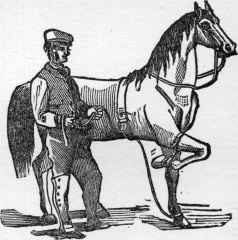
To Throw a Horse.
“To throw a horse, put a rope 12 feet long
around his body in a running noose, pass it down
to the right forefoot through a ring in a spancil,
then buckle up the left or near forefoot, take a
firm hold of your rope, lead him around until he
is tired, give him a shove with your shoulder, at
the same time drawing up the right foot, which
brings him on his knees, hold him steady, and
in a few moments he will lie down. Never at
tempt to hold him still, for the more he scuffles
the better.
“Take your colt into a tight room or pen,
and with a long whip commence snapping at his
hind leg, taking care not to hit above the hocks,
stopping immediately when he turns his head
towards you; while his head is towards you, ap
proach him with the left hand extended toward
him, holding your whip in the right, ready to
snap him as soon as he turns his head from you.
In this way you can soon get your hands upon
140 THE FRIEND OF ALL.
him. As soon as you have done this, be careful
to caress him for his obedience, and snap him
for his disobedience. In this way he will soon
learn that he is safest in your presence with his
head towards you, and in a very short time you
cannot keep him away from you. Speak kindly
and firmly to him, all the time caressing him,
calling by name, and saying, ‘ Ho, boy,’ or ‘ Ho,
Dan,’ or some familiar word that he will soon
learn.
“ If a colt is awkward and careless at first,
you must bear with him, remembering that we,
too, were awkward when young; allowing him
his own way, until by degrees he will come in. If
he is willful, you must then change your course
of treatment, by confining him in such a way
that he is powerless for harm until he submits.
If he is disposed to run, use my pole-check on
him ; if to kick, fasten a rope around his under
jaw, pass it through the collar and attach it to
his hind feet. In this way one kick will cure
him, as the force of the blow falls on his jaw. If
he should be stubborn, lay him down and con-
fine him until you subdue him, without punish
ing him with the whip.
“ Colts should be broken without blinds; after
they are well broken, then you may put them
on. Bridles without blinds are the best, unless
you want to speed your horse: then it will be
necessary to keep him from seeing the whip.
Colts should be well handled and taught to give
readily to the rein before they are hitched up.
If you hitch them up the first thing and they be
come frightened, then you have no control over
them ; but if you teach them to start, stop and
stand at the word before they are hitched, then
you can govern them.”
“Breaking” Horses.—The notion of “breaking”
a horse is disappearing. A few years ago, the
general feeling was, that a horse must be sub
dued, have his “will broken,” and be made to
understand, once for all if possible, that he must
implicitly obey. Under this system, resting im
mediately and undisguisedly on brute force,
the animal, its spirit broken, perhaps be
came an automaton, performing through fear
what resistance could not save him from. If he
tried to avoid a strange object that frightened
him, the whip, the spur and equally torturing
shouts were applied, and perhaps he succumbed,
and perhaps he didn’t. Sometimes the superior
force of the animal won, he became or was re
garded as vicious and tricky, and was sold from
hand to hand, till a horse fit for Gen. Grant to
ride or drive, sank to an omnibus or the towpath
of the canal. Mr. Rarey‘s success in training
horses brought into immediate notice a much
better way, and the increasing spirit of humanity
has carried forward what he was so prominent
in introducing. With horses as with men, the
great majority may be trained from higher im
pulses than mere fear, and may be brought to a
stage of cooperative confidence and helpfulness
impossible where mere brute force is the sole
appeal.
TRAINING THE COLT.
This process should commence from the very
period of weaning. The foal should be daily
handled, partially dressed, accustomed to the
halter, led about, and even tied up. The tracta-
bility, good temper and value of the horse de
pend greatly upon this. These offices should be
performed as much as possible by the man by
whom the colt is fed, and whose management
should be always kind and gentle. There is no
fault for which a servant should be discharged
so invariably or so promptly as cruelty, or even
harshness, toward young stock ; for the principle
on which their later usefulness is founded, is
early attachment to and confidence in man, and
the implicit obedience resulting principally from
these.
After the second winter, the work of training
may begin in earnest. He may first be bitted,
and with a bit smaller than usual, and that will
not hurt his mouth ; with this he maybe allowed
to amuse himself and to play, and to champ for
an hour on a few successive days.
If he is destined for farm or wagon work, por
tions of the harness may, after he has become a
little tractable, be put on him, and last of all the
blinds. Let his first trial be by the side of an
other horse, and before an empty wagon. Give
him an occasional pat or kind word; and in a
little while he will learn to pull, when a load may
be given him, and gradually increased.
When he begins a little to understand his busi
ness, backing, the most difficult part of his work,
may be taught him ; first to back well without
anything behind him, then with a light cart, and
afterwards with some definite load ; and taking
the greatest care not to seriously hurt the mouth.
If the first lesson causes much soreness of the
gums, the colt will not readily submit to a
second. If he has been rendered tractable be
fore by kind usage, time and patience will do all
that can be wished here. Blinding him may be
necessary with a restive and obstinate colt, but
should be used only as a last resort.
The same principles will apply to the training
of the horse for the road or the track. The
handling, and some portion of instruction, should
commence from the time of weaning. The
future tractability of the horse will much de
pend on this. At two and a half or three years
the regular proccss of training should come on.
HORSES AND THEIR MANAGEMENT.
141
If it be delayed until the animal is four years
old, his strength and obstinacy will be more
difficult to overcome. There should be much
more kindness and patience, and far less harsh
ness and cruelty, than are often exhibited, and a
great deal more attention to the form and natural
action of the horse. A headstall is put on the
colt, and a cavesson (or apparatus to confine and
pinch the nose) affixed to it, with long reins. He
is first accustomed to the rein, then led round a
ring on soft ground, and at length mounted and
taught his paces. Next to preserving the temper
and docility of the horse, there is nothing of so
much importance as to teach him every pace,
and every part of his duty, distinctly and tho
roughly. Each must constitute a separate and
sometimes long-continued lesson, and that taught
by a man who will never suffer his passion to
get the better of his discretion.
After the cavesson has been attached to the
headstall, and the long rein put on, the first
lesson is, to be quietly led about by the trainer,
a steady boy following behind, by occasional
threatening with the whip, but never by an
actual blow, to keep the colt up. When the
animal follows readily and quietly, he may be
taken to the ring, and walked round, right and
left, in a very small circle. Care should be taken
to teach him this pace thoroughly, never suffer
ing him to break into a trot. The boy with his
whip may here again be necessary, but not a single
blow should actually fall.
Becoming tolerably perfect in the walk, he
should be quickened to a trot, and kept steadily
at it; the whip of the boy, if needful, urging him
on, and the cavesson restraining him. These
lessons should be short. The pace should be
kept perfect and distinct in each ; and docility
and improvement rewarded with frequent ca
resses, and handfuls of corn. The length of the
rein may now be gradually increased, the pace
quickened, and the time extended, until the ani
mal becomes tractable in these his first lessons,
towards the conclusion of which, crupper-straps,
or something similar, may be attached to the
clothing. These, playing about the sides and
flanks, accustom him to the flapping of the coat
of the rider. The annoyance which they occa
sion will pass over in a day or two; for when the
animal finds that no harm comes to him on
account of these straps. he will cease to regard
them.
Next comes the bitting. The bit should be
large and smooth, and the reins should be
buckled to a ring on either side of the pad. The
reins should at first be slack, and very gradually
tightened. This will prepare for the more per
fect manner in which the head will be afterward
got into a proper position, when the colt is
accustomed to the saddle. Occasionally the
trainer should stand in front of the colt, take
hold of each side-rein near the mouth, and press
upon it, and thus begin to teach him to stop and
to back at the pressure of the rein, rewarding
every act of docility, and not being too eager to
punish occasional carelessness or waywardness.
The colt may now be taken into the road or
street to be gradually accustomed to objects
among which his services will be required.
Here, from fear or playfulness, a considerable
degree of starting and shying may be exhibited.
As little notice as possible should be taken of it.
The same or similar objects should be soon
passed again, but at a greater distance. If the
colt still shies, let the distance be farther in
creased, until he takes no notice of the object ;
then he may gradually be brought nearer to it,
and this will be usually effected without the
slightest difficulty; whereas, had there been an
attempt to force the animal close to it in the
first instance, the remembrance of the contest
would have been associated with the object,
and the habit of shying would have been es
tablished.
Hitherto, with a cool and patient trainer, the
whip may have been shown, but will scarcely
have been used ; the colt must now, however, be
accustomed to this necessary instrument of
authority. Let the trainer walk by the side of
the animal, and throw his right arm over his
back, holding the reins in his left, and occasion
ally quicken his pace, and, at the moment of
doing this, tap the horse with the whip in his
right hand, and at first very gently. The tap of
the whip and the quickening of the pace will
soon become associated together in the mind of
the animal. If necessary, the taps may gradu
ally fall a little heavier, and the feeling of pain
be the monitor of the necessity of increased
exertion. The lessons of reining-in and stop
ping, and backing on the pressure of the bit,
may continue to be practiced at the same time.
He may now be taught to bear the saddle.
Some little caution will be necessary at first
putting it on. The trainer should stand at the
head of the colt, patting him and engaging his
attention, while an assistant on the off-side
gently places the saddle on the animal‘s back,
and another on the other side slowly tightens
the girths. If he submits quietly to this, as he
generally will when the previous training has
been properly conducted, the operation of mount
ing may be attempted. The trainer will need
two assistants. He will remain at the colt‘s head,
patting and fondling him, while the rider will
put his foot into the stirrup and bear a little
weight on it, while the man on the off side
| presses equally on the other stirrup-leather; and
142
THE FRIEND OF ALL.
according to the docility of the animal, he will
gradually increase the weight until he balances
himself on the stirrup. If the colt be uneasy or
afraid, he should be spoken kindly to and patted,
or a mouthful of corn be given him ; but if he
offer serious resistance, the training must ter
minate for that day ; he may be in better humor
on the morrow.
When the rider has balanced himself for a
minute or two, he may gently throw his leg over,
and quietly seat himself in the saddle. The trainer
will then lead the animal round the ring, the
rider sitting perfectly still. After a few minutes
he will take the reins and handle them as gently
as possible, and guide the horse by the pressure
of them; patting him frequently, and especially
when he thinks of dismounting, and after hav
ing dismounted offering him a little corn. The
use of the rein in checking him, and of the
pressure of the leg and the touch of the heel
in quickening his pace, will soon be taught, and
the education will be nearly completed.
The horse having thus far submitted himself
to the trainer, these pattings and rewards must
be gradually diminished, and implicit obedience
mildly but firmly enforced. Severity will not
often be necessary; in the great majority of
cases it will be altogether uncalled for; but
should the animal waywardly dispute the order
of the trainer, he must at once be taught that
he is the servant, and must obey. The educa
tion of the horse is much like that of the child.
Pleasure is, as much as possible, associated with
the early lessons; but firmness or, if needed,
coercion must confirm the habit of obedience.
Tyranny and cruelty will, more speedily in the
horse than in the child, provoke the wish to dis
obey, and the resistance to command. The
restive and vicious horse is, in ninety-nine cases
out of a hundred, made so by ill-usage. None
but those who will take the trouble to try the
experiment are aware how absolute a command
a due admixture of firmness and kindness will
soon give over any horse.
The Check-Rein.—There has been great outcry
made against the use of this rein, here and also
in England, where it is called the bearing-rein.
Mr. Bergh has denounced its use vehemently,
and as President of the “ Society for the Preven
tion of Cruelty to Animals” has tried to force
its banishment. To check-rein a horse is said
to be equivalent to trussing a man’s head back
ward toward his back or heels, and compelling
him, while in this position, to do duty with a
loaded wheelbarrow. Mayhew says: “ For the
rapid motion of the head being impossible, it
cannot be used to restore the disturbed balance.
The nimbleness which could avoid sudden dan
ger is destroyed by the fashionable want of feel
ing. It is a matter for surprise that the presence
of the bearing-rein is never alluded to when gen
tlemen seek redress because their vehicles have
been damaged. Most horsemen, however, es
teem the neck for its appearance, and few com
prehend its utility.”
And Youatt: " The angles of the lips are fre
quently made sore or wounded by the smallness
or shortness of the snaffle, and by the unneces
sary and cruel tightness of the bearing-rein.
This rein not only gives the horse a grander ap
pearance in harness, and places the head in that
position in which the bit most powerfully presses
upon the jaw, but there is no possibility of driv
ing without it, unless the arm of the driver is as
strong as that of Hercules; and most certainly
there is no safety if it be not used. There are
few horses who will not bear, or bore upon some
thing, and it is better to let them bore upon
themselves than upon the arm of the driver.
Without this control, many of them would hang
their heads low and be disposed every moment
to stumble, and would defy all pulling, if they
tried to run away. There is, and can be, no ne
cessity, however, for using a bearing-rein so tight
as to cramp the muscles of the head, which is
indicated by the animal’s continually tossing up
his head : they may indeed be cramped to such
a degree, that the horse is scarcely able to bring
his head to the ground when turned to grass.
The tight rein injures and excoriates the angles
of the lips, and frequently brings on poll-evil.
Except it be a restive or determined horse,
there should be little more bearing upon the
mouth than is generally used in riding. This
the horse likes to feel, and it is necessary for
him in the swift gallop. We must have the bear
ing-rein, whatever some men of humanity may
say against it; but we need not use it cruelly.”
This seems to be the conclusion of common-
sense. Sentimentalists may condemn and de
nounce the check-rein. Now and then a horse gets
along without it. So “ reformers” occasionally
condemn and denounce the use by women of cor
sets or stays, and now and then a woman gets
along without them. In Greece and Rome per
haps neither device was used. But here and now,
in the great majority of instances, it is safer and
pleasanter to use a check-rein in driving.
THE TEETH.
A foal at birth has three molars, or grinding-
teeth, just through the gums, upon both sides
of the upper and of the lower jaws. It generally
has no incisors or front teeth; but the gums are
inflamed and evidently upon the eve of bursting.
The molars or grinders are, as yet, unflattened
or have not been rendered smooth by attrition.
HORSES AND THEIR MANAGEMENT. 143
The lower jaw, when the inferior margin is felt,
appears to be very thick, blunt and round.
A fortnight has rarely elapsed before the
membrane ruptures, and two pairs of front, very
white teeth begin to appear in the mouth. At
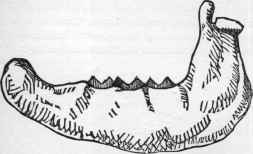
The Foal’s Jaw at Birth.
first, these new members look disproportionately
large to their tiny abiding-place ; and when con
trasted with the reddened gums at their base,
they have that pretty, pearly aspect which is the
common characteristic of the milk teeth in most
animals.
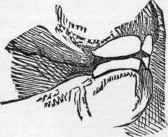
The Incisors at Two Weeks Old.
In another month, when the foal is six weeks
old, more teeth appear. Much of the swelling
at first present has softened down. The mem
brane, as time progresses, will lose much of its
scarlet hue. In the period which has elapsed
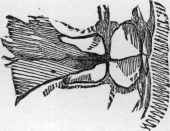
The Incisors at Six Weeks Old.
since the former teeth were looked at, the sense
of disproportionate size has gone. The two
front teeth are now fully up, and these are al
most of suitable proportions. When the two
pairs of lateral incisors first make their appear
ance, it is in such a shape as can imply no assur
ance of their future form. They resemble the
corner nippers, and do not suggest the smallest
likeness to the lateral incisors which they will
ultimately become.
There is now a long pause before more teeth
appear. The little one lives chiefly upon suction,
and runs by its mother‘s side. Upon the com
pletion of the first month, seldom earlier, it may
be observed to lower its head and nip the young
grass. From the third month, however, the
habit grows, until, by the sixth month, the grind
ers will be worn quite flat, and have been re
duced to the state suited to their function.
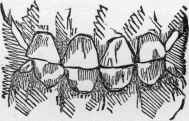
The Front Teeth at Nine Months Old.
The corner incisors come into the mouth about
the ninth month, the four pair of nippers, which
have been already traced, being at this time fully
developed. The corner incisors, which are de
picted as through the gums, do not yet meet,
though these organs point toward each other;
neither has the membrane of the mouth at this
time entirely lost the deepened hue of infancy.
From this date, however, the gums gradually
become pale, till, by the end of the first year, the
membrane has nearly assumed its normal com
plexion during the earlier period of existence.
All the incisors are, by the first birthday, well up.
The grinding teeth which are in the mouth
when the foal first sees the light are of a tempo
rary character. The jaw, therefore, has to hold
and to mature the long permanent grinders
which, within the substance of the bone, are
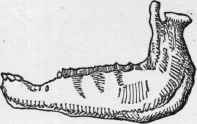
The Jaw of a One-year-old.
growing beneath the temporary molars. To
contain and to develop the large uncut teeth, be
fore appearing above the gums, causes the small
jaw of a diminutive foal to be disproportionately
thick, especially as compared with the same
structure in an adult horse.
At one year old, the first permanent tooth ap-
144 THE FRIEND OF ALL.
pears. This is the fourth molar, or the most
backward grinder in the engraving. The jaw
bone at one year old has become longer and
wider. This increase of size was necessary to
cover the increasing size of the new molar, and
to afford room for the partial development of
two other grinders, which will appear behind
what is now the last tooth. Often little nodules
of bone, without fangs, merely attached to the
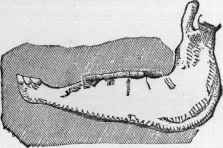
Jaw at Two Years Old.
gums, appear in front of each row of grinders.
These are vulgarly denominated “ Wolves’
Teeth.” They generally disappear with the
shedding of those members facing which they
are located.
The changes in the teeth, after the first year,
are characterized by the longer periods which
divide them. Months have, heretofore, separated
the advent of single pairs; but, from this date,
these appearances are to be reckoned by numbers
and by years. The foal has teeth sufficient to
support and to maintain its growth. Prepara
tion is being made for the advent of the sixth
grinder, and for changes in those milk molars
which were in the mouth when the animal was
born. At the same time, additional width is
needed to allow the permanent incisors to appear
when their time comes.
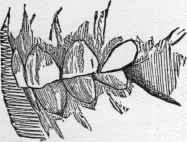
The Incisor Teeth at Two Years Old.
In the front teeth of a two-year-old, there is a
want of that fixedness which, one year before,
was characteristic of these organs. The central
nippers have done their duty, or, at all events,
something approaching to maturity has been at
tained.
Three years old is the period when the greater
number of colts are brought to market. The
bit then is put into its mouth, and it is driven
from the field. At a period of change and of
debility it is expected to display the greatest ani
mation, and to learn strange things. When its
gums are inflamed ; when the system is excited ;
when the strength is absorbed by an almost si
multaneous appearance of twelve teeth, it is led
from the pasture and made, with its bleeding
jaws, to masticate sharp oats and fibrous hay.
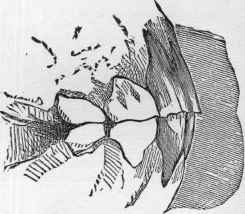
The Incisors denote no more than Three Years Old.
It has been said that a three-year-old colt cuts
twelve teeth. The engraving represents half the
lower jaw of an animal of that age. Those or
gans which are of recent appearance will be
recognized by their darker color, by their larger
size, or by their differing in shape from the other
members. These new teeth are a central inci
sor and the first two grinders. The horse has
two jaws and two sides to each jaw; therefore
the same number being present within each side
of both jaws, the teeth already alluded to appear
during the third year. However, even this quan
tity rather understates than overrates the fact, for
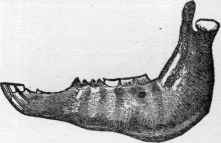
Jaw of a Three-year-old.
frequently the tushes are cut during this period;
in such a case, the colt acquires no less than six
teen teeth in twelve months.
The four year-old has to perfect as many teeth
as are known to protrude into the mouth of the
three-year-old. But the precise time of the ap
pearance of the tushes is uncertain. They may
come up at the third or the fourth year; some
HORSES AND THEIR MANAGEMENT.
140
times they never pierce the gums, it being very
far from uncommon to see horses’ mouths of
seven years without the tushes.
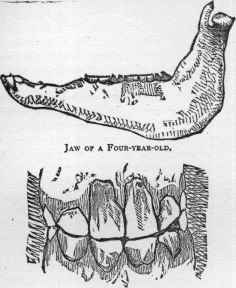
One Lower Lateral Incisor being through the Gum
declares a four-vear-old.

These Teeth equally declare only Four Years Old.
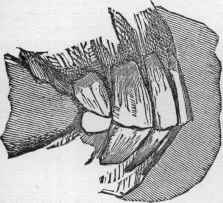
FIVE-YEAR OLD.
One upper corner permanent incisor has been cut. The lower
corner milk incisor is still retained.
By the end of the fourth year, the colt has
certainly gained twelve teeth ; by this time there
should exist, on each side of both jaws, one new
lateral incisor and two fresh molars, being the
third and the sixth in position. The appearance
2o
of the mouth now indicates the approach of ma
turity ; but the inferior margin of the lower bone
still feels more full and rounded than is consis-
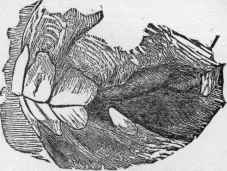
SIX YEARS OLD.
tent with the consolidation of an osseous struc
ture.
The process of dentition is not finished by the
termination of the fourth year. There are more
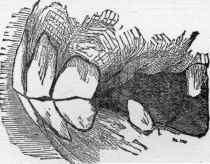
SEVEN YEARS OLD.
teeth to be cut, as well as the fangs of those al
ready in the mouth to be made perfect.
The colt with four pairs of permanent incisors
has still the corner milk nippers to shed; yet,
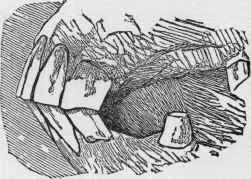
EIGHT YEARS OLD.
while the provision necessary for that labor is
taking place within the body, or while nature is
preparing for the coming struggle, man considers
the poor quadruped as fully developed and as
enjoying the prime of its existence.
146
THE FRIEND OF ALL.
The teeth may be scarcely visible in the
mouth, nevertheless such a sign announces the
fifth year to be attained. There are, at five, no
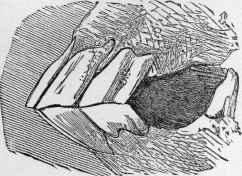
TWELVE YEARS OLD.
more bothering teeth to cut. All are through
the bone, and the mouth will soon be sound.
The indications of extreme age are always
present, and though during a period of senility
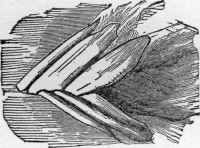
TWENTY YEARS OLD.
the teeth cannot be literally construed, never
theless it should be impossible to look upon
the “ venerable steed " as an animal in its colt-
hood.
No man can accurately interpret the signs of
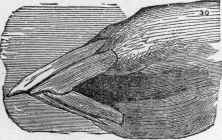
THIRTY YEARS OLD.
the teeth after the fifth year. A guess, more or
less correct, can be hazarded; but nothing like
confident judgment can be pronounced.
SHOEING.
Rarey’s Directions.—“ There are very few black
smiths that ever once think what a complicated
piece of machinery the foot of a horse is, and by
one careless blow they frequently stop the work
ing of this machine. The majority of smiths, as
soon as they pick up a horse‘s foot, go to work
paring the heel, from the fact that it is the most
convenient part of the foot, and therefore destroy
the heel and braces of the foot, causing, in many
instances, contracted heels. The heels of a horse
should be well kept up, and the toe down. By
lowering the heels you throw the entire weight
of your horse upon the back tendon of the legs,
and thereby produce lameness from overtaxing a
very important set of tendons. By keeping up
the heel you throw the weight upon the wall of
the foot. In this position you prevent stum
bling, clicking, etc. Next the shoer commences
to pare away the sole, and thins it down until he
can feel it spring with his thumb. Ask him why
he does this, and he gives you no reason, except
from custom. Next come the bars or braces of
the foot, they are smoothed down; next in his
ruinous course come the frogs of the feet, they
are subjected to the same cutting and smoothing
process. All the cutting, paring and smoothing
of the soles, bars or frogs is a decided injury to
the horse as well as to the owner. All the corns
in the land are produced by this process of par
ing. The frogs have been placed in the foot by
nature to expand the wall of the foot, and as soon
as you commence to cut one, the oily substance
begins to leak out, dries up, becomes hard, losing
its oily substance, and makes the wall hard and
dry, inducing it to crack.
“The nerves of the feet are very sensitive, and
smiths should be careful not to prick the feet,
as it requires quite a time to relieve them. The
foot is a very complicated piece of machinery,
and if you keep a horse well shod and his
foot in good condition, you can then generally
manage the balance. The feet suffer from being
kept too dry. Horses that stand on board floors
should have their feet wet every day, or there
should be a vat five inches deep, five feet long,
and three wide, filled with water and clay, in
which each horse can stand for one hour per
week, unless his feet are feverish, then he should
be kept it in an hour per day, or until the fever
subsides.
“ Another source of injury to horses’ feet, is
the habit of patronizing cheap blacksmiths. If
a man can drive a nail, he then sets up a sign as
a farrier or a veterinary surgeon, when in fact he
knows nothing of the anatomy of the horse‘s
foot; not having spent any time or money in
acquiring the necessary information, he can
HORSES AND THEIR MANAGEMENT. 147
afford to shoe a few shillings cheaper than a
well-informed man, but the patrons of such cheap
shoeing are generally the sufferers. All horse-
shoers should be well-skilled veterinary sur
geons, or there should be a skillful surgeon at
tached to every shop.
“Another source of poor shoeing and injury
is the loss of elasticity of the frog, which refuses
to perform its proper functions; the heel con
tracts, the foot rolls, and you have a sore horse
for the ten or twelve months required to relieve
a horse’s suffering from being badly shod. The
first thing that touches the road or the floor of
the stall, should be the frog, and the wall of the
foot should be kept cut so as not to prevent it
from touching at every step; and no man that
owns a horse should ever allow a blacksmith to
cut the soles, bars or frogs of his horse‘s feet.
Nature has adapted the frogs to all description
of roads, climates and weather, without being
pared. So many horses have been ruined by
this process of paring, that there are now several
establishments in this country that manufacture
India-rubber pads, thinking thereby to supply the
wasted frog and the elasticity of the natural foot.
The frog is insensible to pressure, and you may
place the whole weight of your horse on the
frog and he will suffer no inconvenience. This
is the only reliable way to cure contracted feet;
by throwing the weight upon the frog, you force
them up between the walls ; they act as a wedge,
and soon relieve the contracted feet.
“Smiths should never have their shoes hot
when fitting them, as the application of hot iron
extracts the oily substance from the hoof. The
amount of cruel pnnishment inflicted on horses
by cross-grain blacksmiths, is another source of
poor shoeing. As soon as the horse does not
stand the smith gets angry, and commences
whipping and jerking the animal, which only
adds terror to it, so that he soon refuses to go to
the shop if he can avoid it; it is natural for
horses to dislike to be shod, because the ham
mering shocks the nervous system, until they
are accustomed to it. He should be taught to
stand, and his feet well handled at home, before
he is ever brought to the shop by the owner.
You then save the horse pounding, and the smith
an immense amount of labor that he never gets
any pay for, for no man ever thinks of paying
anything extra for shoeing a bad horse. The
wall of the foot should never be rasped above
the nail-holes, and as little below the clenches
as possible; all the rasping and filing but tends
to thin and weaken the wall by cutting the fibers
of the foot. The nails should be countersunk into
the shoe, so that there will be no chance for the
clenches to rise. No horse interferes with the
heel or toe; it is always the side of the foot.
The habit of turning the inside of the shoe un
der causes a number of horses to interfere, that
would not if they were shod straight in the in
side. Spread the heels as wide as possible; set
the outside a little under ; keep the toes full.
For clicking horses, raise the heels high, cut the
toes short. For speedy cuts, place your toe-
corks a quarter of an inch to the inside of the
center of your shoe; keep the heels wide apart.
For corns, put on a shoe with a prong, for the
main rim, so as to cover the entire frog, pare the
wall lower than the frog, so that the entire weight
will be thrown on the frog. Have the inner
cork not quite so sharp as the outer one, so that
if he steps upon the other foot, he will not cut
it; make the shoes as light as possible consis
tently with good service, as they are ordinarily
made just about one third too heavy.”
Shoeing a horse is understood to signify fasten
ing a piece of iron to the horn which envelops
the foot of the animal. Such an operation ap
pears to be a simple affair; but there is no sub
ject associated with veterinary science on which
more research has been expended, about which
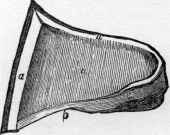
Diagram illustrative of the Different Kinds of Horn
composing the Horse‘s Hoof.
a a. The wall. The outer dark portion is called the crust of the
wall, and the light-colored, soft, inner horn is thrown into the
laminae, or thin leaves, whereby it gains extent of attachment
to its secreting membrane.
b. The light-colored and yielding horn of the sole.
c. The tinted but elastic horn of the frog.
more bitter discussion has been indulged, or with
regard to which proprietors and practitioners are
more at variance. Certainly no matter can pos
sibly be more intimately connected with the suf
ferings and the comforts of the equine race. The
arrangement of the nails near to the outer edge,
and the fixing of them into the hard outer wall
of the crust, are methods still followed, though
experience has demonstrated that such numerous
bodies, driven almost perpendicularly into a thin
and a brittle substance, are better calculated to
break the hoof than likely to hold on that which
it is their office to retain.
No other mode of driving the nails is at pre
sent in general practice; though the modern vet
erinary surgeon recognizes all the evils which
attend the habit, yet these evils he contentedly
continues to class as diseases.
148
THE FRIEND OF ALL.
Structure of the Hoof.—The wall of the foot is so
much horn as can be seen when the hoof rests
upon the ground, and when it is viewed either
from the front or from the sides. This wall is
supplied from two sources. The coronet, or the
prominence to be seen immediately above the
hoof, secretes the outer layer of horn, which is
the darkest, is very much the hardest, and is the
most brittle of all the constituents of the hoof.
The laminæ, or the highly-sensitive covering of
the internal foot, secrete the inward layer of
horn, which is soft, tough and devoid of color.


False Quarter, or a De
ficiency of the Outer
Wall.
The Only Possible Re
lief for False Quar
ter.
These two opposite and distinct secretions are
joined together, forming one body. The inti
mate union of opposite properties endues the
substance thus compounded with the character
istics of both. The hard, outward horn is
needed to protect the foot against stones and
rocks. The internal, white horn, being fastened
upon this substance, acts as a corrective to its
harsh nature, preventing it from breaking, split
ting and chipping, which it else must have done
under the weight it was destined to sustain, and
when fulfilling the purposes of the horse‘s hoof.

Section of a Horse’s
Foot affected with
Seedy Toe.

A Foot with Sandcrack.
Mischief from Separation.—When these two kinds
of horn are separated, the division is known as
false quarter, and as seedy toe ; and the foot is
recognized as weakened when such a want of
union is discovered. The outer, dark-colored
horn becomes more brittle; the white, internal
horn grows more soft for the want of that junc
tion by means of which each communicated its
attributes to the other. So also when the two
descriptions of horn, although united, cease to
influence one another, this condition is a morbid
alteration, known as a changed state of hoof.
Thus, when a sandcrack is visible, or the wall
divides from the ground surface to the coronet.
the foot’s incasement is recognized as un
healthy; but in the forge, the application of such
facts is, by many smiths, utterly ignored.
The Arab Method.—The Arab takes advantage
of the united properties of the horn. In
warm countries the horse’s hoof grows strong
and thick, and he allows the wall to descend
half an inch below the sole, and right through
this portion of projecting hoof he drives the
nails which secure the shoe. Thus he does not
injure the foot by the insertion of foreign bodies
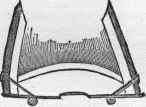
The Mode of fastening the Arabian Shoe to the Hoof of
the Horse.
through its more brittle substance, and he se
cures the united resistance and tough qualities of
the complex covering of the foot.
The Usual Method.—But the average blacksmith
here, on the contrary, by ranging the holes for
the fastenings round the edge of the shoe, drives
the nails only into the harder kind of horn, and
transfixes the crust for a considerable distance.
The nail is meant to pierce only the black or
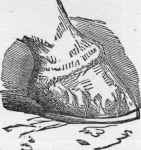
Fractured Condition of the Horn, consequent upon driving
Nails through the Brittle Outer Crust of the Wall.
outward substance of the wall. This may, seem
ingly, afford the better hold ; but it is a more
dangerous one. There is, likewise, the peril of
pricking the sensitive foot, should the nail turn
a little to one side, as not unfrequently happens.
Another danger is that which the forge calls
driving a nail “too fine,” forcing it near the
white horn rather than sending it directly
through the center of the narrow dark crust.
There is a third peril. Horses, with thin walls,
present difficulties. The smith is afraid of
either pricking the foot or driving the nail “ too
fine;” should this accident ensue, the nail will,
HORSES AND THEIR MANAGEMENT. 149
upon the animal being worked, bulge inward, and
provoke acute lameness, often causing pus to be
generated. To avoid these evils, he points his
nails outward; and, by so doing, not unseldom
induces the harsh outer crust to crack, to split
up or to chip off. To such an extent does this
sometimes happen, that the smith is puzzled to
find a place where a nail will hold.
It is a common thing to hear veterinary sur
geons attribute to the operation of shoeing all
the evils by which the hoof is affected. They
assert that a colt invariably has an open, healthy
foot, until it is shod ; but, from the day upon
which the animal enters the forge, the horn be
gins to be irregularly secreted, and the hoof to
grow misshapen.
The worst evil which results from a shoe be
coming partially released is not the inconve
nience it occasions the rider, nor fracture, often
produced, on the hoof of the animal. Some
portion of the horn first yields. This mishap
throws greater stress upon the remaining fasten-
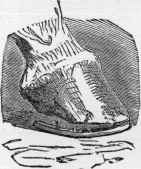
The Shoe partially breaks from the Insecure Fastenings,
and one of the nails, sticking up, pierces the sole of the
Foot.
ings. The shoe becomes loose. The majority
of the nails give way, but one may continue
firm. The shoe is fastened as by a pivot, and
with every step swings from side to side. The
released nails stick upward—the earth or road
way, as well as the clinches, preventing these
from leaving their places. When the foot is in
the air, the shoe hangs suspended. When the
foot is placed upon the ground, it may be im
paled upon the nails that protrude upward. The
shoe gets under the foot. The blunt and jagged
points are, by the weight of the quadruped,
forced through the soft sole or frog at the
bottom of the hoof; and a dangerous wound is
inflicted, the uneven metal being often driven for
some distance into the body of the coffin-bone.
It is objected to the Arabian method, that if
the hoof be permitted to grow, the elongation of
the horn at the toe and its non-removal by the
knife would occasion this portion of the foot to
protrude. What the writer contemplates is,
moderating the smith’s employment of the
drawing-knife and of the rasp, and enforcing
some caution in the application of the red-hot
iron, when burning a seat for the shoe. Why
need the wall be always cut away till it is level
with the horny sole? Why bring this last por
tion of the pedal covering, which is naturally
soft and yielding, on a line with that part of the
crust which is imbued with a power of resist
ance ? Nay, the harder wall is protected by the
shoe on which it rests; while the softer sole is
brought near to the ground, being left exposed to
an injury, which the lesion known as bruise of
the sole proves not unfrequently to happen.
The sole being thus exposed close to the
earth, is the fruitful source of many “accidents.”
The soft horn being brought so low, is rendered
constantly wet. The consequence is a harshness
of texture, opposed to the evident intent of na
ture. This harshness is one of the most com
mon sources of corns. The edge of the sole rests
upon the web of the shoe—the descent of the
coffin-bone, being unable to play upon a yielding
sole, squeezes the flesh between the inferior sur
face of the bone and the upper surface of the
shoe. This is acknowledged as the principal
source of corns. Stones and other rubbish often
become impacted between the horny sole and
the shoe. In this situation, the foreign sub
stances are retained firmly and provoke acute
lameness.
The shape of the horse’s sole, its yielding cha-
acter, and its position immediately under the
coffin-bone, all should be accepted as proofs that
it is of service in supporting the weight of the
body. It proves nothing to assert that if the
sole is removed, the pedal bone will not fall
down. The burden may repose upon the num
erous laminae and upon the bulging rim of the
coronet, as well as drag upon the lateral car
tilages. Here is sufficient material to uphold
even a greater load ; but can such a force be ar
bitrarily imposed without provoking nature‘s
resentment ? The parts here named are the
very regions which are the common seats of foot-
disease. Ossified cartilages, irregular secretion
of coronary horn, and laminitis, in the acute or in
the chronic form, are very common to stables;
so also is navicular disease, which the trimming
of the frog is also likely to induce.
To rectify such evils, it is proposed that half
an inch of crust should be allowed to protrude
below a sole of moderate thickness. That all
idea of breadth of shoe affording the slightest
protection be at once abolished; because the
broad web has been proved rather to afford
harbor to hurtful matter than to protect the
sole from injury. That the shoe be made only
just wide enough to afford bearing to the wall
150 THE FRIEND OF ALL.
of the hoof, and to allow sufficient room for the
nail-holes to pierce the substance of the iron.
The crust was designed to sustain the weight of
the animal’s body, and the most ignorant smith
would not think of permitting the entire burden
to bear upon the sole. A space large enough to
give room for the nails and to provide an ample
rest for the wall of the hoof is all that can be of
use; and, being so, all additional width only ren
ders the shoe of an unnecessary weight. Ac-
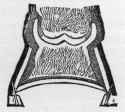
Proposed Mode of Nailing.
cording to this plan, the hold would be much
firmer, embracing the two kinds of horn which
nature ordained should unite to form the wall of
the hoof. A simple puncture is made through
all the substance, which, as the opening made is
filled with metal, can hardly produce weakness in
the structure. The smith usually drives the nail
perpendicularly, not through the wall of the hoof,
but into its outward investing envelope, or into a
material particularly harsh and resentful of inter
ference—thus separating the fibers of the horn,
destroying its integrity, and, of course, weaken
ing its capability of sustaining violence.
Calks.—These as usually made and attached to
the shoes of the horse, are positive abominations.
The shoe, in the first instance, is forged too long
for the foot, when, the extra length of iron being
bent downward, a calk is established. Such
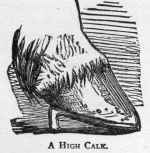
an arrangement throws the entire bearing for
ward, where it already strongly presses. Al
though contraction of the tendons is mostly con
fined to workhorses, and this constrained posi
tion of the foot must favor such an affection,
nevertheless the smith may receive it as an un
just accusation when he is told that high calks
are to blame for the spread of such a state of
disease.
The Slipper-Shoe.—To obviate these dangers the
following form of shoe has been devised. Its
principal peculiarity is the long strip of metal
which rises above the upper surface and conceals
about three quarters of an inch of the toe. This
is not an enlarged kind of clip, but a hollow re
ceptacle, which projects above the shoe and
covers part of the hoof. The toe is sheltered
within the shallow cavity, whose purpose is to
afford the stay which the clip imperfectly pro
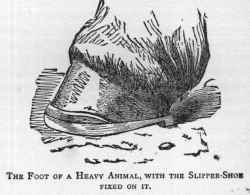
vides at the expense of the horn’s destruction.
When the fore portion of the foot is being dug
into the earth, this provision, while it allows the
hoof to be employed in its integrity, will prevent
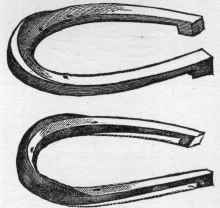
A Light Shoe. Showing the Manner in which Calks may be
FORMED WITHOUT ANY INCREASE OF WEIGHT.
The diagram exhibits the Slipper-shoe, as suited for different
breeds of animals; also shows the sameness in both kinds of
manufacture.
all the stress being transferred to the nails, and
thus hinder the clinches being loosened.
The shoe has no web. It consists of a piece
of iron the breadth of which is merely sufficient
to afford a secure lodgment for the crust. It
possesses true calks, but their existence does not
interfere with the level of the upper surface on
which the foot rests. The shoe is forged of one
thickness from toe to heel; and a portion of
HORSES AND THEIR MANAGEMENT. 151
metal under each quarter being removed, leaves
the calk, which thus only serves to maintain the
evenness of the bearing.
Shoes are generally fullered, or have a hollow
space, narrow but long, near the outer margin.
In this empty void or groove the heads of the
nails are received; but as the substance in front
is ground down by wear, of course the duration
of the shoe must be shortened in proportion to
the depth of the fullering.
By the next illustration, which represents the
ground surface, the reader will perceive an in
dented void near to the outer margin. Behind
this indentation or fullered cavity the iron gra
dually slopes away so that the substance which is
exposed to wear, and on which the horse must
travel, consists of the narrow strip that extends
round the outward edge of the shoe.
The proposed shoe contemplates iron of an
equal thickness at every point usually exposed
to wear. The nails are driven into holes made
to fit close around the heads of those fastenings,
so that the shoe being fixed, no loss of substance
is to be detected ; for the nail-heads fill the spaces
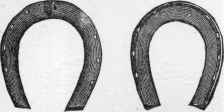
A Shoe with the Nails A Fullered Shoe.
Countersunk. (Ground surface.)
(Ground surface.)
which were countersunk for their admission.
The nails pierce the toe of the proposed new
shoe. This part is selected, because this portion
of hoof is covered with the thicker horn ; there
fore is indicated as the region where all stress
should bear. Among smiths, there is a strong
objection to driving nails in the center of the
wall. Yet a more violent outrage is inflicted by
actually removing a portion of its substance, so
as to make an abiding-place for a clip, than by
piercing obliquely the strongest part of the hoof,
subsequent to the toe having grown below the
true foot. The thickness of wall there offers
several advantages, when considering the reten
tion of nails. The solidity of the secretion is a
proof that this portion of the hoof is not endowed
with motion. Consequently, when fastening a
piece of iron to it, we are not fearful of interfer
ing with the exercise of a healthful function.
Such would be the case if the nails were to fix
the quarters, where the joint thinness, moisture
and elasticity of the horn afford the best evidence
nature meant them for expansion and con
traction.
Slippery Weather.—Some person, many years ago,
proposed to use nails with large steel sharp-
pointed heads, during the prevalence of frost.
This plan was tried, and signally failed. The
constant renewal of the nails was found ruinous
to the hoof; for the strongest of the projecting
heads was unable to resist the grinding action of
a horse‘s foot longer than twenty-four hours.
Then, many of the heads broke off while being

A Shoe intended to enable a Horse to work in Ice,
WHICH IS FIXED ON TO THE FOOT WITH SHARP-HEADED AND
Projecting Nails.
driven, and not a few were fixed in a damaged
condition, owing to the blows received from the
heavy hammer of the smith.
The second cut illustrates another plan. Large
holes, containing the thread of a female screw,
are made through the heels of the winter shoes,
and several steel points, manufactured with a
male screw, adapted to the dimensions of the
holes just mentioned. Whenever the roads are
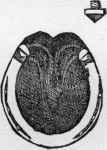
A Shoe with Points which Screw on and off, designed to
fit a Horse for Work during Frosty Weather.
icy, all that is requisite a boy might perform.
The hole in the shoe has to be cleared out, and
afterward one of the points screwed into the
opening. When these points are worn down,
they are easily renewed.
Paring the Foot too small.—Sometimes a smith
pares and rasps the horse‘s foot, to make it fit a
shoe he has, instead of making the shoe fit the
foot. The result is worse than that of tight
shoes on the human foot. The walk is strange,
as though the poor creature were trying to pro
152 THE FRIEND OF ALL.
gress, but could obtain no bearing for its tread.
The legs are all abroad, and the hoofs no sooner
touch the ground than they are snatched up
again. The head is carried high, and the coun-
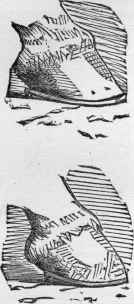
A Foot properly shod, and a Foot which has been cruelly
RASPED, TO MAKE THE HOOF SUIT A SHOE THAT WAS TOO
SMALL FOR IT.
tenance denotes suffering. It is months before
the horn is restored to its normal condition.
Cutting, or Interfering.—This is an annoying
fault in a horse, and when the cutting takes
place near the knee may become dangerous.
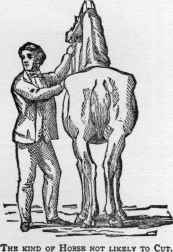
Weakly, long-legged and narrow-chested horses
are apt to cut, as are creatures with cow-hocks.
Many young horses strike in going; but they
lose the habit as age matures the strength.
Sometimes a ring of India-rubber has been em.
ployed as a protection against this annoyance;
but it is not calculated to realize any practical
expectation. Some horses will only cut during
the latter portion of a long journey, or when
thoroughly exhausted. Others are afflicted with
a chronic description of weakness, and such ani
mals may cut with the first step. These creatures
require less work or entire rest, with a course of
tonics, both in food and medicine.
The horse which exhibits a wide chest, and
stands with the feet not too close together,
very rarely cuts. The animal which possesses
well-made haunches with prominent hips and
swelling thighs, that appear full, round and
fleshy, especially when such a creature places the
fetlocks under the hocks, must be driven very
far and pushed very hard before he will interfere.
Boots are employed a great deal to prevent cut
ting. A form of one is here given, made of pre-
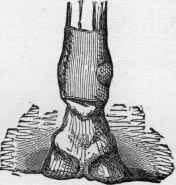
A Leathern Boot.
pared horse-skin having the hair on, and laced
upon the member. Over the seat of injury a
concave piece of stout leather is let into the co
vering, and the hollow thus formed, which acts as
a protection, can also receive a portion of lint
saturated in the lotion, prepared by adding one
grain of chloride of zinc to an ounce of water.
Thus, while the sore is spared a renewal of the
cause, curative treatment is not stayed.
The forms and positions of these boots make
a curious sight for an observer “ down the road,”
or on the racetrack. Sometimes each leg of a
horse will be decorated by them. They are often
worse than unnecessary, and put on to give the
horse a tony look.
But many horsekeepers do not favor the use
of boots at all, but simply rub any part which has
been hit, with axle-grease or vaseline.
We are indebted to the courtesy of Dr. L. W.
Warner, 67 Murray Street, New York, for the
following diagram, and also for the one to be
found at the head of “ Diseases.”
HORSES AND THEIR MANAGEMENT, 153
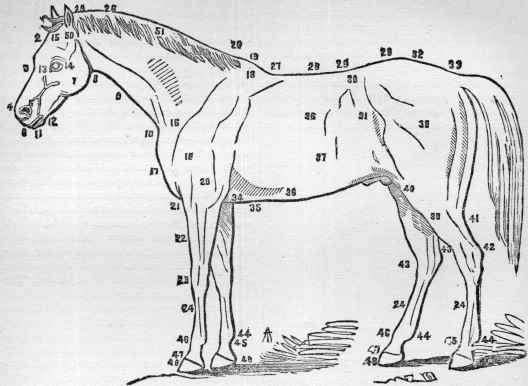
Points in a Horse.
1. Forehand,
2. Forehead.
3. Face.
4. Nose,
5. Wings of the nose.
6. Muzzle.
7. Jaw.
8. Throat.
9. Windpipe, or Trapple.
10. Point of the shoulder.
11. Chin.
12. Curb of the chin.
13. Outer corner of the eye.
14. Inner corner of the eye.
15. Foretop.
16. Neck.
17. Breast.
18. Shoulder.
19. Withers.
2o. Arm.
21. Forearm.
22. Forelegs.
23. Knee.
24. Cannon-bones.
25. Nape.
26. Crest.
27. Middle-hand.
28. Back.
29. Backhand.
30. Loin.
31. Hip.
32. Croup, or Rump.
33. Dock.
34. Elbow.
35. Girth.
36. Barrel (the Ribs).
37. Flank.
38. Quarter.
39. Thigh.
40. Stifle.
41. Hamstring.
42. Point of the hock,
43. Hocks.
44. Fetlocks.
45. Small Pasterns.
46. Large Pasterns.
47. Crown of the hoof,
48. Hoof.
49. Heels.
50. Head.
51. Mane, or Mane Hair.
POINTS.
Stem and Rudder.—The skeleton is the frame
work of the trunk and limbs. The vertebræ con
stitute the base, toward which the other bones
concentrate, or from which they originate. At
one end of the backbone is the skull; at the
other extremity, the tail. The arrangement ac
cords with the system observed in a well-regu
lated vessel. The lookout stands forward ; with
the steersman at the stern. The tail, in the
quadruped, principally directs the course. We
perceive the folly of those people who excise
or mutilate so important a part. The animal,
gazing in the desired direction, inclines the
body toward that point; while the tail, simul
taneously moved in an opposite course, sways
the trunk into the proper track. The flowing
hair, operated npon by the wind, gently favors
the inclination. The reader will comprehend the
reason why a short tail is rarely compatible with
perfect safety. The appendage which men
regard as chiefly of service to switch away the
flies, has a higher and more important function.
The turning or guiding power having been
pointed out, the attention must next be directed
to the region where all strength centers, and
from which all ability for motion proceeds.
The Lumbar Region.—Looking down upon the
spine of a horse, one cannot but notice that the
widest portion of the body is across the hip-bones.
The posterior parts, or those behind the projec
tions, are not of uniform size; but they are more
bulky and more fleshy than the forward surfaces
of the body. Flesh is another term for muscle;
where flesh is most conspicuous, there is
most strength. The muscles of the hind limbs
spring from a large bone, variously named the
haunch bone or the pelvic-bone. This bone
joins the spine at the hips, and thus lends sup
port to the posterior region. But the vertebræ,
immediately before the hips, are aided by no
154
THE FRIEND OF ALL.
such accessory. The loins stand alone, entirely
without support. This part of the body consists
merely of certain bones, over which and under
which run thick layers or solid masses of muscu
lar fiber.
A comprehension of the osseous weakness ap
parent in the skeleton of the loins must show
the absolute necessity for some compensating
agency. The loins should be bulky or muscular.
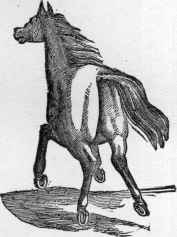
The Special Use of the Head, Mane and Tail, when em
ployed TOGETHER.
They cannot be too large; but may be too small.
Small weakly loins admit of no compensation.
The position of the part is peculiar. It is inter
mediate and lies between the haunches, which
are the propelling powers, and the thorax, which
is formed to endure, to support or to uphold
what the back carries. All intermediate struc
tures demand strength; because their office is
simply to transmit that impetus they directly
receive. Accordingly, the development of the
loins, both in man and in horse, may be taken as
the best proof of vital power. The loins receive
and convey onward the propelling force of the

The Back of the Horse, as seen from above.
quarters. When the body is suddenly checked,
they have to overcome the energy of the onward
impetus, to endure the full violence of the sud
den arrest of the forward motion in both the
animal and its burden. In leaping, galloping,
etc., the position of the region and the duties
involved by it are obvious. Muscular loins are
imperative in racers and in saddle-horses ; it is
impossible the rider should be safely carried un
less the back be strong. The animal designed
for light harness purposes can, perhaps, best
dispense with such an essential although even
then weak loins are usually associated with a
narrow chest, a lanky frame, and a total lack of
endurance. Whether for strength or appear
ance, speed or endurance, breadth of loins is al
ways essential. There is no property for the
possession of which the quadruped can be valued
that is not dependent upon this portion of the
frame for its exhibition.
The Back.—The backbone of the horse, lumbar
bones and all, is often remarkable for very op
posite developments. These are sinking down
or curving inward, and rising up or arching out
ward. When the line declines more than usual,
the form is denominated a “ hollow back” or a
“ saddle back,” and is generally supposed to be
indicative of dorsal debility. Animals of such a
formation, however, are commonly possessed of
high crests, full loins, as well as lofty haunches,
and they generally exhibit proud action. They
are usually conspicuous for many estimable
qualities. They are generally very docile, and
uncommonly good-tempered. They display nu
merous excellent points; and sometimes exhibit
such prominent good qualities as in many occu
pations may be justly esteemed more than an
equivalent for their bodily deficiency.
Neither a long nor a short backed horse is,
necessarily, desirable. All depends upon the
strength of those muscles which support the
spine; though, other points being equal, length
generally provides a springy seat for the saddle:
whereas a short back commonly possesses
greater endurance. A long back, with bulging
loins, is, however, infinitely preferable to a short
back with deficient lumbar muscles. The mere
extent of a part can be no absolute proof in either
direction; though, should a choice lie between
two animals, each equally deficient or equally
favored, the short back should be preferred, be
cause all increase of length necessitates a greater
strain upon the organs of support.
The Tail is a continuation from the
vertebræ. Therefore there is reason
why a stout dock or a thick root to the
tail should be regarded as a sign of excel
lence ; because the part affords some evi
dence concerning the stoutness and muscularity
of the spine itself. Nevertheless, it allows of
nothing stronger than an inference. But the
position of the tail affords more than an infer
ence. It should originate level with the pro
longed line of the back, and should look the
thing it is, a continuation of the spine ; for, so
placed, it means a greater length in the posterior
muscles of the haunch, some of which extend
from the last bone of the vertebræ almost to the
hock. In a body whose power is dependent on
contractility, of course length of substance favors
HORSES AND THEIR MANAGEMENT. 155
the ability to shorten or to contract. Animals
with tails “ well set on " are commonly remarkable
for speed and activity. The Arab naturally car
ries his tail erect; and by the rapidity of its mo
tions, together with the power of the organ, an
explanation is afforded of the ease and the grace
with which this breed of horses can perform the
most difficult evolutions. The tail of the tho
roughbred, by its position and its graceful car
riage, reveals its lineage. The reader will be
surprised to notice how seldom horses have tails
well set on. In short, the position of the tail, if
employed as a test for excellence, would con
demn the majority of quadrupeds. But the tail
should be examined, not as an absolute proof of
properties, but as suggestive of breed.
The Head.—The course of the body is greatly
governed by the position of the head. The bit,
operating upon a natural mouth, can sway the
body during the highest speed ; for by the incli
nation of the head is the trunk to be turned. It
is imperative, for the ease and safety of the rider
or driver, that the head should be well set on, and
carried without sensible restriction. If the rein is
held too tight and a false step is made, or if the
foot is placed upon a rolling stone, the quadru
ped is almost certain to fall; for the rapid
motion of the head being impossible, it cannot
be used to restore the disturbed balance. Bulk
indicates muscle; therefore a neck, if properly
shaped, cannot be too thick ; the majority of the
cervical motor agents extend either to the trunk
or to the forelimbs. The size of the neck, con
sequently, influences other regions, and confers
positive advantage of both strength and activity.
A head well set on is carried in advance of the
body only so far as may be necessary to counter
act the comparative lightness of the forward
structures.
The Neck.—Thinness and smallness of neck is
one of the peculiar features of emaciation in the
horse. It is always seen in the old and in the
half-starved quadruped. It is never a sign of
vigor. The illustration exhibits a peculiarity of
form confined to the heavier breed of draught-
horses. Such a neck is alone compatible with
slowness. It is, however, falsely imagined to de
note excessive strength. So far as thickness is
concerned, muscle must be present, or adipose
tissue must abound ; but there is a deficiency of
length which will necessarily limit the motor
power. The huge mountains of flesh which pa
rade the streets of London before the brewers’
drays, are not remarkable for power of draught,
capability of endurance, or for long life.
The ewe-necked horse is one in which every
appearance of crest is absent. Such a form may
possess length ; but it is generally wanting both
in depth and in substance. Animals of this
formation are generally active, but weakly: other
parts are too often characterized by a narrowness
of build, which materially detracts from a capa
bility for endurance. The appearance is, more
over, mean; and is usually rendered more
conspicuous by a thinness and a shortness of
mane. The shape of the neck is not, however,
to be considered merely as governing other
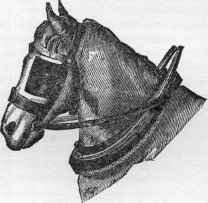
A Bull-Neck.
organs, but is also to be regarded as a conse
quence of a prevailing absence of development.
Certain judges are prejudiced in favor of a
short neck. The characteristic is in their minds
associated with bodily strength ; but it cannot
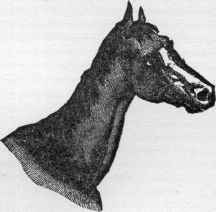
The Ewe-Neck.
denote the existence of such a quality, because
an absence of length must reduce the amount of
muscular fiber.
The Ear.—With the health of this organ the
general safety is associated ; for the acuteness of
the animal’s hearing affords no mean protection.
Absolute quietude of the ears indicates that
sounds are not heard. Excessive restlessness of
these parts suggests that by straining one sense,
the animal is endeavoring to supplement dullness
of another: that the vision is lost or imperfect.
156 THE FRIEND OF ALL.
A lively carriage of the ears expresses a sprightly
temper, and generally denotes a kind disposition;
whereas one ear constantly directed forward and
the other backward, is an indication of “vice” or
of timidity.
The Eye.—Many people will pretend to discover
the disposition of a horse by the character of the
eyes. A restlessness of the globe, the display of
any unusual quantity of white, and a perpetual
tension on the upper lid are imagined to signify
a “ vicious” inclination; but these traits express
only the watchfulness of fear. Such indications
are evidences of suffering which has been expe
rienced ; and denote an anxiety to escape future
brutality. A prominent eye, expressive of re
pose, and not showing much white, has been
pronounced to be declarative of honesty, though
certain parties have condemned it as indicative
of slothfulness. Quickness or activity, as con
tradistinguished from restlessness in the eye, is,
however, to be desired. The small eye usual
with the coarser breed of animals should be
avoided, because it is generally accompanied by
a heaviness of movement. The retracted or
deep-set eye, which displays the organ only par
tially, is somewhat angular in figure, and is com
monly spoken of as “ a pig-eye,” denotes either
weakness of the part, or a previous attack of
specific ophthalmia.
The Lips.—The lips of the horse are far more im
portant organs than many suppose. They are,
so to speak, the hands of the horse; and if any
one will observe the manner in which he gathers
up his corn with them, and collects together the
grass before he divides it with his nippers, he
will see that the horse would be no more able to
convey his food to his mouth without them,
than the human being could without his hands.
This has even been put to the test of experiment.
The nerves which supply the lips were divided
in a poor ass, to illustrate some point of physi
ology. The sensibility of the lips was lost, and
he knew not when he touched his food with
them; motion of the lips was lost, and he could
not get the oats between his teeth, although his
manger was full of them ; at length, driven by
hunger, he contrived to lick up a few of them
with his tongue; but when they were on his
tongue, the greater part of them were rubbed off
before he could get them into his mouth. It is
on account of this use of the lips, that the faces
of all quadrupeds are so lengthened, that the
lips may be brought into contact with the food,
without inconvenience or injury to other parts of
the face.
The lips are composed of muscles for the sake
of strength, and of a multitude of small glands,
which secrete a fluid that covers the inside of the
lips and gums, in order to prevent friction, and
likewise furnishes a portion of the moisture so
necessary for the proper chewing of the food.
The skin covering the lips is very thin, because,
if these are the hands of the horse, they should
possess considerable feeling; and for the same
purpose likewise, they are scantily covered with
hair, and that hair is fine and short, and long
hairs or feelers, called the beard, are superadded
for the same purpose. The horse is guided and
governed principally by the mouth, and therefore
the lips are endowed with extraordinary sensi
bility, so that the animal feels the slightest mo
tion of the hand of the rider or driver, and, as it
were, anticipates his very thoughts. The fine-
ness or goodness of the mouth consists in its ex
quisite feeling, and depends on the thinness of
this membrane.
The lips of the horse should be thin, if the
beauty of the head be regarded, for if they are
loaded with fat they cannot be as sensible as they
ought to be : yet, although thin, they should evi
dently possess power, and be strongly and regu
larly closed. A firm, compressed mouth gives a
favorable and no deceptive idea of the muscular
power of the animal. Lips apart from each other,
and hanging down, indicate weakness or old
age, or dullness and sluggishness. Examine the
angles of the lips. If any sign of induration is
remarked, it signifies that the animal has suffered
from the abuse of the bit. If on any limited
space, however small, a patch of white skin is
observed located upon a dark ground, it denotes
that at some time the true skin has been re
moved from that place. If anything like a hard
ened lump should be felt in this situation, it de
monstrates that the quadruped has a hard mouth,
and is an obstinate puller, or that it has passed
through the hands of an unfeeling master.
The Nostrils.—These organs admit the air in
haled by the expansion of the chest; consequently
the dimension of the nostrils allows an inference
as to the capacity of the lungs. This opinion,
however, should be only advanced after the alter
ation has been noted between their size when at
rest and when excited. Should no marked vari
ation be observed here, then the value of the
animal is to be considered only in connection
with slow work, as speed must be regulated by
the capability of receiving a quantity of vital air
proportioned to the power exerted. After the
capacity has been observed, the nature of the
movements of the nasal openings should be
noticed. Subsequent to exertion, ease of motion
is not to be anticipated ; but nothing approaching
to spasmodic action should be remarked. The
nostrils ought to be regularly expanded : not to
fly open with a jerk, or to suddenly enlarge their
form, as under the influence of a gasp. A capa
bility of dilatation, attended with an evenness of
HORSES AND THEIR MANAGEMENT. 157
motion, however fast the movement may be, are
the points which should be looked for in the
nostrils of a horse; because the characteristic
changes attending inhalation best expose any
defect in the respiratory apparatus; for, by such
a test, the remotest disposition to become a
roarer, or to exhibit diseased wind, is easy of de
tection.
The Thorax and Lungs.—There is much dispute
concerning the best form of the horse‘s thorax ;
but such a question can only be decided by the
uses to which the animal is to be put. All creat
ures in which speed is not required, should pos
sess circular chests ; for by such a shape they are
adapted for the accumulation of fat, and for the
performance of slow, of continuous or of labori
ous work. There are, however, numerous animals
which are required to possess capability for a
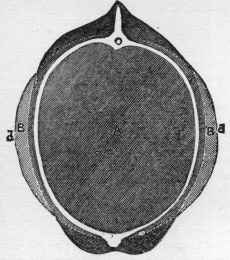
The Thorax of a Cart-Horse.
A A. The capacities of the two chests in the quiet condition.
B B, B B. The limits of expansibility in each when excited.
“ burst;“ for the rush or the closing struggle of
a race. The creature of speed, therefore, should
exhibit rather the deep than the round thorax;
for fat is not desired on such an animal. The
deep cavity, moreover, admits of an expansibility
which is imperative during intense muscular
exertion. Suppose the lungs of the cart- and of
the blood-horse, when expanded to the uttermost,
occupy the like space. When not excited, or
both being of normal size, the respiratory appara
tus of the coarser breed is by far the larger of the
two. In the passive condition, the heavy quad
ruped inhales much more oxygen than is needed
to vivify the blood. The excess is, therefore, ap
propriated by the food and nourishes the frame ;
hence dray-horses have a tendency to become fat.
On the contrary, while at rest, the lungs of the
thoroughbred receive scarcely more air than is
required to uphold vitality; therefore this kind
of quadruped exhibits, as a general rule, no great
tendency to fat. During all quickened move
ments, however, the action of the lungs and the
speed of the circulation are much increased. It
is not the size or dimension of its thorax which
determines fleetness. That quality depends on
the adaptability of the cavity to the exigencies
of excitement; for such purposes, the quadruped
with a round chest is not to be preferred. There
is no instrument by which the motions of the
horse’s ribs can be accurately ascertained : they
must be guessed at. A quarter of an inch be
tween the enlargement of the ribs in different
animals (supposing other points equal) will more
than determine the winner of a race, since the
revitalizing of the blood regulates the other pro
perties of vitality.
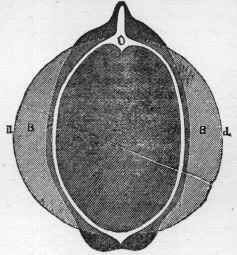
The Thorax of a Blood-Horse.
cc,cc. The outside of the coat in the quiet condition.
d d, d d. The surface of the body in the excited state.
The Abdomen.—Most judges admire a horse with
a belly apparently well filled by its contents.
Certainly this appears to be the soundest of the
many prejudices which appertain to horseflesh.
The shape of the thorax must, in no unimportant
degree, regulate that of the abdomen, the two
cavities being only parted by a fleshy screen de
nominated the diaphragm. The herring-gutted
quadruped is commonly as deficient in the respi
ratory as in the nutritive functions. Of course
this rule is not absolute ; but a capacious thorax
is required to counteract any defect in the pro
cess of nutrition. The animal which rapidly
narrows toward the flank generally purges upon
work, is of a washy constitution, and possesses a
bad appetite.
An animal with a deep chest and with high
withers, almost as a necessary adjunct. possesses
158 THE FRIEND OF ALL.
a slanting shoulder; or, at all events, this proba
bility is favored by that particular formation.
Such an arrangement of parts must be accom
panied by an upright position of the humerus
and the advanced location of the forelimb. This
conformation is bettered, materially, by an arched
crest and a head “ well set on.” Unfortunately,
this combination is seldom encountered.
The Legs and Shoulders.—The legs of a horse
can hardly prove too short; for shortness of limb
is an accompaniment to depth of chest and pro-
portionably powerful quarters. The long leg al
ways attests the light carcass: the motor agency
of the limbs is deficient, while the cavities of res
piration and of nutrition are necessarily dimin
ished. A narrow thorax almost necessitates low
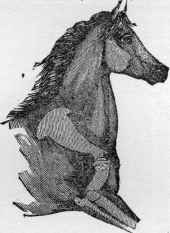
A Slanting Shoulder in Action.
withers and an upright shoulder. The bone of
the arm, or the humerus, is pushed into an undue
slant by the forward position of the blade-bone,
or of the scapula. This compels the front leg to
stand too far under the body. Such an arrange
ment favors neither beauty, speed nor safety; in
fact, it is one of the worst forms which the com
ponents are capable of assuming.
The Withers.—The action of the shoulder-blade,
during progression, is upward and backward, or
it is drawn toward the
highest processes of the
withers. Low withers
are, of course, opposed to
extended motion in such
a line. The lessened ac
tion of the bone neces
sarily limits the move
ment of the structures
which depend from it, or
the action of the humerus
is governed by that of the
shoulder-blade. The short motion permitted by
low withers, therefore, limits the advance of the

A Straight Shoulder, show
ing the Position of the
Bones.
forearm, the parts being, as it were, tied to
gether. The natural carriage of such a mal
formation is with the head and neck protruded,
so as to favor progression by strain upon the
cervical muscles. At the same time the body in
clines forward, which throws the limbs backward,
or out of their proper situations; and this circum
stance indicates why animals of this particular
make so frequently encounter “ accidents.”
The Lower Leg.—It remains to direct attention
toward that which in general acceptance consti
tutes the forearm, as well as the knee, the leg or
the shin, the pastern and the foot. Where the
limb quits the trunk, it should be characterized
by muscular developments, since at this place re
sides the chief of that power by which the lower
portions of the member are directed. The flesh
should bulge forth, and cannot be too abundant;
for a thin forearm is incompatible with goodness
in a horse. The point of the elbow should be pro
minently emphasized, as this bone affords a leve
rage whence many important muscles originate,
and which some of the principal flexor agents di
rectly operate upon. Toward the knee the swell-
ing should gradually subside, leaving upon the sur
face of the joint a broad, clean, and firm appear
ance. At the back ot the knee there should
stand forth, or rather should stick out, an osse
ous point, the size of which is of value, as it
affords a point of insertion to the short flexors
of the limb, as well as gives shelter to the per-
forans and perforatus tendons in their passage
toward the pastern and the foot. Its magnitude,
therefore, not only favors muscular action, but
also indicates the dimension of those important
structures which this bone protects.
The forearm should be long; the shin should
be comparatively short. The reach depends on
the first, the length of which secures an extra
amount of motor activity. No muscles of im
portance are located upon the shin : bone and
tendon are the principal components of this
region. The part should not be absolutely
straight; at the same time it ought to present no
obvious inequalities or sudden enlargements.
The bone should be compact, giving to this por
tion of the limb, when viewed from the front,
almost the appearance of being deficient in bulk;
but when regarded from the side, the lower part
of the leg cannot be too broad ; for breadth and
strength are here synonymous. The above rule
applies to both legs,—to the hind limb below the
hock as well as the fore, from the knee down
ward. Each should be thin, when viewed from
the front. Neither can well be too deep, when
seen from the side. Both should appear solid,
and each should feel almost of metallic hardness.
The pastern-joint should not present a level sur
face, when viewed laterally; and as it proceeds
HORSES AND THEIR MANAGEMENT. 159
downward to join the foot, a gradual enlarge
ment should take place.
The inclination of this region is governed by
the major flexor tendons which are situated un
derneath or behind them. Their slanting, there
fore, is regulated by no peculiarity in the forms
of the bones themselves, but is controlled by and
dependent upon the condition of another struc
ture. A short, upright pastern, if it can bear any
evidence at all, testifies to a stubborn and un-
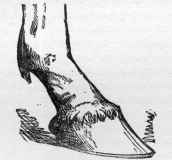
A Long and Slanting Pastern.
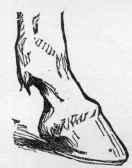
A Natural Pastern.

An Upright Pastern.

An Overshoe Pastern.
yielding state of the great flexor muscles, the
weight being then thrown upon the osseous sup
ports. The play of the pastern denotes nothing
more than the healthy elasticity of the flesh upon
the tendon proper. The bones have no motor
power belonging to themselves. The upright
and the overshot pastern suggest no change in
the more solid frame; but such alterations prove
that excessive work has strained the great flexors
of the limb, and destroyed the inherent property
of elasticity with which every muscle is endowed
by nature. The burden being then supported by
an osseous pillar instead of an elastic band, of
course jar or concussion ensues.
The flexor tendon likewise influences another
part. The perforans is inserted into the sole of
the coffin-bone, or into the bone of the foot. The
direction in which the toes point is, therefore, re
gulated by a substance so far distant that the at
tempt to connect the two organs may, to the un
informed mind, seem ridiculous. Yet, the state
ment being correct, the fact renders the position
of the elbow of more importance; for according
to the situation of that bone the hoofs will be
directed. Thus, an ulna or an elbow which is
drawn toward the trunk will be attended with a
toe inclined outward. When the bone turns from
the body, the forward portion of the hoof is di
rected inward. When the framework is properly
constructed, the hoofs point forward ; for horses’
hoofs are liable to those derangements which the
human foot exhibits, and generally with like re
sults. Only, in man, striking one leg against the
other, while walking, is not attended with the un
fortunate consequences the same thing induces
in the quadruped
“VICES,” SO CALLED.
Toothy and Temper.—W. E. Burton, in the old
Chambers Street theater, on whose site is the
present edifice of the American News Co., hav
ing the care of a wayward child, walked it up
and down the stage, exclaiming in response to
one scream of the young one, “ That‘s toothy ;"
and in answer to another yell, “ That’s temper.”
It is hard often for a person even in his own
case, to be sure whether he ought to be pitied, or
to be blamed. And if it is hard in one‘s own
case, how much harder in the case of another,
who can tell you of his “ subjective” experiences.
But how much harder still the problem becomes,
when its object has not at command, as has
man, the power of articulate utterance. If the
horse could only speak, it is probable that his
share of real “vice,” mischief for which the will
is answerable, would compare favorably with his
master’s. He cannot tell of his nervousness,
his fear, the dread of additional abuse, the dys
pepsia and heaviness improper, scanty or ex
cessive food may have occasioned ; the results
of a previous wakeful night: the thousand and
one disturbances for which a man or a woman ex
pects and receives sympathy, not blame. With
out denying that the horse sometimes misbe
haves from “temper,” it is undeniable that some
times also, perhaps oftenest, he suffers from
“toothy.” But if those who have charge of
horses would try to supplement their deficiency
of speech, and to find out what each animal
160 THE FRIEND OF ALL.
would gladly tell them if he could, the necessity
for so-called discipline would almost disappear,
and the whip and spur and club follow the harsh
methods once used with those then regarded as
possessed with a devil, but now cared for as the
victims of disease.
Horses not totally Depraved.—Mayhew, the great
English authority in veterinary matters, discre
dits “ vice” as applied to a horse, as emphatically
as Dr. Channing did “ total depravity” as applied
to a man. He tells that he was of middle age
when he entered the Veterinary College, and
unfamiliar with horseflesh. He needed an
animal, so that reference might be made to its
body for an explanation of the books he was to
comprehend. At length, in the corner of a back
yard, was discovered a lonely loose box. Inside
was a quadruped; and to this place a volume
was daily taken, with various morsels of bread or
vegetable. There, between feeding, reading, ex
amining and caressing, many an afternoon
passed. It was necessary to indulge in certain
intimate familiarities, sometimes to change the
position of the animal, or to finger its lower ex
tremities. He had no jockeyship to protect
him ; did not indeed know that any protection
was necessary. He used to shut himself up with
the companion of his studies, and spent his time
very happily. After a fortnight of this experi
ence, as he was one day going to the loose box,
he was seen by a number of his fellow-students,
who exclaimed: “ Mayhew, where are you go
ing? Don’t open that door ! ‘ Van Amburg’ is
there. He’s a kicker and a biter! You’ll be
killed! Don’t open the door !“ Van Amburg
was the name of a thoroughbred racer, which
had been sent to the College “ for operation,” be
cause of its supposed ferocity. He exclaims:
“ Yet I, a novice, had passed many an hour in its
society, and assert that I could not have desired
a more gentle companion. We have often lain
long together side by side; or, as I reclined upon
the straw, reading, the head would rest upon my
shoulder, while a full stream of fragrant warmth
would salute my cheek. Still, such a crea
ture, so open to advances, so grateful for little
kindnesses, was a reputed savage!"
Balking, or Jibbing.—These words are very com
mon among horsemen. Balking, however, does
not specially imply one act; there are many kinds
of behavior which are so designated. Thus, a
horse which is unable to start, is called “a
balker,” as is a quadruped which, in the middle
of a journey, shall be suddenly impelled to move
in a backward direction. The animal which,
upon hearing the command to proceed, will be
gin to throw up its head, and, spite of chastise
ment, bear in the opposite direction, is also sup
posed to have learned the “ vice.” " Balking” of
every kind appears to be no “vice,” but a
nervous disorder,—a sort of equine epilepsy. A
word spoken sharply can summon the attack,
which generally deprives the animal of all power
of motion, or forces it to move in a direction the
opposite of that on which it wishes to proceed.
The movements are independent of the will; and
if any person will attentively inspect the counte
nance of a horse, when in the act, the real cha
racter of the supposed “ vice” will be recognized.
A spasmodic fit has possession of the frame. It
is useless to flog or to inflict other tortures.
The attack will last a certain time, and then,
perhaps, suddenly vanish. No brutality can
shorten its duration, though cruelty, possibly,
may lengthen the convulsion. Severity has lost
its power to quicken timidity. The lash will not
influence; nor the human voice. The body is
acted upon by a power stronger than the will.
At last the spell is broken. The ability to guide
the limbs is suddenly regained: but the brain is
congested and the senses confused. The crea-

The Countenance of a Horse during a Fit of Balking.
ture, upon partial recovery, may exhibit a desire
to bolt—may, for an uncertain period, be all but
unconscious. Sometimes it will recover its
powers suddenly, almost as though its previous
condition had been assumed. On other occa
sions it may, under some impulse, tear onward,
regardless of the road, as though it sought to es
cape the scene of suffering, or lose the pain of
convulsion in the rapidity of motion.
Balking is most common among harness-
horses, the faces of which are disguised and par
tially concealed by the blinkers. The counte
nance of a horse, when in this act, calmly con
templated, will dispel all belief in “voluntary
vice.” The eye is strained inward; the teeth are
firmly set; the nostrils are dilated; the breath
ing is spasmodic; and the muscles are rigid.
There is, however, one symptom which, al
though expressive of terror, agony or faintness,
all horsemen are agreed in regarding as showing
a “vicious intention.” Such is the backward
position of the ears, or the laying of those organs
HORSES AND THEIR MANAGEMENT. 161
upon the animal’s neck. The forward carriage, [
or the “pricking” of those members, is recog
nized as expressive of delight, of gayety or of
attention. What, then, does the backward posi
tion signify? What ought to be implied from
the falling of a part whose upright bearing is in
terpreted to be the sign of liveliness ? Yet, how
many tender-hearted gentlemen, abused by the
prejudices they inherited, will, when they ob
serve the ears laid back, unhesitatingly lash the
body which, probably, was far from contemplat
ing mischief!
When an animal is thus afflicted, never pursue
the course usually adopted. All noise should be
prevented ; no flurry should be permitted. Do
not use the whip or jag the reins: relinquish
both. Empty the vehicle. Undo the check-
rein : loosen the harness. If possible, remove
the quadruped from the shafts. Go to the head:
speak soothingly; pat and caress the agitated
frame. Procure some cold water; soak a thick
cloth in the liquid, and lay it over the brain and
upon the eyes. Sponge out the mouth and nostril;
then empty the vessel, by dashing the remaining
fluid into the animal‘s face. When the incapaci
tating stage is subsiding, don’t let him bolt.
This done, return the horse to the stable. Never
hazard riding behind a creature which has re
cently suffered with “ equine epilepsy.”
“Kidney-Dropping.’’—Sometimes a horse in har
ness, not overloaded, and pleasantly jogging
along, suddenly squats on its haunches. This is
an unnatural position. The hind limbs fall into
such positions as suggest no notion of comfort
or of design. They may cross one another, or
they may be sprawled out on either side of the
body. If the skin is pricked with the point of a
pin, no sign of sensibility is usually elicited from
the hindquarters. Strike the prostrated mem
bers, and no evidence of pain follows. The pos
terior portions of the body are temporarily dead.
Do not fuss about the horse ; allow it to remain
undisturbed where it has fallen. Loosen the
harness; remove the shafts; procure some water,
and allay its parching thirst. After a short
space, the quadruped may get up of its own ac
cord. No time has been lost; and disease has
not been aggravated by needless torture. When
the creature rises, the fit has passed; but the re
covery cannot then be pronounced complete.
He would, certainly, brave “an accident” who
should essay to drive a horse but recently re
covered from an attack of “kidney-dropping,”
though this hazard may be frequently incurred
with apparent impunity.
To determine whether any disease of the spine
is the cause of this affection, the investigator
takes his position close to the quadruped, and
runs the forefinger and thumb gently down the
II
center of the back. This action is repeated
several times, additional force being brought to
bear with each succeeding trial, until the whole
strength of the operator is exerted. If, upon
pressure being made on any particular spot, the
ears are laid upon the neck, or the crest is sud
denly elevated, the fact must be noted. The
trial should be renewed, and if the like symp
toms be elicited, the conclusion naturally is, that
the seat of injury lies immediately under or very
near the place indicated. This point being as
certained, the operator puts a hand on either
side of the tender part, and casts his full weight
suddenly upon the spine. Horses, under the
sudden pang thus produced, have shrieked in
agony. Generally, animals crouch under the
torture, and burst forth into copious perspira
tion. The affair is thus decided. The spine has
been injured, and the spinal cord which it
sheathes is also involved in the lesion. Some-
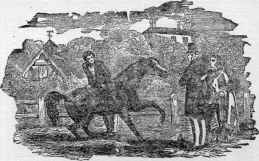
Test Along the Spine.
times the animal entirely recovers; the trouble
being caused by displacement or by such a par
tial fracture as rest will enable nature to sur
mount. In any case the horse is not “ to blame.”
Chink in the Back.—One of the bones of the
spine may have been loosened in consequence of
the ligaments being overstrained; the animal
has been abused in some manner. The ligaments
are acutely painful; though no visual disorder
may be observable to the postmortem examiner,
nevertheless the slightest weakness in such a
structure may, during life, occasion the severest
agony. The bone is not fractured ; but one of
the vertebræ, through the leverage of its superior
spinous process, may have been wrenched slight
ly to one side. This may not affect the appear
ance of the quadruped; neither may it elicit
signs of pain when the weight is evenly seated
upon the back; therefore, only during the act of
mounting, the drag then being entirely to one
side, it occasions the most poignant anguish.
The horse cannot explain its sensations verbally,
nor appeal to the forbearance of its master. Its
ailments are entirely subjected to the merciful
consideration of man. Its actions are always
162 THE FRIEND OF ALL.
liable to be misconstrued; the effects of torture
are frequently confounded with the exhibitions
of “vice.” Thus, a creature with the ligaments
of the back strained is always condemned as an
inveterate kicker; because the drag, produced
by the weight of the rider resting on one stirrup,
occasions so sharp an agony as alarms the quad
ruped, and naturally excites a determination to
repel some imaginary enemy. The seat of the
saddle, however, is no sooner attained than com
posure is restored. When the rider is once fairly
on the back, the steed re-assumes its natural
docility and obedience. That circumstance has
induced some thoughtful horsemen to change
the habit and try the effect of mounting upon
the wrong side; this has usually, for a certain
time, been attended with perfect success; but
the custom, after a time, has seemed to involve
the sound ligaments, when the kicking has been
renewed. A horse which kicks in the way de
scribed, should always be transferred to harness
work.
Tearing the Clothing.—Stabled horses often are
the victims of an acutely sensitive condition of
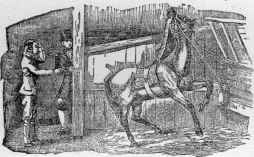
Tearing the Clothing.
the skin. There is no tenderness displayed when
the hand is laid upon the body. The coat looks
well. Scurf is not developed in increased quan
tity. The hair does not prove loose or fall off.
The animal feeds well, and seems in the highest
possible condition. Nevertheless, it may acutely
suffer, especially during spring and autumn. It
may even by the irritation be provoked to gnaw
large patches from the sensitive covering of the
body; but the more common form of the disease
urges it to destroy the heavy rug in which stable
attendants are fond of wrapping their charges,
before quitting them for the night. No sooner is
the quadruped clothed up, than it begins to
fidget. Its legs are in almost perpetual motion,
and as soon as it is alone, it commences to tear
off the hateful clothing. Large portions are
seized between the teeth, and rent off with an
energy almost madness. Nor is the fever which
actuates the horse to be pacified, so long as a
vestige of the covering remains to be removed. |
The passion seems to be very engrossing while it
exists ; for, during the period, anybody may enter
the building, and even approach the irritated
quadruped, without his presence being observed.
But, the feat being ended, the creature looks
around, seems to recover quiet, nibbles different
portions of its coat, licks the coolest parts of its
manger, being evidently thirsty, and ultimately
lies down, apparently well satisfied with its per
formance.
For an animal that destroys its rugs, refuse all
further supply. Attend to the food, after the
method already advised ; next anoint the body
with glycerine and rosewater, subsequently em
ploying a hay wisp regularly night and morning.
Place the animal in a cool, loose box, and, if
possible, leave the window and half the door
open. Give daily one ounce of liquor arsenicalis,
in a pint of cold water, with one quart of good
ale.
Shying and Swerving.—In the treatment of shy
ing, it is of great importance to distinguish be
tween that which is the consequence of defective
sight, and that which results from fear, or new
ness of objects, or from mere affectation or skit-
tishness. For the first, every allowance must be
made, and care must be taken that the fear of
correction be not associated with the imagined
existence of some terrifying object. The severe
use of the whip and the spur cannot do good
here, and are likely to aggravate the vice tenfold.
A word, half encouraging and half scolding, with
a gentle pressure of the heel, or a slight touch of
the whip, will tell the horse that there was no
thing to fear, and will give him confidence in his
rider or driver on a future occasion. It should
be remembered, however, that although a horse
that shies from defective sight may be taught
considerable reliance on his rider, he can never
have the cause of the habit removed. We may
artificially strengthen the human sight, but the
horse’s must be left to itself.
The shying from skittishness or affectation is
quite a different affair, and must be conquered.
But how ? Severity is out of place even here. If
he is forced up to the object by dint of correc
tion, the dread of punishment will afterwards be
associated with that object, and on the next occa
sion, his startings will be more frequent and more
dangerous. The way to cure him is to go on,
turning as little as possible out of the road, giv
ing the animal a harsh word or two, and a gentle
touch with the whip or spur, and then taking no
more notice of the matter. After a few times,
whatever may have been the object which he
chose to select as the pretended cause of affright,
he will pass it almost without notice.
Mr. John Lawrence says: “These animais
generally fix on some particular shying butt : for
HORSES AND THEIR MANAGEMENT. 163
example, I recollect having, at different periods,
three hacks, all very powerful; the one made
choice of a windmill for the object or butt, the
other a tilted wagon, and the last a pig led in a
string. It so happened, however, that I rode the
two former when amiss from a violent cold, and
they then paid no more attention to either wind
mills or tilted wagons than to any other objects,
convincing me that their shying when in health
and spirits was pure affectation ; an affectation,
however, which may be speedily united with
obstinacy and vice. Let it be treated with marked
displeasure, mingled with gentle, but decided
firmness, and the habit will be of short endu
rance.”
Rolling.—This is a very pleasant and perfectly
safe amusement for a horse at grass, but cannot
be indulged in the stable without the chance of
his being dangerously entangled with the collar-
rein, and being cast. Yet, although the horse is
cast, and bruised and half-strangled, he will roll
again on the following night, and continue to do
so as long as he lives. The only remedy is not a
very pleasant one to the horse, nor always quite
safe; yet it must be had recourse to if the habit
of rolling is inveterate. The horse should be tied
with length enough of collar to lie down, but not
to allow of his head resting on the ground; be
cause, in order to roll over, a horse is obliged to
place his head quite down upon the ground.
DIAGRAM SHOWING THE SEAT OF THE PRINCIPAL DISEASES OF THE HORSE.
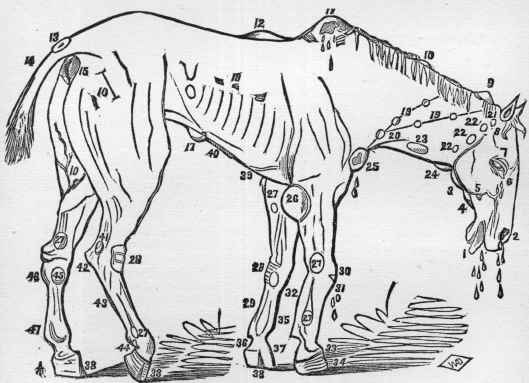
4. Caries and diseases of the jaw.
5. Fistula parotid duct.
6. Diseases of the eye.
7. Sears on the forehead and over the
eyes.
8. Scars from old fontanels and brain-
diseases.
9. Poll-evil,
10. Prurigo, or Mane-scab.
11. Fistulous withers.
12. Saddle-galls, Sitfasts, etc.
13. Fistulous tail.
14. Rat-tail.
15. Falling of the fuadament.
16. Luxation of patella, or whirl-bone dis
placed.
17. Hernia, or Rupture.
18. Broken ribs.
19. Farcy.
20. Sores from constant bleeding.
si. Bridle-swellings.
22. Fistula and inflammation of parotid
gland.
23. Phlebitis, or inflamed jugular vein.
24. Sore throat.
25. Tumors caused by collar.
26. Capped elbow, or Tumor.
27. Wind-galls.
28. Mallenders and Sallenders.
29. Splint.
30. Capped knee.
31. Broken knees and open joint.
32. Clap of the back sinews.
33. Ringbone.
34. Acute and chronic founder, or Ring-
foot.
35. Grogginess.
36. Quittor.
37. Tread on coronet and overreaches.
38. Sand, Toe, Cow and Quarter-Cracks.
39. Girth swellings.
40. Wind-colic, Fret, Gripes or Belly
ache.
41. Thoroughpin.
42. Capped hocks.
43. Swelled or sprung sinews.
44. Scratches.
45. Spavin.
46. Curb.
47. Swollen legs.
164
THE FRIEND OF ALL.
DISEASES AND ACCIDENTS, AND
THEIR TREATMENT.
Abdominal Injuries.—Ruptured Diaphragm gen
erally produces a soft cough; sitting on the
haunches or leaning on the chest may or may
not be present; the countenance is haggard.
Ruptured Spleen answers to the tests described
under “ Hemorrhage of the Liver.”
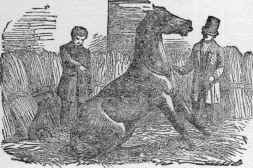
An Unnatural Attitude, indicative of some Abdominal
Injury.
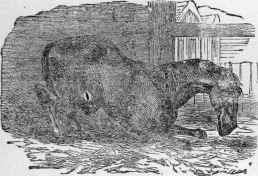
A Position often assumed by the Horse suffering from
Abdominal Injury.
Ruptured Stomach is characterized by exces
sive colic, followed by tympanitis.
Intro-susception is always preceded by colic, and
causes portions of the bowels to contract and

A Ruptured Stomach.
become small, firm and stiff. They are, while
in that condition, by the peristaltic action pushed
up other portions of the canal, which are of the
natural size. The entrance of the contracted
bowel acts upon the healthy one like a foreign

substance. Contractility is excited. The dis
placed and intruding bowel is grasped as by a
vise, and the accident pro
vokes its own continuance.
Cure is hopeless while con
sciousness remains; the only
hope is the administration
of chloroform in full and
long-continued doses : there
by to arrest vitality and give
a chance for the release of
the imprisoned bowel.
Invagination is used to express the entrance of
one entire division of the bowels within another.
It is chiefly witnessed upon the large intestines;
whereas intro-susception is mostly present upon
the smaller bowels. The mesentery must be rup
tured before such an accident can take place;
but then the agony attendant upon the previous
The Intestine divided
so as to clearly
show the Nature of
Intro-susception.
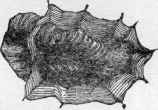
The Cæcum invaginated within the Colon, and black
from intense inflammation.
derangement is so powerful that it is impossible
for the hugeness of this lesion to increase the
violence of the torture; nor is there any sign by
which so sad a catastrophe can be predicted.
Strangulation is not to be distinguished, dur
ing life, from invagination.
Calculus, or stone, may be present, either in the
stomach or in the canal and remain there while
the food passes over it, and no injury occa
sioned. But by any movement it is likely to be
dislodged and thrown into the healthy channel
There it is firmly grasped with such force as to
produce rupture of the intestine, and the hold is

The Sac formed in the Bowel; this the Calculus has
quitted, while another portion of the intestine has so
firmly grasped it as to rupture itself.
only relaxed after inflammation has ended in
mortification and death.
Abscess of the Brain.—Cause.—Some injury to
the head.
Symptoms.— Dullness; refusal to feed; a slight
HORSES AND THEIR MANAGEMENT. 165
oozing from a trivial injury upon the skull;
prostration, and the animal, while on the ground,
continues knocking the head violently against
the earth until death ensues.
Treatment.—None of any service.
Acites, or Dropsy of the Abdomen. Cause.—
Chronic peritonitis.
Symptoms.—Pulse hard ; head pendulous; food
often spoiled; membranes pallid; mouth dry.
Pressure on abdomen elicits a groan ; turning in
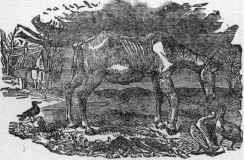
A Horse with Acites, or Abdominal Dropsy.
the stall, a grunt. Want of spirit; constant
lying down; restlessness; thirst; loss of appetite;
weakness; thinness; enlarged abdomen; consti
pation and hidebound. Small bags depend
from the chest and belly; the sheath and one
leg sometimes enlarge; the mane breaks off;
the tail drops out. Purgation and death.
Treatment.—When the symptoms first appear
give, night and morning, strychnia,½ grain,
worked up to 1 grain; iodide of iron, ½ drachm,
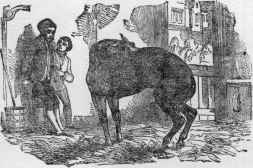
A Horse suffering from Drastic Poison.
worked up to 1½ drachm ; extract of belladonna,
1 scruple; extract of gentian and powdered
quassia, a little of each ; apply small blisters, in
rapid succession, upon the abdomen : but if the
effusion is confirmed, a cure is hopeless.
Acute Dysentery. — Cause. — Some acrid sub
stance taken into the stomach.
Symptoms.—Abdominal pain ; violent purga
tion ; the fæces become discolored, and water
fetid; intermittent pulse; haggard countenance;
the position shows the seat of anguish. Perspi
ration, tympanitis, and death.
Treatment.—Give sulphuric ether, 1 ounce;
laudanum, 3 ounces; liquor potassæ, ½ ounce;
powdered chalk, 1 ounce; tincture of catechu, 1
ounce; cold linseed tea, 1 pint. Repeat every
15 minutes. Cleanse the quarters ; plait the tail;
inject cold linseed tea. The irritating substance
must be expelled before improvement can take
place.
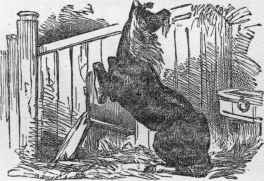
A Horse suffering from Acute Gastritis.
Acute Gastritis.—Cause.— Poison ; generally
given to improve the coat.
Symptoms.—Excessive pain, resembling fury.
Treatment.—Give, as often and as quickly as
possible, the following drink: Sulphuric ether
and laudanum, of each 3 ounces; carbonate of
magnesia, soda or potash, 4 ounces; gruel (quite
cold,) 1 quart. Should the pulse be sinking, add
to the drink carbonate of ammonia, 1 drachm-
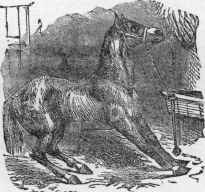
Acute Laminitis, or Fever in the Feet.
If corrosive sublimate is known to be the poison,
one dozen raw eggs should be blended with each
drench. If delirium be present, give the medi
cine as directed for tetanus, with the stomach-
pump.
Acute Laminitis, or Fever in the Feet.—Cause.—
Often man’s brutality. Horses driven far and
upon hard roads are exposed to the disorder.
166 THE FRIEND OF ALL.
Any stress long applied to the foot, as standing
in the hold of a ship, may produce the affection.
Symptoms.—The pace seems odd toward the
end of the journey; but the horse is placed in
the stable with plenty of food for the night.
Next morning the animal is found all of a heap.
Flesh quivering; eyes glaring; nostrils dis
tended, and breath jerking; flanks tucked up;
back roached; head erect; mouth closed; hind
legs advanced under the belly; fore legs pushed
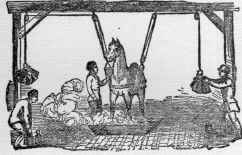
A Horse in Slings, with the Forefeet in Hot Water, for
Acute Laminitis.
forward; fore feet resting upon the heels, and
the limbs moved as though the horse were
dancing upon hot irons.
Treatment.—Put on the slings in silence. To
the end of the cords append weights. Soak the
feet in warm water, in which a portion of alkali
is dissolved. Cut out the nails from the soften
ed horn. Before the shoes are removed give ½
drachm of belladonna and 15 grains of digitalis,
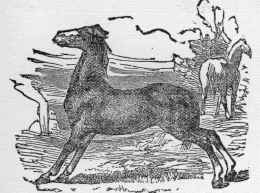
The Positions assumed by Horses having Albuminous
Urine.
and repeat the dose every half-hour until the
symptoms abate. When the slings are up, open
the jugular vein; abstract one quart of blood,
and inject one pint of lukewarm water. Clothe
the body; place thin gruel within reach, and
watch for the first three nights.
Next morning give sulphuric ether and lauda
num, of each 2 ounces, in a pint of water.
Should the pastern arteries throb, open the
veins and place the feet in warm water. While
the affection lasts, pursue these measures; and
it is a bad symptom, though not a fatal one, if
no improvement takes place in five days.
Albuminous Urine.—Cause.—Unknown.
Symptoms.—These consist of the positions
assumed by the horse. The legs are either
stretched out or the hind feet are brought under
the body. Straddling gait, and much difficulty
in turning within the stall. The urine is thick.
Treatment.—Bleed moderately; give a laxa-
tive, and apply mustard to the loins. As after-
measures, perfect rest, attention to diet, and
repeated doses of opium.
Aphtha.—Cause.—Unknown.
Symptoms.—Small swelling on the lips; larger
swellings upon the tongue. As the disease pro-
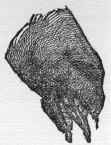
Aphtha.
gresses, a clear liquid appears in each swelling.
The bladders burst, crusts form, and the disease
disappears.
Treatment.—Soft food, and the following wash
for the mouth: Borax, 5 ounces; honey or
treacle, 2 pints; water, 1 gallon. Mix.
Bog Spavin.—Cause.—Brutality of
some kind.
Symptom.—A puffy swelling at
the front of and at the upper part
of the hock.
Treat7nent. — Pressure, main
tained by means of an India-rub
ber bandage.
Bots.—Cause.—Turning out to
grass.
Treatment.—No remedy. The
following year the parasites will be ejected
naturally.
Brain, inflammation of the.—See Phrenitis.
Breaking Down.—Cause.—Violent exertion ; ge
nerally when racing.
Symptoms.—The horse, when going, suddenly
loses power to put one leg to the ground. The
foot is turned upward ; pain excessive; breathing
quickened ; pulse accelerated ; appetite lost. In
time these symptoms abate, but the leg is disa
bled for life.
Treatment.—Bleed and purge, or not, as the
symptoms are severe. Place a linen bandage
round the injury, and see that this is kept con

Bog Spavin, or
Distension of
the principal
Synovial Mem
brane of the
hock-joint.
HORSES AND THEIR MANAGEMENT. 167
stantly cold and wet; put on a high-heeled shoe,
and leave the result to nature.
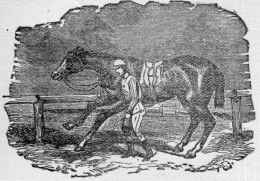
Breaking Down.
Broken Knees.—Causes.—Terrifying a horse, or
rendering alive only to fear. Pulling in the chin
to the breast, or driving with a tight check-rein.
Symptoms.-The horse falls; the knee may only
be slightly broken, but deeply contused. A slough
must then take place, and open joint may result.
Or the animal may fall, and, when down, be driven
forward by the impetus of its motion. The knee
is cut by the fall, and the skin of the knee may
be forced back by the onward impulse. This skin
will become dirty; but the removed integument
will fly back on the animal‘s rising, thus forming
a kind of bag containing and concealing foreign
matter.
Treatment.—Procure a pail of milk-warm water
and a large sponge. Dip the sponge in the pail,
and squeeze out the water above the knee. Do
not dab or sop the wound itself. The water flow
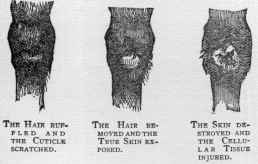
ing over the knee will wash away every impurity.
Then with a probe gently explore the bag. If
small, make a puncture through the bottom of
the bag; if large, insert a seton, and move it night
and morning until good pus is secreted : then
withdraw the setion. “ Rack up” the horse’s
head, and get some cold water, to every quart of
which add two ounces of tincture of arnica.
Pour a little of this into a saucer, and dip a
sponge into the liquid. Squeeze the sponge dry
above the joint. Do this every half-hour for
three and a half days, both by day and night. If
at the end of that time all is going on well, the
head may be released ; but should the knee en
large and become sensitive, while the animal re
fuses to put the foot to the ground, withdraw the
seton ; give no hay, but all the oats and beans
that can be eaten, with two pots of stout each
day. Place the quadruped in slings ; apply the
arnica lotion until a slough takes place; then re-
sort to the chloride-of-zinc lotion, one scruple to
the pint, and continue to use this as has been
directed.
Broken Wind. — Causes. — Old age, prolonged
work and bad food.
Symptoms.—Short, dry, hacking cough, caused
by irritability of the larynx; ravenous appetite ;
insatiable thirst; abundant flatus. Dung half di
gested ; belly pendulous; coat ragged ; aspect de
jected. Respiration is performed by a triple
effort; inspiration is spasmodic and single; ex
piration is labored and double. The ribs first
essay to expel the air from the lungs; these fail
ing, the diaphragm and abdominal muscles take
up the action. Broken wind can be concealed
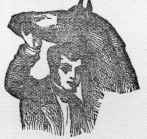
How to hear the Sound made within the Horse‘s Wind
pipe.
for a time by forcing the animal to swallow
quantities of grease, tar or shot. A drink
of water, however, will always reproduce the
symptoms.
Treatment.—No cure. Relief alone is possible.
Never give water before work. Four half-pails of
water to be allowed in twenty-four hours. In
each draught mingle ½ ounce of phosphoric acid
or ½ drachm of sulphuric acid. Remove the bed
in the day; muzzle at night; put rock-salt and
chalk in the manger. Never push hard or take
upon a very long journey.
Bronchitis.—Causes.—Riding far and fast; then
leaving exposed, especially to the night air; neg
lect and constitutional liability.
Symptoms.—Appetite often not affected ; some
times is increased. A short cough, in the first
instance; breathing only excited; legs warm;
mouth moist; and nasal membrane merely deeper,
color during the early stage. When confirmed,
the appetite is lost; the horse is averse to move ;
the cough is sore and suppressed ; the breathing
is audible; the membranes are scarlet; the mouth
168 THE FRIEND OF ALL.
is hot and dry ; the legs are cold ; the body is of
uneven temperatures.
Treatment.—Do not deplete. Place in a large,
loose box ; fill the place with steam ; apply scalded
hay to the throat; fix flannels wet with cold water
to the back and side by means of a jacket. When
the flannel becomes warm, change it. Do this for
two hours. After that space the flannel may re
main on, but must not become dry. Prepare ½
pound of melted Burgundy pitch, and stir into it

A Horse dressed for Bronchitis.
2 ounces of powdered camphor, with ½ drachm of
powdered capsicums. Apply the mixture to the
throat. To restore tone to the pulse, give, every
half-hour, sulphuric ether and laudanum, of each
1 ounce ; water, 1 pint. If no effect be produced
by three of these drinks, substitute infusion of
aconite, ½ ounce; extract of belladonna, ½ drachm
rubbed down in water,¼ pint. When the pulse
has recovered, resume the former physic, only
adding ½ drachm of belladonna to each dose.
Support with gruel. Introduce food gradually;
“ chill " the water; be careful of hay, which must
be thoroughly damped.
Bronchocele. — Symptom. — An enlargement on
the side of the throat.
Treatment.—Give, night and morning: iodide
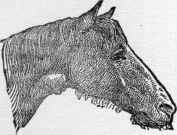
A Horsf. with Bronchocele.
oi potassium, ½ drachm; liquor potassæ, 1 drachm;
distilled water, ½ pint. Also, rub into the swell
ing the accompanying ointment: iodide of lead,
1 drachm, simple cerate, 1 ounce.
Bruise of the Sole.—Cause.—Treading on a stone
or some projecting body.
Symptom.—Effusion of blood into the horny
sole.
Treatment.—Cut away the stained horn, and
shoe with leather.
Calculi.—Causes.—Unknown.
Renal Calculus.—A stone within the pelvis of
the kidney.
Symptoms.—Urine purulent, thick, opaque, gritty
or bloody; back roached. Pressure on the loins
occasions shrinking; the arm in the rectum and
the hand carried upward provoke alarm.
Treatment. —2 drachms of hydrochloric acid
in every pail of water; but the result is doubtful.
Cystic Calculus signifies a stone in the cavity of
the bladder.
Symptoms.—Same states of urine as in renal
calculus. The water, when flowing, is suddenly
stopped ; every emission is followed by straining;
the back is hollowed; the point of the penis is
sometimes exposed ; and, when going down hill,
the animal often pulls up short.
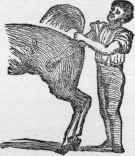
A Certain Method of ascertaining if there be Calculus
in the Bladder.
Treatment of Cystic Calculus.—Examine per
rectum. An operation for the animal is impera
tive. When the stone is small, hydrochloric
acid may be tried.
Symptoms of Urethral Calculus.—Suppression
of urine; great suffering. If the urethral calcu
lus is impacted in the exposed portion of the ure
thra, the passage is distended behind the stop
page.
Treatment of Urethral Calculus.—Cut down
upon and remove the substance.
Canker.—Cause.—Old horses, when “turned
out” for life as pensioners. Aged and neglected
animals will also exhibit the disease.
Symptoms.—Not much lameness. The disease
commences at the cleft of the frog; a liquid is
sues from the part, more abundant and more of
fensive than in thrush ; it often exudes from the
commissures joining the sole to the frog. The
horn first bulges out; then it flakes off, expos
ing a spongy and soft substance, which is fungoid
horn. The fungoid horn is most abundant about
the margin of the sole, and upon its surface it
flakes off. This horn has no sensation. The
HORSES AND THEIR MANAGEMENT. 169
disease is difficult to eradicate when one fore
foot is involved. When all four feet are impli
cated, a cure is all but hopeless, and the treat
ment is certain to be slow and vexatious.
Treatment.—The stable must be large, clean
and comfortable; the food of the best; allow
liberal support; pare off the superficial fungoid
horn, and so much of the deep-seated as can be
detached. Apply to the diseased parts some of
the following: Chloride of zinc, ½ ounce; flour, 4
ounces. Put on the foot without water. To the
sound hoof apply chloride of zinc, 4 grains;
flour, 1 ounce. Cover the sound parts before the
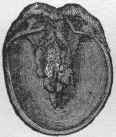
The Primary Establishment
of Confirmed Canker.
The horn turned back, so as to
display the altered state of
the frog, which indicates a
severe attack of the disease.
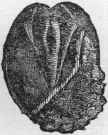
The Second Stage or
Canker.
Showing the great abundance
of fungoid horn secreted
around the margin of the
foot. No notice is purposely
taken of the frog in this il
lustration.
cankered horn is dressed ; tack on the shoe; pad
well and firmly. When places appear to be in
confirmed health, the following may be used :
Cloride of zinc, 2 grains; flour, 1 ounce. At
first, dress every second day; after a time, every
third day, and give exercise as soon as possible.
Capped Elbow.—Cause.—Injury to the point of
the elbow.
Symptom.—It is often of magnitude, and is
liable to ulcerate and become sinuous.


Treatment.—The same as capped hock.
Capped Hock.—Cause.—Any injury to the point
of the hock.
Symptom.—A round swelling on the point of
the hock, which, should the cause be repeated,
often becomes of great size.
Treatment.—If small, set several men to hand-
rub the tumor constantly for a few days. Should
the capped hock be of magnitude, dissect out the
enlargement, without puncturing it. Remove
none of the pendulous skin. Treat the wound
with the lotion of chloride of zinc—one grain to
the ounce of water—and it will heal after some
weeks.
Capped Knee.—Cause.—The same as the previous
affection.
Symptom.—A soft tumor in front of the knee.
Treatment.—If let alone, it would burst and
leave a permanent blemish. Draw the skin to
one side, and with a lancet pierce the lower sur-
face of the tumor. Treat the wound as an open
joint.
Cataract.—Cause.—Looking at white walls, or
receiving external injuries. Specific ophthalmia
generates a permanent cataract.
Symptoms.—When partial, shying; if total,
white pupil and blindness.
Treatment.—Color the inside of the stable
green, as cataract, when not total, sometimes dis
appears.
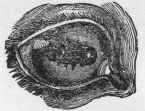
Partial Cataracts, or Small White Speck within the Pupil
of the Eye.
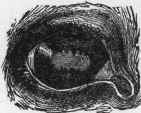
Complete Cataract.
Choking.—Causes.—Something impacted in the
gullet, either high up or low down.
Symptoms—High Choke.—Raised head; saliva;
discharge from the nostrils ; inflamed eyes; hag
gard countenance ; audible breathing; the mus
cles of neck tetanic ; the flanks heave ; the fore
feet paw and stamp; the hind legs crouch and
dance; perspiration; agony excessive. Low
Choke.—The animal ceases to feed; water returns
by the nostrils ; countenance expresses anguish;
saliva and nasal discharge; noisy breathing;
roached back ; tucked-up flanks; the horse stands
as though desirous of elevating the quarters.
Treatment.—Make haste when high choke is
present. Make a hole in the windpipe to relieve
the breathing ; insert the balling-iron, or, with a
hook extemporized out of any wire, endeavor to
remove the substance from the throat. If the
choking body is too firmly lodged to be thus re
moved, sulphuric ether must be inhaled to relax
the spasm. Low choke is seldom fatal before the
170
THE FRIEND OF ALL.
expiration of three days. Give ¼ pint of oil every
hour ; in the intermediate half-hours give sul
phuric ether, 2 ounces ; laudanum, 2 ounces;
water, ½ pint; and use the probang after every
dose of the last medicine. Should these be re
turned, cause chloroform to be inhaled ; then in
sert the probang, and, by steady pressure, drive
the substance forward.
Subsequent to the removal of impactment
feed with caution.
Chronic Dysentery.—Cause.—Not well understood;
generally attacks old horses belonging to pe
nurious masters.
Symptoms.—Purging without excitement, al
ways upon drinking cold water ; violent strain
ing ; belly enlarges ; flesh wastes ; bones protrude;
skin hidebound ; membranes pallid ; weakness ;
perspiration ; standing in one place for hours.
At last the eyes assume a sleepy, pathetic expres
sion ; the head is slowly turned toward the
flanks; remains fixed for some minutes; the
horse only moves when the bowels are about to
act; colic ; death.
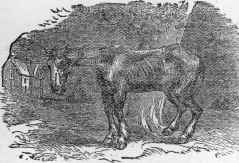
A Horse suffering under Chronic Dysentery.
Treatment.—Give, thrice daily: Crude opium,
½ ounce; liquor potassæ, 1 ounce; chalk, 1
ounce; tincture of allspice, 1 ounce; alum, ½
ounce; ale, 1 quart. Should the horse belong
to a generous master, give one of the following
drinks thrice daily, upon the symptoms being
confirmed : Sulphuric ether, 1 ounce; laudanum,
3 ounces; liquor potassæ, ½ ounce; powdered
chalk, 1 ounce; tincture of catechu, 1 ounce;
cold linseed tea, 1 pint. Or, chloroform, ½ ounce;
extract of belladonna, ½ drachm; carbonate of
ammonia, 1 drachm; powdered camphor, ½
drachm ; tincture of oakbark, 1 ounce ; cold lin
seed tea, 1 pint. Feed lightly; dress frequently;
give a good bed and a roomy lodging.
Chronic Gastritis.—Symptoms.—Irregularity of
bowels and appetite; pallid membranes; mouth
cold ; a dry cough ; tainted breath ; sunken eye ;
catching respiration; pendulous belly; ragged
coat, and emaciation. Sweating on the slightest
exertion; eating woodwork or bricks and mor
tar.
Treatment.—Do not purge; administer bitters,
sedatives an alkalies. Give powdered nux
vomica, 1 scruple; carbonate of potash, 1 drachm ;
extract of belladonna, ½ drachm ; extract of gen
tian and powdered quassia, of each a sufficiency.
Or give strychnia, ½ grain; bicarbonate of am
monia, 1 drachm; extract of belladonna, ½
drachm ; sulphate of zinc, ½ drachm ; extract of
gentian and powdered quassia, of each a suffi
ciency. Give one ball night and morning. When
these balls seem to have lost their power, give ½
ounce each of liquor arsenicalis and tincture of
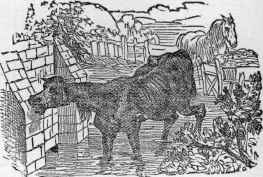
A Horse with Chronic Gastritis indulging its Morbid
Appetite.
ipecacuanha, with 1 ounce of muriated tincture
of iron and laudanum, in a pint of water; damp
the food; sprinkle magnesia on it. As the
strength improves, give sulphuric ether, 1 ounce,
and water, 1 pint, daily. Ultimately change that
for a quart of ale or stout daily.
Chronic Hepatitis.—Cause.—Too good food and
too little work.
Symptoms.—Cold mouth; pallid membranes;
white of eyes ghastly, displaying a yellow tinge;
looks toward the right side ; the right side may
be tender for a long time, with generally repeated
attacks of this nature, although the horse may
perish with the first fit.
Treatment.—Hold up the head; and if the
horse staggers, there is hemorrhage from the
liver. Give sufficient nutritious food, but only
enough, plenty of labor, and the following physic:
Iodide of potassium, 2 ounces; liquor potassæ, 1
quart. Dose, night and morning, two tablespoon
fuls in a pint of water.
Clap of the Back Sinews.—Cause.—Extra exertion.
Symptoms.—The maimed limb is flexed ; the
toe rests upon the ground. In a short space a
tumor appears ; it is small, hot, soft and tender,
but soon grows hard. Great pain, but attended
with few constitutional symptoms.
Treatment. — Administer physic, and bleed
gently; then give a few doses of febrifuge medi
cine, but go no further than to reduce the pulse
to fifty-five degrees. Put a linen bandage on the
leg; keep this constantly wet until the primary
HORSES AND THEIR MANAGEMENT. 171
symptoms abate. Cut grass for food while fever
exists; continue the cold water till recovery is

The Earliest Symptom
of Clap of the Back
Sinews, or Severe
Sprain of the Tendon.

The Blemish left by
Clap of the Back
Sinews.
confirmed. The horse will not be fit to work for
many months.
Cold.—If mild, a few mashes, an extra rug and
a slight rest generally accomplish a cure.
Symptoms of severe cold are dullness; a rough
coat; the body of different temperatures; the
nasal membrane deep scarlet, or of a leaden
color; the appetite is lost; simple ophthalmia;
tears; the sinuses are clogged, and a discharge
from the nose appears.
Treatment.—Give no active medicine. Apply
the steaming nosebag six times daily; allow cut
grass and mashes for food, with gruel for drink.
If weak, present three feeds of crushed and
scalded oats and beans daily, with a pot of stout
morning and evening. Good nursing, with pure
air, warmth, and not even exercise, till the dis-
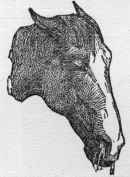
A Horse’s Head exhibiting a Cold.
ease abates, are of more importance than “ doc-
tor’s stuff” in a case of severe cold. Cold, how
ever, often ushers in other and more dangerous
diseases.
Congestion in the Field.—Cause.—Riding a horse
when out of condition.
Symptoms.—The horse, from exhaustion, reels
and falls. The body is clammy cold ; the breath
ing is labored ; every vein is turgid.
Treatment. — Bleed, if possible; cover the
body; lead gently to the nearest stable; keep
hot rugs upon the animal; bandage tne legs and
hood the neck ; warm the place, either by a fire
or tubs full of hot water. Give quietly, every
half-hour, 1 ounce of sulphuric ether, ½ ounce of
laudanum, ½ pint of cold water. Beat up 2
ounces of turpentine with the yelk of an egg;
mix it with ½ pint of water, and repeat the dose
at the times stated. Allow an ample bed, and
place a pail of gruel within easy reach of the
horse. Do not leave the animal for thirty hours,
as in that time its fate will be decided.
Congestion in the Stable.—Cause.—A debilitated,
fat horse, unused to work, being driven fast with
a heavy load.
Symptoms.—Hanging head ; food not glanced
at; blowing; artery gorged and round; pulse
feeble; cold and partial perspirations ; feet cold ;
eye fixed ; hearing lost; and the attitude motion
less.
Treatment.—Give immediately 2 ounces each
of sulphuric ether and of laudanum in a pint of
cold water. Give the drink with every caution.
In ten minutes repeat the medicine, if necessary.
Wait twenty minutes, and give another drink, if
requisite; more are seldom needed. Take away
all solid food, and allow gruel for the remainder
of the day.
Corns.—Cause.—In a flat foot, the heels of the
coffin-bone squeeze the sensitive sole by pressing
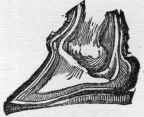
Diagram.
Showing the position of the hindermost part of the coffin-bone
when in a passive state; also portraying the shoe in the fleshy
or flat foot.
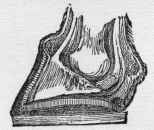
Diagram.
Illustrating the relative positions of the wings of the coffin-
bone, and the thick, concave horny sole of the contracted
foot when not in motion.
it against the shoe. In a contracted foot, the
sensitive sole is squeezed between the wings of
the coffin-bone and the thick horny sole. A
172 THE FRIEND OF ALL.
bruise results; blood is effused; and the stain of
this left upon the horny sole—generally upon the
inner side and anterior to the bars—constitutes a
horse's corn, which is mostly found on the fore
feet.
Symptoms.—If the stain is dark, and is to be re
moved with the knife, this indicates that a corn
was there, but no longer exists. The smallest
stain of bright scarlet testifies to the existence of
a new and present corn. Corns are of four kinds
—the old, the new, the sappy and the suppura-
tive. The old and new are produced by the blood,
and are judged by the scarlet or dark-colored
stain. The old is generally near the surface, the
new is commonly deep seated. The sappy is
when the bruise is only heavy enough to effuse
serum. The new corn alone produces lameness.
The suppurating corn may start up from either of
the others receiving additional injury. It causes
intense pain and produces acute lameness.
Treatment.—Cut out the stain. If a suppurat
ing corn, place the foot in a
poultice, after having opened
the abscess. Then, the horn
being softened, cut away all
the sole which has been re
leased by the pus from its at
tachment to the secreting sur
face. Tack on an old shoe,
and dress with the solution
of the chloride of zinc, 1 grain
to the ounce. Afterward shoe
with leather, and employ stop
ping to render the horn plastic.
Cough.—Causes.—Foul stables; hot stables;
coarse, dusty provender; rank bedding; irregular
work; while the affection may attend many
diseases.
Treatment.—Crush the oats; damp the hay ;
give gruel or linseed tea for drink. Clothe
warmly, and give, thrice daily, ½ pint of the follow
ing in a tumbler of water: Extract of belladonna,
1 drachm, rubbed down in a pint of cold water;
tincture of squills, 10 ounces; tincture of ipe
cacuanha, 8 ounces. No change ensuing,
next try Barbadoes or common tar, ½ ounce;
calomel, 5 grains; linseed meal, a sufficiency.
Make into a ball, and give one night and morn
ing. This being attended with no improvement,
employ powdered aloes, 1 drachm; balsam of
copaiba, 3 drachms; cantharides, 3 grains; com
mon mass, a sufficiency. Mix, and give every
morning.
A daily bundle of cut grass is good in the
spring of the year. A lump of rock-salt may be
beneficial. If the animal eats the litter, muzzle
it. Roots are good. Moisten the hay; and,
above all things, attend to the ventilation of the
stable.

The Posterior of a
Horse‘s Foot Shod
with Leather.
The central angular
mark indicates the
place into which the
iquid stopping should
be poured.
Cracked Heels.—Cause.—Cutting the hair from
the heels, and turning into
a straw-yard during winter.
Symptoms. — Thickened
skin; cracks; and some
times ulceration.
Treatment.—Wash; dry
thoroughly; apply the fol-
lowingwash: Animal glyce
rine, ½ pint; chloride of
zinc, 2 drachms; strong so
lution of oak-bark, 1 pint.
Mix. If ulceration has
commenced, rest the horse.
Give a few bran mashes or
a little cut grass to open the
bowels. Use the next wash: Animal glycerine,
or phosphoric acid, 2 ounces; permanganate of
potash or creosote, ½ ounce; water, 3 ounces.
Apply six times daily. Give a drink each day
composed of liquor arsenicalis, ½ ounce; tincture
of muriate of iron, 1 ounce ; water, 1 pint.
Crib-Biting.—Cause.—Sameness of food and un
healthy stables, or indigestion.
Symptoms.—Placing the upper incisors against
some support, and, with some effort, emitting a
little wind.
Treatment.—Place a lump of rock-salt in the
manger; if that is not successful, add a lump of
chalk. Then damp the food, and sprinkle mag
nesia upon it, and mingle a handful of ground
oak-bark with each feed of corn. Purify the
ventilation of the stable before these remedies
are applied.
Curb.—Causes.—Galloping on uneven ground;
wrenching the limb; prancing and leaping.
Symptom.—A bulging out at the posterior of
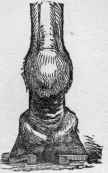
The Heel of a Horse in a
Cracked Condition.

A Curb.

An India-rubber Bandage,
FOR KEEPING WetCloths
upon a Curb.
the hock, accompanied by heat and pain, often
by lameness.
Treatment.—Rest the animal. Put on an
India-rubber bandage, and under it a folded
cloth. Keep the cloth wet and cool with cold
water. When all inflammation has disappeared,
blister the hock.
HORSES AND THEIR MANAGEMENT. 173
Symptoms.—Those common to pain and inflam
mation. Urine, however, affords the principal
indication. At first, it is at intervals jerked forth
in small quantities. Ultimately it flows forth
constantly drop by drop. Press the flank, which,
should cystitis be present, will call forth resis
tance.
Treatment. — Give scruple doses of aconite,
should the pulse be excited; the same of bella
donna, should pain be excessive; and calomel
with opium, to arrest the disease. Place under
the belly, by means of a rug, a cloth soaked with
strong liquor ammonia diluted with six times its
bulk of water. Or apply a rug dipped into hot
water or loaded with cold water; change when
either becomes warm.
Diabetes Insipidus, or Profuse Staling.—Causes.—
Diuretic drugs or bad food.
Symptoms.—Weakness; loss of flesh; loss of
condition.
Treatment. — Do not take from the stable ;
keep a pail of linseed tea in the manger; give no
grass or hay; groom well. Order a ball com
posed of iodide of iron, 1 drachm; honey and
linseed meal, a sufficiency. Or a drink consist
ing of phosphoric acid, 1 ounce ; water, 1 pint.
Give the ball daily; the drink, at night and at
morning.
Enteritis.—Causes.—Greatly conjectural. Pro
longed colic may end in it. Constipation may
induce it.
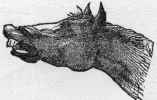
The Nose strained violently upward is a General Symp
tom of Abdominal Irritation.
Symptoms. — Dullness; heaviness; picks the
food ; shivers repeatedly; rolling; plunging;
kicking, but more gently than in spasmodic colic;
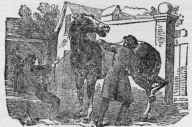
The Test of Pressure to the Abdomen for Enteritis.
quickened breathing; hot, dry mouth; wiry pulse.
Pressure to the abdomen gives pain. Insert the
arm up the anus: if the intestines are very hot,
all is confirmed.
Treatment.—Extract 1 quart of blood from the
jugular, and inject into the vein 1 pint of water
at a blood heat. Give aconite in powder, ½
drachm; sulphuric ether, 3 ounces; laudanum, 3
ounces; extract of belladonna, 1 drachm (rubbed
down in cold water, 1½ pints). As the pulse
changes, withdraw the aconite ; as the pain sub
sides, discontinue the belladonna. The other in
gredients may be diminished as the horse ap
pears to be more comfortable. Should the pain
linger after the administration of the eighth
drink, apply an ammoniacal blister. Sprinkle on
the tongue, if any symptoms declare the disease
vanquished but not fled, every second hour, ca
lomel, ½ drachm; opium, 1 drachm. Feed very
carefully upon recovery, avoiding all things pur
gative or harsh to the bowels.
Epizoöty, or Epizoötic. See Influenza.
Excoriated Angles of the Mouth.—Cause.—Abuse
of the reins.
Treatment.—Apply the following lotion to the
part: Chloride of zinc, 2 scruples; essence of
anise-seed, 2 drachms; water, 2 pints.
False Quarter.—Cause.—Injury to the coronet,
producing an absence of the secreting coronet of
the crust from the hoof.
Symptoms.—No lameness, but weakness of the
foot. The soft horn of the laminae, being ex
posed, is apt to crack. Bleeding ensues. Some
times granulations sprout when the pain and the
lameness are most acute.
Treatment.—In cases of crack and granula
tions, treat as is advised for sandcrack. Put on
a bar-shoe, with a clip on each side of the false
quarter. Pare down the edges of the crack, and
ease off the point of bearing on the false quarter.
A piece of gutta-percha, fastened over the false
quarter, has done good.
Farcy.—Causes. — Excessive labor, poor food
and bad lodging, with old age.
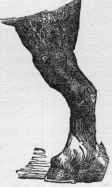
Farcy on the inside of the
Horse's Thigh, where the
Skin is thin and the Hair
almost absent.
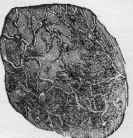
A Portion of Skin, taken
from a Farcied Horse,
injected with mercury.
Symptoms. — Inflammation of the superficial
absorbents. Lumps appear on various parts, 11
174 THE FRIEND OF ALL.
these lumps are opened, healthy matter is re
leased ; but the place soon becomes a foul ulcer,
from which bunches of fungoid granulations
sprout. From the lumps may be traced little
cords leading to other swellings. The appetite
fails, or else it is voracious. Matter may be
squeezed through the skin. Thirst is torturing.
At length glanders breaks forth, and the animal
dies. There is a smaller kind of farcy called
button-farcy; the smaller sort is the more viru
lent of the two.
Cure.—There is no known cure for the disease.
Fistulous Parotid Duct—The parotid duct is the
tube by which the saliva secreted by the gland
is, during the act of mastication, conveyed into
the mouth and mingled with the food. The pa
rotid gland lies at the spot where the neck joins
the jaw; within the interior of that body nume
rous fine hollow vessels connect and unite.
These at each junction become larger and fewer
in number, till at length they all terminate in
one channel.
Causes.—Hayseed or other substances getting
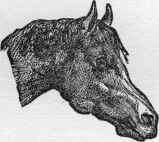
The Parotid Duct distended by a Salivary Calculus.
into the mouth of the duct during mastication.
Stones being formed within the canal. The
stable-fork in the hand of an intemperate groom.
Symptoms.—The duct greatly enlarges behind
the obstacle, which, becoming swollen, prevents
the secretion from entering the mouth. Great
agony is occasioned by every mouthful masti
cated. The duct bursts, and a fistulous opening
is established, through which the saliva jerks at
each motion of the jaw. From the absence of a
secretion important to digestion, the flesh wastes,
and the animal soon assumes a miserable appear
ance.
Treatment.—Make an adhesive fluid with gum
mastic and spirits of wine, or with India-rubber
and sulphuric ether. When the horse is not
feeding, pare the hardened edges from the
wound; cover the orifice with a piece of strained
India-rubber; over this put a layer of cotton;
fasten one end to the horse's cheek by means of
the adhesive fluid; that having dried, fasten the
other end tightly down. Place other layers of
cotton over this, allowing each layer to cross the
other, and fastening all to the cheek. Fasten
the head to the pillar-reins; allow the horse to
remain till the cotton falls off, and give only
gruel for food. Put tan under the feet; and
should the first trial not succeed, repeat it.
Fistulous Withers. — Cause. — External injury,
generally by a lady's saddle, which bruises one
of the bursæ placed above the withers.
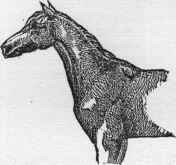
The Slight Enlargement which, badly treated or unat
tended to, MAY END IN FlSTULOUS WITHERS.
Symptoms.—When first done, a small round
swelling appears on the off side. If this is neg
lected, the place enlarges, and numerous holes
burst out, which are the mouths of so many fis-
tulous pipes.
Treatment.—In the early stage, open the tumor
and divide it. Touch the interior with lunar
caustic; keep the wound moist with the chloride-
of-zinc lotion, one grain to the ounce of water,
and cover it with a cloth dipped in a solution of
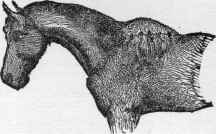
A Horse with Fistulous Withers in the Worst Stage.
tar. If the sinuses are established, make one cut
to embrace as many as possible. Clean out the
corruption. Scrape or cut off any black or white
bone which may be exposed. Cover with a cloth,
and keep wet with the solution of chloride of
zinc. Should there exist a long sinus leading
from the withers to the elbow, insert a seton by
means of the guarded seton-needle. This seton
should be withdrawn as soon as a stream of
creamy pus is emitted.
Fungoid Tumors in the Eye.—Cause.—Unknown.
Symptoms.—Blindness; a yellow, metallic ap
pearance to be seen in the eye.
Treatment.—None of any service
HORSES AND THEIR MANAGEMENT. 175
Glanders.—Cause. — Bad lodging, stimulating
food, and excessive work operating upon young
life.
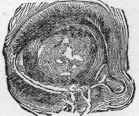
Fungus Hæmatoides, or Cancerous Growths within the Sub
stance of the Eye.
Symptoms.—Staring coat; lungs or air-passages
always affected; flesh fades; glands swell; spirits
low; appetite bad. A lymphatic gland adheres

The Primary Discharge op
Glanders. Simply a
Slight Watery Deflux-
ion.

The Secondary Discharge.
A Thick and Copious but
still Transparent Excre
tion, CONTAINING PIECES
and Threads of Mucus.
to the inside of the jaw; the membrane inside
the nose ulcerates; a slight discharge from one
nostril. This becomes thicker, and adheres to

The Third, or Suppurative
Stage of Glanders.

The Fourth, or Last Stage
of Glanders.
the margin of the nostril, exhibiting white
threads and bits of mucus; then it changes to a
full stream of foul pus; next the nasal membrane
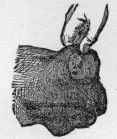
The Proof of Glanders.
1. Termination of the lachrymal duct—a natural develop
ment.
2. A discolored membrane, disfigured by ulcerative patches.
grows dull and dropsical; the margins of the
nostrils enlarge; the horse breathes with diffi
culty; the discharge turns discolored and abhor
rent ; farcy breaks forth, and the animal dies of
suffocation.
Treatment.— There is no known cure. The
contagion is dangerous to man and beast. Kill
the animal as soon as you are certain it has glan
ders.
Grease —Causes.— Age; debility; excessive
labor; neglect; filth. Cutting the hair off the
heels ; turning out to grass in the cold months.
Symptoms.—Scurfiness and itchiness of the
legs. Rubbing the leg with the hoof of the
opposite limb ; hairs stand on end; moisture
exudes, and hangs upon the hairs in drops.
Smells abhorrently; lameness; cracks on the
skin ; swelling; ulceration ; thin discharge; odor
worse. Lameness increases ; leg enlarges ; gra
nulations sprout in ragged bunches ; their points
harden and become like horn ; pain excessive;
horn of hoof grows long.
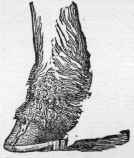
First Stage of Confirmed
Grease Exudation.
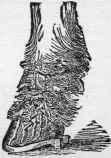
Second Stage of Confirmed
Grease Cracks.
Treatment.—Cut off all remaining hair. If
hot and scurfy, cleanse with mild soap and hot,
soft water; saturate a cloth with the following
lotion : Animal glycerine, ½ pint; chloride of
zinc, ½ ounce; water, 6 quarts. Lay it upon the
leg. When this cloth becomes warm, remove it,
and apply another, also wet with the lotion ; thus
continue applying cool cloths to the limb till
the heat abates ; afterward moisten the leg thrice
daily. When cracks and ulceration are present,
adopt the wet cloths; but subsequently use one of
the following to the sores : Permanganate of pot
ash or phosphoric acid, 1 pint; water, 6 quarts.
Or chloride of zinc, 1 ounce; water, 1 gallon :
employ thrice daily. If the granulations have
sprouted, remove them with a knife, in three ope
rations. Always place in a loose box. Feed libe
rally; allow old beans ; give a handful of ground
oak-bark with each feed of oats. Night and
morning give liquor arsenicalis, 1 ounce ; tincture
of muriate of iron, 1½ ounces; porter or stout, 1
quart:; 1 pint for the dose. Chopped roots;
speared wheat; hay tea; cut grass, and exercise
are all good for grease.
Gutta Serena. —Cause.—Over-exertion.
Symptoms.—Fixed dilatation of the pupil; a
176 THE FRIEND OF ALL.
greenish hue of the eye; total blindness. Active
ears; restless nostrils; head erect; high step
ping ; occasionally a rough coat in summer and
a smooth coat in winter.
Treatment,—No remedy is possible.
Heart-Disease.—Symptoms.—Auscultation. The
beat of the heart to be seen externally; haggard
countenance : pulse feeble; heart throbs; the
beat of the carotid artery is to be felt; the re-
gurgitation in the jugular is to be seen. The
appetite is sometimes ravenous—often fastidious;
the breathing is not accelerated excepting during
pain ; lameness of one leg; dropsical swellings;
stopping short when on a journey; averse to
turn in the stall; noises; yawns; sighs. Death
always unexpected. No treatment is of any use.
Hematuria, or Bloody Urine.—Cause.—Unknown.
Symptoms.—Discoloration of the fluid. When
the bleeding is copious, breathing is oppressed;
the pupils of the eyes are dilated. Pulse is lost;
head is pendulous; membranes are pale and cold.
Lifting up the head produces staggering. Back
roached ; flanks tucked up; legs wide apart.
Treatment.—Be gentle. Give acetate of lead,
2 drachms, in cold water, 1 pint; or as a ball, if
one can be delivered. In a quarter of an hour
repeat the dose, adding laudanum, 1 ounce, or
powdered opium, 2 drachms. Repeat the physic
till an ounce of acetate of lead has been given.
Leave the horse undisturbed for two hours, if the
symptoms justify delay. If not, dash pailfuls of
cold water upon the loins from a height. Give
copious injections of cold water. Pour ½ pint
of boiling water upon 4 drachms of ergot of rye.
When cold, add laudanum, 1 ounce, and dilute
acetic acid, 4 ounces. Give two of these drinks,
and two cold enemas, of twenty minutes’ dura
tion. Suspend all treatment for eight hours,
when the measures may be repeated.
Hide-Bound,—Cause.—Neglect, or turning into a
straw-yard for the winter.
Treatment.—Liberal food, clean lodging, soft
bed, healthy exercise and good grooming. Ad
minister, daily, two drinks, composed of liquor
arsenicalis, ½ ounce: tincture of muriate of iron,
1 ounce; water, 1 pint Mix, and give as one
dose.
High-Blowing and Wheezing.—Habits which admit
of no remedies.
hydrophobia.—Cause.—Bite from a rabid dog or
cat.
Symptoms,—The horse is constantly licking the
bitten place, A morbid change takes place in
the appetite. Eager thirst, but inability to drink,
or spasm at the sound or sight of water is exhibi
ted. Nervous excitability; voice and expression
of countenance altered. More rarely the horse—
when taken from the stable—appears well.
While at work, it stops and threatens to fall.
Shivers violently, and is scarcely brought home
when the savage stage commences. The latter

The Countenance of a Horse with Hydrophobia.
development consists in the utmost ferocity,
blended with a most mischievous cunning, or a
malicious pleasure in destruction.
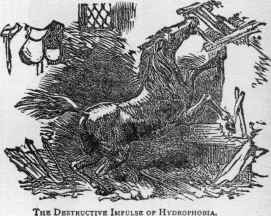
Treatment.—No remedy known. Confine in a
strong place, and shoot immediately.
Hydrothorax, or Dropsy of the Chest—Cause.—
Pleurisy, or inflammation of the membrane lining
the chest.
Symptoms.—The horse is left very ill. The
next morning the animal is looking better; the
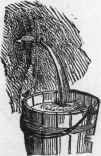
Removing the Fluid in Hydrothorax.
pain has abated ; the eye is more cheerful; but
the flanks heave. Strike the chest while the
person listens on the other side: a metallic ring
follows; the pulse is lost at the jaw; the heart
HORSES AND THEIR MANAGEMENT.
177
seems to throb through water. The horse has
hydrothorax.
Treatment.—The first thing is to draw off the
fluid. A spot between the eighth and ninth ribs
is chosen, and the skin is pulled back; a small
slit through the skin is made; into that opening
a fine trocar is driven. When there is no resist
ance felt, the thorax has been entered ; the stilet
is withdrawn and the water flows forth. Should
the horse appear faint, withdraw the instrument,
and in two hours again puncture the chest. Af
terward the food must be prepared, and a ball
administered night and morning, consisting of
iodide of iron, 1 drachm; strychnia, ½ grain;
sulphate of zinc, ½ drachm; extract of gentian
and powdered quassia, a sufficiency.
Impediment in the Lachrymal Duct. — Cause.—A
hayseed or other substance getting into and be
coming swollen within the duct.
Symptoms.—Swollen lid and copious tears.
Treatment.—Inject, forcibly, a stream of water
up the duct.
Inflammation of the Brain.—See Phrenitis.
Influenza. — Cause. — Unknown ; but suspected
to be generated by close stables. Called also
Epizoöty, or the Epizoötic.
Symptoms. — Weakness and stupidity; local
swellings; heat and pain in the limbs. Loss of
appetite; rapid wasting; every part of the body is
diseased. Youth most exposed, but no age ex
empt. Spring-time the general season, but an
attack may ensue at any period of the year. The
following symptoms are somewhat uncertain:
Pendulous head ; short breath; inflamed mem
branes ; swollen lips; dry mouth ; enlarged eye
lids ; copious tears; sore throat; tucked-up flanks;
compressed tail; filled legs; big joints; lameness
and hot feet. Auscultation may detect a grating
sound at the chest, or a noise like brickbats fall
ing downstairs, within the windpipe. When the
last is audible, there is always a copious discharge.
Sometimes one foot is painful; purgation has been
seen; but constipation is generally present, and
the horse usually stands throughout the disease.
Always suspect influenza when it is in the neigh
borhood, and the membranes are yellow or in
flamed.
Treatment.—Move to a well-littered, warm, loose
box. Suspend a pail of gruel from the wall;
change the gruel thrice daily; sprinkle on the
tongue, night and morning, calomel, 1 scruple;
wash this down with sulphuric ether, 1 ounce;
laudanum, 1 ounce; water, ½ pint. If weakness
increases, double the quantity of ether and of
laudanum. When the pulse loses all wiry feeling,
and the discharge becomes copious, give from the
hand some bread, on which there is a little salt;
when the cough appears, give a pot of stout daily.
Beware of purgatives or active treatment.
Injuries to the Jaw.—Causes.—Pulling the snaffle ;
abuse of the bit; too tight a curb-chain.
Symptotns.—Discoloration before or behind the
tush ; bruise under the tongue or upon the roof
of the mouth ; tumor and bony growth upon the
margin of the lower jaw.
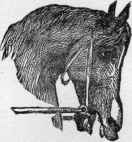
The Snaffle bearing upon the Lower Jaw.
Treatment.—Cut upon the discoloration till the
knife reaches the bone; if fetor is present, inject
the chloride-of-zinc lotion; keep the wounds open,
that the injured bone may come away.
Lacerated Eyelid.—Causes.—Nails in the gang
way, or the horses snapping at each other.
Treatment. — Bathe with cold water till the
bleeding ceases; allow the separated parts to re
main until the divided edges are sticky; bring to
gether with sutures; place the horse in the pillar-
reins till the healing is perfected.
Lacerated Tongue.—Causes.—Sticking to a horse
when giving physic; making a “chaw” of the
halter-rope.
Treatment.—Insert no sutures; if the arterie
are excised, cut off the hanging portion of the
tongue; should the vessels have escaped, allow
all to remain; feed on gruel and soft food ; after
every meal wash out the mouth with the solution
ordered for aphtha, or with the chloride-of-zinc
lotion.
Laminitis (Subacute).—Causes.—Age; long stand
ing in the stable ; overwork, and stinted diet.
Symptoms.—First noticed by
the manner of going upon the
heels of the forefeet.
Treatment.—Get into slings.
Remove the shoes. Do not
bleed. Give a quart of stout,
night and morning. Allow two
drinks per day, each consisting
of 1 ounce of sulphuric ether
and ½ pint of water ; ½ drachm doses of bella
donna, to allay pain; sound oats and old beans,
both crushed, for food; water to be whitened; no
hay. No limit to this food, but five feeds to be
given if the horse will eat so much.
Laryngitis. —Cause.—Foul stables.
Symptoms.—Dullness ; enlargement over the
larvnx; stiff neck; short and suppressed cough;

The Deformity
which ensues upon
dropping of the
coffin-bone.
12
178
THE FRIEND OF ALL.
breathing hurried and catching; pulse full; nasal
membrane almost scarlet.
Treatment.—Give drachm doses of tincture of
aconite, in wineglasses of water, every half-hour,
to amend the pulse. Refrain from bleeding. Put
on a steaming nosebag, and keep it almost con
stantly applied, to amend the breathing. Fix some
hay, soaked in boiling water, upon the throat, by
means of an eight-tailed bandage. Give, very
carefully, the following drink, thrice daily: Infu
sion of squills, 2 ounces; infusion of ipecacuanha,
2 ounces; infusion of aconite, ½ ounce; extract of
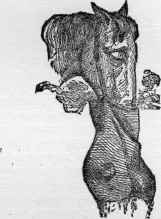
Steaming the Nose of a Horse with Cold.
belladonna, 1 drachm, rubbed down with a pint
of warm water. Place in a cool, well-aired,
thickly - littered, loose box; bandage the legs;
clothe the body; give only gruel for food, chang
ing it thrice daily. On improvement, a little
moist food may be allowed. When improvement
is confirmed, put a seton under the throat. Blis
ter the throat; pick and damp the hay; sift,
bruise and scald the oats. Employ no lowering
agents.
Larva in the Skin.—Causes.—Turning out to
grass. The fly lays its egg upon the hair, the
warmth of the body hatches it, and the larva
enters the skin. The next summer a tolerably
large abscess is established, the insect occupying
its center.
Treatment.—With a lancet open the abscess, and
squeeze out the larva. Dab the wound with a
lotion made of chloride of zinc, 1 grain; water, 1
ounce.
Lice.—Causes.—Filth and debility.
Treatment.—Rub the skin with some cheap oil
or grease. Wash, and then look for other dis
eases, as hidebound, mange, etc.
Luxation of the Patella.—Cause.—Bad food and
constitutional weakness.
Symptoms.—The horse stops short, and has one
of the hind legs extended backward. A swelling
upon the outer side. The pastern is flexed, the
head raised, and the animal in great pain. In
colts it will sometimes appear on the slightest
cause.
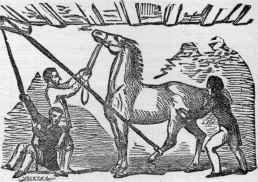
The Manner of returning the Patella of an Adult
Animal.
Treatment.—For colts, any flurry may restore
the bone; but feed well, to eradicate the weak
ness. For horses, get into a shed, and, throwing
a rope one end of which has been fixed to the
pastern, have the leg dragged forward while some
one pushes the bone into its place. A man should
be put to keep the bone in its situation for some
hours. Give strengthening food, and do not use
for six weeks subsequently.
Mallenders and Sal lenders.—Cause.—Neglect.
Symptoms.—Scurf upon the seats of flexion;
mallenders at the back of the knee, and sallen-
ders at the front of the hock.
Treatment.—Cleanliness. Give the liquor-arse-
nicalis drink, recommended for grease. Change
the groom. Rub the parts with this ointment:
Animal glycerine, 1 ounce; mercurial ointment,
2 drachms; powdered camphor, 2 drachms; sper
maceti, 1 ounce. If cracks appear, treat as though
cracked heels were present.
Mange.—Causes.—Starvation ; bad lodging and
no grooming; turning out to grass.
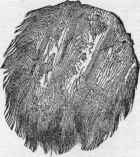
A Mangy Piece of Skin.
Symptoms.—Scurf about the hairs of the mane ,
the hair falls off in patches; the skin is corru
gated ; a few hairs remain upon the bare places,
and these adhere firmly to the skin; scrubbing
the body against posts; sores and crusts. To
HORSES AND THEIR MANAGEMENT.
179
test its presence, scratch the roots of the mane,
and the horse will exhibit pleasure.
Treatment.—Place the horse in the sunshine,
or in a heated house, for one hour ; then whisk
thoroughly, to remove scurf and scabs ; then rub
in the following liniment: Animal glycerine, 2
parts; oil of tar, 2 parts ; oil of turpentine ½ part;
oil of juniper, ½ part. Mix. Leave on for two
days; wash ; anoint again ; wash; anoint and wash
once more, always leaving the liniment on for two
clear days.
Megrims.—Cause.—Unknown.
Symptoms.—The horse suddenly stops; shakes
the head; strange stubbornness may be exhibited,
followed by a desire to run into dangerous places.
Then ensues insensibility, accompanied by con
vulsions.
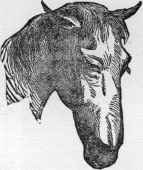
The Expression characteristic of repeated Attacks of
Megrims.
Treatment.—Throw up on the first fit. Give
a long rest, and try to amend the constitution.
Melanosis. — Cause. — Unknown. The disease
only attacks gray horses which have become
white.
Symptoms.—It appears as a lump of uncertain
form, size and situation. The swelling, if cut
into, discloses a cartilaginous structure, dotted
here and there with black spots. Do not use the
knife unless the swelling impede the usefulness,
or should be peculiarly well placed for operation.
Feel the tail. A pimple on the dock is an almost
certain sign of melanosis, which disease affects
the internal organs even more virulently than it
attacks the external parts. As melanosis pro
ceeds, all spirit departs, and the animal is at
length destroyed as utterly useless.
Treatment.—Let the tumor alone. Forbid all
use of the currycomb. Dress very long and very
gently with the brush only. Twice a week anoint
the body with animal glycerine, 1 part; rose-water,
2 parts.
Nasal Gleet.—Causes.—Decayed molar tooth ;
kicks from other horses ; injuries to the frontal
bones, or neglected catarrh.
Symptoms.—Distortion of the face; partial en
largement and softening of the facial bones; ir
regular discharge of fetid pus from one nostril.
The discharge is increased, or brought down by
feeding off the ground, or by trotting fast.
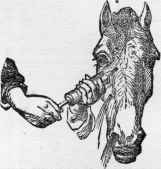
Injecting the Head of a Horse for Nasal Gleet.
Treatment.—Surgical operation, with injection
of a weak solution of chloride of zinc. Also give
daily a ball composed of balsam of copaiba, ½
ounce; powdered cantharides, 4 grains; cubebs,
a sufficiency. If the foregoing should affect the
urinary system, change it for ½drachm doses of
extract of belladonna, dissolved in a wineglass of

Part of a Horse‘s Head which has the Bone trephined
so as to enable the surgeon to empty the turbinated
Bone. The Course of the Nerves is shown.
water. Give these every fourth day, and on such
occasions repeat the belladonna every hour.
Nasal Polypus.—Symptoms.—An enlarged nos
tril; a copious mucous discharge; signs of suf
focation, if the free nostril be stopped ; a cough
generally forces down the growth.
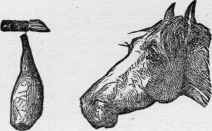
A Polypus. Nasal Polypus.
Treatment. — Surgical operation, which re
moves the tumor.
Navicular Disease.—Causes.—Frog pressure, and
not shoeing with a leathern sole. The unpro
tected foot treads on a rolling stone, and navicu-
lar disease is the result.
Symptoms.—Acute lameness; this disappears
but may come again in six or nine months.
180
THE FRIEND OF ALL.
Acute lameness is then present for a longer time
while the subsequent soundness is more short.
Thus the disease progresses, till the horse is
lame for life. The pain in one foot causes greater
stress upon the sound leg, and from this cause
both feet are ultimately affected. The foot is
pointed in the stable. The bulk diminishes,
while the hoof thickens and contracts. The
horse, when trotting, takes short steps, and upon
the toe, going groggily.

A Diagram to explain the Seat of Navicular Disease.
a. The perforans tendon running beneath the bone, and on
which the bone reposes.
b. The comparative size and relative situation of the navicular
bone.
c. The synovial sac which facilitates the motion of the bone
on the tendon; upon the superior surface of this sac navicu-
lar disease is alone exhibited.
Treatment.—Feed liberally upon crushed oats
and old beans. Soak the foot every other night
in hot water. Afterward bandage the leg, fix on
tips, and having smeared
the horn with glycerine, put
on a sponge-boot. Rest
very long—six months in
the first instance—and then
give three months’ agricul
tural employment. In bad
cases resort to neurotomy,
but do so upon the second
attack of lameness ; because
continued disease disorgan
izes the internal structures of the hoof, and also
occasions the sound foot to be attacked by nav-
icular disease.
Nephritis, or Inflammation of the Kidneys.—Causes.
—Bad provender, or niter in a mash, and long or
fast work upon the following day.
Symptoms.—Hard, quick pulse; short breath
ing; pallid membranes; looking at the loins;
depressed head; roached back; hind legs strad
dling; scanty urine; refusing to turn in the
stall; and crouching under pressure on the loins.
Subsequently, pus is voided with the water. If
the urine has a fetid odor, if blood be present, if
the pulse grows quicker, if pressure gives no
pain, and if the perspiration has a urinous smell,
death is near at hand. To be certain of nephritis,
insert the arm up the rectum and move the hand
toward the kidneys.
Treatment.—Rub mustard into the skin of the
loins. Cover it over to prevent it becoming dry.
Apply fresh sheepskins as soon as these can be
procured. Inject warm linseed tea every hour.

The Upright Pastern
and Hard, Unyielding
Hoof, indicative of
CONFIRMED NAVICULAR
Disease.
A ball composed of Croton farina, 2 scruples;
extract of belladonna, ½ drachm ; treacle and lin
seed meal, a sufficiency, should be given imme
diately; 1 scruple of calomel; 1 drachm of opium
should be sprinkled on the tongue every hour.
A pail of linseed tea may be placed in the man
ger. Feed on linseed tea, and mind the oats—
when allowed—are very good. While the pain
is acute, give, thrice daily, a ball composed of
extract of belladonna, ½ drachm ; crude opium, 2
drachms; honey and linseed meal, of each a suf-
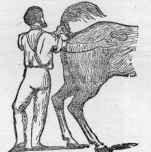
A Certain Test for Inflammation of the Kidneys.
ficiency. When the pain is excessive, repeat the
above ball every hour. Should the pulse in
crease and become wiry, a scruple of aconite
should be thrown upon the tongue every half-
hour until the artery softens, or the animal be
comes affected with the drug.
No cure is to be expected; the disease may be
arrested, but the kidney will be left in an irrita
ble state.
Occult Spavin.—Cause.—Treading on a stone.
Symptoms.—Sudden lameness, which never de
parts, but in the end becomes very bad. The
disease is always worse after work. The foot is
without disease, and the leg is not hot or painful;
yet the lameness continues and gets worse.
The leg is snatched up in the walk, and the foot
is not turned outward.
Treatment.—Get the horse into slings. Rub
the front of the hock with an embrocation com
posed of compound soap liniment, 16 ounces;
tincture of cantharides, liquor ammonia and lau
danum, of each two ounces. After the joint is
embrocated, wrap it round with flannel, held
upon the hock with elastic rings. Give three
feeds of corn, a few old beans and sweet hay
daily. After the horse bears upon the diseased
limb, allow the slings to remain for three months.
Three months after it has left the slings, put to
gentle work, but the labor must not be exhaust
ing. The work must not be full till six months
have elapsed. Keep the bowels regular with
bran mashes. If all treatment fail, cast the
horse; retract the injured limb; make a small
puncture, and inject one ounce of dilute spirits
of wine in which half a drachm of iodine has been
HORSES AND THETR MANAGEMENT. 181
dissolved. Place the horse in slings, and apply
cold water to the hock. When the pulse is
quiet, feed very liberally.
Open Synovial Cavities.—Causes.—The pride of
gentility, which apes what is not, and tries to
pass off a horse with a ewe neck for an animal
with a lofty crest. The quadruped, being in
pain and constraint, necessarily trips, and can
not save itself from falling. Kicking in harness ;
running away and being run into.
Symptoms.—Air being admitted creates inflam
mation, and this inflammation causes consti
tutional irritability. Bursæ are attended with
least danger when punctured ; sheaths of ten
dons are more dangerous; joints are by far the
most serious. Judge which of these has taken
place, by the extent of the wound and the
quantity of synovia released.
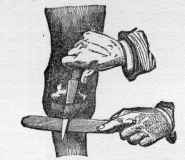
The Manner of opening the Dirt-sac, in case one should
be present with open joint.
Treatment.—Exercise gentleness toward the
injured animal. Wash as directed for broken
knees. Examine if there be any sac or bag into
which dirt could have entered. If one exists,
place a large spatula under the knee ; then take
a knife with a sharp point, but with its edge
blunted the two posterior thirds of its length;
guard the point with a lump of beeswax; intro
duce this into the sac and drive the point
through the bottom of the bag. An opening
will thereby be created, through which the pus
and dirt will gravitate. If the probe enters the
knee of the flexed leg, unopposed, three quarters
of an inch, push it no farther; be satisfied the
cavity is opened.
Open Synovial Joints.— Treatment.—Proceed in
the first instance as for broken knees. Then
give a drink composed of sulphuric ether and
laudanum, of each 1 ounce; water, ½ pint.
Look to the comfort. Should the eye rove, the
breathing be hard, ears active, and the horse
start at sounds, hourly repeat the drink before
recommended, till these symptoms abate. Then
place in a stall and allow four drinks and two
pots of stout daily. Use the arnica lotion as
for broken knees, during the first three and a
half days. At the end of that time turn the
horse gently round in the stall, and let it stand
with its head toward the gangways. Place the
slings before the horse, and leave the animal to
contemplate them for half an hour. Then, with
extreme gentleness, fix them ; but do not pull
the cloth up to the abdomen. Leave a pail of
water suspended from one pillar, and feed from
a high trough, supported upon light legs. Let
the horse be watched night and day for the re
mainder of the week. When the animal is at
ease in the slings, these may be heightened till
the cloth lightly touches, but not presses, against
the belly. With the slings change to the chlo-

Open Joint ensuing upon
Broken Knee, and sole
ly CAUSED BY THE ABUSE
of Bandages.

The General Appearance of
an Open Joint when first
submitted to the notice
of the Surgeon.
ride-of-zinc lotion, 1 scruple to the pint of water:
have this frequently applied during the day. It
will coagulate the albumen and promote the
healing of the wound. The albumen will accu
mulate as a large ball in front of the injury; do
not touch it. Allow it to fall off. The cure is
nearly perfect when it falls.
When pressure can be en
dured, the slings may be re
moved; though the healing
process should be confirmed
before the animal is allowed
to stand near anything against
which it could strike the knee.
Ossified Cartilages. — Cause.
—Battering the foot upon
hard roads.
Symptoms.—Of little con
sequence in heavy horses
unless accompaniedwith ring-
bone. The disease causes lameness in light horses
used for fast work.
Treatment.—Rest; liberal food; and small
blisters to the foot immediately above the sides
of the hoof.
Overreach.—Cause.—When a good stepper is
very tired, this accident sometimes happens :
the coronet of the fore foot upon the outer side
being severely wounded by the inside of the
hind shoe.

The Albuminous Ball,
which forms in Shape
of an Open Joint
when treated with
A Solution of Chlo
ride of Zinc.
182 THE FRIEND OF ALL.
Symptom.—A severe wound and a large
slough, probably followed by
a false quarter.
Treatment.—Feed liberally,
and bathe the injury thrice
daily with the chloride-of-zinc
lotion, 1 grain to the ounce of
water.
Partial Paralysis. — Cause. —
Violent exertion.
Symptom.—One hind leg gets
in the way of the other, and threatens to throw
the animal down.
Treatment.—A loose box; warm clothing;
good grooming; warmth to loins; regulate the
bowels with mashes ; absolute rest. Give the
following ball night and morning : Strychnia, ½
grain (gradually work this medicine up to 1½
grains); iodide of iron, 1 grain ; quassia powder
and treacle, a sufficiency.
Phlebitis, or Inflammation of the Vein.—Cause.—
Motion. Bleeding in the neck and turning out
to grass; or from either of the limbs, and then
forcing the animal to walk.
Symptoms.—The earliest indication is a separa
tion of the lips of the wound and the presence of
a small quantity of thin discharge. A small
swelling then takes place, and the vein hardens
above the puncture. Then abscesses form along
the course of the vessel. These mature, burst,
send forth a contaminated pus. The abscesses
are united by sinuses. If these signs are neglected,
a dark discharge resembling decayed blood issues
from the numerous wounds and soils the neck.
Dullness ensues; the brain becomes affected; and
the horse perishes phrenitic.

Overreach occur
ring DURING THE
Exhaustion of
Light Horses.

The Third Stage of Phlebitis.
Treatment.—Remove the pin and apply a blis
ter. Another may be required. In bad cases,
blister must follow blister, but not be rubbed in.
A little oil of cantharides should be put over the
sore with a paste-brush. Place in a loose box and
litter with tan; feed on slops, which require no
mastication. Let the horse remain there and be
so fed for six weeks subsequent to the cessation
of all treatment. Then give a little exercise at a
slow pace, gradually augmented. At the end of
three months the horse may do slow work. But
the horse should not wear a collar or go into the
shafts before the expiration of six months.
Phrenitis, or Inflammation of the Brain.—Causes.
—Various, often unknown.
Symptom.— Heaviness, succeeded by fury in
excess, but without any indication of malice.
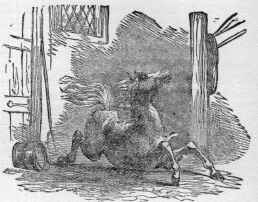
A Horse Mad, or with Inflammation of the Brain.
Treatment.—Bleed from both jugulars till the
animal drops. Then pin up, and give a purga
tive of double strength. Follow this with another
blood-letting, if necessary, and scruple doses of
tobacco; ½-drachm doses of aconite root; or
drachm doses of digitalis—whichever is soonest
obtained. But whichever is procured must be
infused in a pint of boiling water, and, when cool
and strained, it ought to be given every half-hour
till the animal becomes quiet. The probable re
sult is by no means cheering, even if death is by
these means avoided.
Pleurisy.—Causes.—Over - exertion ; blows; in
juries ; cold.
Symptoms.—These are quickly developed. The
pulse strikes the finger; pain continuous; agony
never ceases; horse does not feed. Body hot;
feet cold ; partial perspirations. Muscles corru
gated in places ; cough, when present, suppressed
and dry; auscultation detects a grating sound
and a dull murmur at the chest. Pressure be
tween the ribs produces great pain or makes the
animal resentful. The head is turned very often
toward the side; the forefoot paws ; the breathing
is short and jerking.
Treatment.—Should be active. Bleed, to ease
the horse; place in a loose box; bandage the
legs; leave the body unclothed. Give, every
quarter of an hour, a scruple of tincture of aco
nite in a wineglass of warm water. When pulse
has softened, give, every second hour, sulphuric
ether and laudanum, of each 1 ounce; water, ½
pint. Do not bleed a second time. Steam. Do
nothing for the bowels. Place lukewarm water
within easy reach of the head, and give nothing
more while the disease rages. When the disease
departs, return with caution to full food. After
the affection subsides, blister throat and chest
HORSES AND THEIR MANAGEMENT.
183
If the horse is costive, administer enemas; or a
bundle of cut grass may be presented with the
other food.
Pneumonia.—Causes.—Fat; irregular work; and
sudden exertion.
Symptoms. — Breathing labored ; oppressed
pulse; partial consciousness; giddiness. Stand
ing with outstretched legs; head and ears de
jected ; coat rough ; extremities and body cold ;
visible membranes discolored; bowels costive;
feeling half dead ; and general oppression.
Treatment.—Bleed but once; take only blood
sufficient to restore consciousness; do not attempt
to obtain blood, if the liquid flows black and thick.
Place in a loose box strewn with damp tan; take
off the shoes; place water within easy reach ; no
food. If winter, clothe ; then introduce steam ;
when the steam is abundant, take off the clothes.
Give solution of aconite root, ½ ounce; sulphuric
ether, 2 ounces; extract of belladonna (rubbed
down with ½ pint of water), 1 drachm. Repeat
the drink three times each day. When the pulse
improves, withdraw the aconite; when the breath
ing amends, omit the belladonna; or increase
either as pulse or breathing becomes worse.
Allow only hay tea, with a little oatmeal in it,
until the disease abates. On amendment, cau
tiously increase the food. Lying down is the first
sign of improvement. Do not disturb the ani
mal : it must require rest, having stood through
out the attack.
Poll Evil.—Causes.—Hanging back in the halter;
hitting the poll against the beam of the stable-
door; blows on the head ; and any external in
jury.
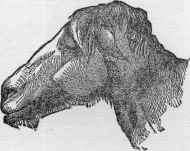
Poll Evil during the First Stage.
Symptoms.—The nose is protruded and the
head kept as motionless as possible; the animal
hangs back when it is feeding from the manger.
Pressure or enforced motion excites resistance.
Swelling: the swelling bursts in several places,
from which exudes a foul, fistulous discharge.
Pus has been secreted ; confinement has caused
it to decay; while motion and fascia have occa
sioned it to burrow.
Treatment.—Paint the part lightly with tincture
of cantharides or acetate of cantharides. Do this
daily till blistering ensues; then stop. When
the swelling enlarges, open the prominent or soft
places. Allow the pus to issue ; then cut down
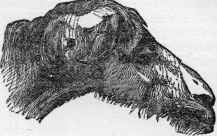
Poll Evil in its Second Stage, or when ready for
Operation.
on the wound till the seat of the disease is gained.
Use a proper knife, and include as many pipes as
possible in one clean cut. All others should join
this. Empty out all concrete matter. Wash the
cavity with cold water. Excise all loose pieces
of tendon and all unhealthy flesh. Moisten the
sore with chloride-of-zinc lotion, one grain to
the ounce, and cover the wound with a cloth
dipped in the solution of tar. If the disease has
burst, still include the pipes in one smooth in
cision ; clean out the concrete pus, and treat as
has been directed. Spare the ligament which
lies under the mane ; and work in a breast-strap
after recovery.
Prick of the Sole.—Cause,—Generally the smith‘s
carelessness when shoeing
the horse.
Symptom. — Great lame
ness.
Treatment.— Withdraw
the nails of the shoe. If one
is wet, cut down on that
hole until the sensitive sole
is exposed. If not very
lame, treat with lotion of
chloride of zinc, 1 grain to
the ounce of water. If very
lame, treat as if the injury
were a suppurating corn.
Prurigo.—Cause.—Heat of
body.
Symptom. — Itchiness. The horse rubs off
hair; but never exposes a dry, corrugated sur
face.
Treatment.—Take away part of the hay. Give
two bundles of grass per day. Allow two bran
mashes each day till the bowels are open. Ap
ply either of the following washes : Animal gly
cerine, 1 part; rose-water, 2 parts. Or, sulphu
ric acid, 1 part; water, 10 parts. Or, acetic acid,
1 part; water, 7 parts. Drink: Liquor arsenica-
lis, 1 ounce; tincture of muriate of iron, 1½
ounces ; water, 1 pint—½ pint to be given every
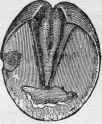
Prick of the Foot and
Bruise of the Sole.
The smaller opening re
presents prick of the
foot: the larger space
indicates bruise of the
sole. The extent to
which the horn may be
removed, in the gene
rality of cases is also
indicated.
184 THE FRIEND OF ALL.
night. Withdraw the drink a week after the
disease has disappeared. Allow a pot of porter
and an extra feed of oats each day.
Pumice-Foot.—Cause.—An animal reared on
marshy land, having high action, batters the feet
upon pavements.
Symptoms.—Bulging sole; weak crust; strong
bars, and good frog.


The Side View of a Pumiced
Foot.
Showing the swollen or
rounded state of the sole,
with the brittle and uneven
condition of the crust.
The Sole of a Pumiced
Foot.
Displaying a ragged wall,
and exhibiting a very
healthy frog and a bulg
ing sole.
Treatment.—The only relief possible is afford
ed by a bar-shoe of the dish kind,
and a leathern sole. The con
stant use of equal parts of ani
mal glycerine and tar is also be
neficial to the hoof.
Purpura Hemorrhagica.—Cause.—
Unknown. Universal conges
tion.
Symptoms.—The attack is sud
den. The body, head and limbs enlarge; con
sciousness is partially lost. The horse stands,
and the breathing is quickened. Through the
skin there exudes serum with blood. The nos
trils and lips enlarge, and part of the swollen
tongue protrudes from the mouth. The appe
tite is not quite lost, although swallowing is
difficult. Thirst is great.
Treatment.—Bleed till the animal appears re
lieved. A second venesection may be demand
ed, but it should be adopted with caution. Give
½ ounce of chloroform in a pint of linseed oil,
in the first stage. Repeat the dose in half an
hour. No amendment following, give 2 ounces
of sulphuric ether in 1 pint of cold water. In
half an hour repeat the dose
if necessary. Perform trache
otomy to ease the breathing.
Incise the protruding tongue.
Squeeze out the fluid and re
turn the organ to the mouth.
Should the skin slough, bathe
the part with solution of chlor
ide of zinc, 1 grain to the ounce
of water.
Quittor.— Causes.— Confined
pus from suppurating corn; or
prick of the sole; matter re
sults, and this issues at the coronet. Or from
injury to the coronet, generating pus, and this

A Dish-Shoe.
Employed in Cases
of Severe Pum-
ice-foot.

Diagram.
Which supposes the
outward covering of
the coronet and the
horny wall of the
hoof removed, to
expose the ravages
of quittor, when
commencing in the
coronet of a heavy
horse.
burrowing downward, as it cannot pierce the
coronary substance. The secretion may also
penetrate the cartilage, and thus establish sinuses
in almost every direction.
Symptoms.—The horse is very lame. The ani
mal is easier after the quittor has burst. Probe
for the sinuses. If, after the superficial sinuses
are treated, among the creamy pus there should
appear a dark speck of albuminous fluid, make
sure of another sinus, probably working toward
the central structures of the foot.

A QUITTOR, AS IT DENOTES
its Existence before
the pus absorbs its way
through the coronet.

A QUITTOR, AFTER THE PUS
HAS FOUND AN EXIT AT
THE CORONET.
Rheumatism.—Cause.—Generally follows other
disorders, as influenza, chest affections, and most
acute diseases. Very rarely does it appear with
out a forerunner.
Symptoms,—Swelling of particular parts, gene
rally the limbs; heat and acute lameness. The
disorder is apt to fly about the body. The sy
novia is always increased when the joints are at
tacked. The pulse and breathing are both dis
turbed by agony.
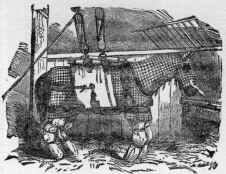
A HORSE DRESSED FOR RHEUMATISM.
Treatment.—Lead into a loose box; fill the
place with steam. Get ready the slings; put
the belly-piece under the horse, but do not pull
it up so as to lift the legs from the ground.
Keep the steam up for one hour. Then have
several men with cloths ready to silently wipe
the animal dry. Next rub into the diseased
parts the following: Compound soap liniment,
16 ounces; tincture of cantharides, liquor am
monia, and laudanum, of each 2 ounces. After
ward incase the limbs in flannel. Then give a
bolus composed of powdered colchicum, 2
drachms; iodide of potassium, 1 drachm; sim
ple mass, a sufficiency. Should the attack sue
HORSES AND THEIR MANAGEMENT. 185
ceed upon other diseases, the diet must be sup
porting, everything being softened by heat and
water. Next morning repeat the steaming, and
give calomel, 1 scruple; opium, 2 drachms. At
night steam again, and repeat the first bolus.
Should the horse be fat, withdraw all corn, if the
strength can do without it.
Ring-Bone.—Cause.—Dragging heavy loads up
steep hills
Symptoms.—A roughness of hair on the pas
tern and a bulging forth of the hoof. A want

The Pastern and Pedal-
Bone of a Horse affected
with Severe Ring-Bone.
i. The joint between the
pastern-bones, showing the
groove in which the tendon
of the extensorpedis muscle
reposed.
2. The joint between the
lower pastern and the bone
of the foot.

The Foot of a Living Horse
with aggravated rIng-
BONE.
The animal, from which the
above sketch was taken, al
though used to propel a cart
was by no means of a cart,
breed. The creature rather
hobbled than went lame ; but
all flexion was entirely lost in
the pastern-bones.
of power to flex the pastern. An inability to
bring the sole to the ground except on an even
surface. Loss of power and injury to utility.
Treatment.— In the first stage apply poultices,
with 1 drachm of camphor and of opium.
Afterward rub with iodide of lead, 1 ounce;
simple ointment, 8 ounces. Continue treatment
for a fortnight after all active symptoms have
subsided, and allow liberal food and rest; work
gently when labor is resumed.
Ring-Worm. — Symptoms. — Hair falls off in
patches, exposing a scurfy skin. The scurf con
gregates on the bare place about the circum
ference, which is apt to ulcerate.
Treatment.—Keep very clean. Wash night
and morning, and afterward apply the following
ointment: Animal glycerine, 1 ounce; sperma
ceti, 1 ounce; iodide of lead, 2 drachms. A
drink is likewise of use when employed with the
ointment. Liquor arsenicalis, 1 ounce; tincture
of muriate of iron, 1½ ounces; water, 1 quart.
Mix, and give every night half a pint for a dose.
Should the ulceration prove obstinate, apply
permanganate of potash, ½ ounce; water, 3
ounces. Or, chloride of zinc, 2 scruples; water,
1 pint. Moisten the parts with a soft brush six
times daily. Feed well, and do not work for a
month.
Roaring.—Cause.—The check-rein.
Symptom.—A noise made at each inspiration.
Treatment.—No remedy.
Rupture, or Stricture of the (Esophagus.—Cause.—
The use of the butt-end of a carter's whip,
which either rends the lining membrane of, or
ruptures, the gullet.
Symptom of Rupture.—The body becomes dis
tended with gas, and death ensues. Of Rent
Membrane.—This induces a disinclination to
feed, as the first symptom. A stricture is
formed. Excessive hunger. Distension of the
tube. A large sac is developed out of the
stretched membrane above the stricture. Then,
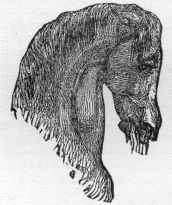
The Horse endeavoring to cast up the Provender with
which the Sac of a Strictured Œsophagus is loaded.
after feeding, the animal fixes the neck, and
returns the masticated food through the mouth
and nostrils. Accompanying loss of condition
and failure of strength.
Treatment.—Feed on prepared soft food:
though the horse is generally not worth its
ordinary keep at the stage when this is required.
Sandcrack.—Causes.—Bad health, provoking
imperfect secretion. Treading for any length of
time upon a very dry soil.
Symptoms.—Quarter-crack occurs on light
horses upon the inner side of the hoof. It usu
ally commences at the coronet, goes down the
foot, and reaches to the laminae. Toe crack

A Partial Quarter Sànd-
CRACK DRESSED AND SHOD.

The Methods of eradicat
ing a Sandcrack: either
the Semicircular or the
Angular Lines are equal
ly efective.
happens in heavy wheelers, and is caused by
digging the toe into the ground when dragging
a load up hill. From the sensitive laminæ,
when exposed, fungoid granulations sometimes
sprout, which, being pinched, produce excessive
pain and acute lameness.
186
THE FRIEND OF ALL.
Treatment.—Always pare out the crack, so as
to convert it into a groove. When the crack is
partial, draw a line with a heated iron above and
below the fissure. If granulations have sprout
ed, cleanse the wound with chloride-of-zinc
lotion, one grain to the ounce of water, and then
cut them off. Afterward place the foot in a
poultice. Subsequently pare down the edges of
the crack while the horn is soft. Use the lotion
frequently. Draw lines from the coronet to the
crack, so as to cut off communication between
the fissure and the newly-secreted horn. Shoe
with a bar-shoe, having the seat of crack well
eased off, and also a clip on either side. If the
horse must work, lay a piece of tow saturated
with the lotion into the crack: bind the hoof
tightly with wax-end. Tie over all a strip of
cloth, and give this a coating of tar. When the
horse returns, inspect the part. Wash out any
grit with the chloride-of-zinc lotion.
Scald Mouth. —Cause. — Powerful medicine,
which burns the lining membrane of the mouth.
Symptom.—A dribbling of saliva, with con
stant motion and repeated smacking of the lips.
Treatment.—Give soft food, and use the wash
recommended for aphtha.
Seedy Toe.—Cause.—Weakness, inducing an
imperfect secretion of horn.
Symptom.—A separation between the crust of
the coronet and the soft horn of the laminæ,
commencing at the toe of the foot.
Treatment.—Remove the shoe. Probe the fis
sure, which will be exposed. Cut away all the
separated crust. Throw up until the removed
portion has grown again.
Simple Ophthalmia.—Causes.—Slashing with the
whip over the head; hayseeds falling into the
eyes; horses biting at each other; blows, etc.
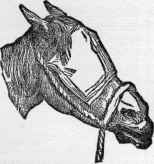
A Ready Mode of Blinding a Horse, and of applying a Lo
tion to the Eyes in Simple Ophthalmia.
Symptoms.—Tears; closed eyelid; the ball of
the eye becomes entirely or partially white.
Treatment.—Remove any foreign body; fasten
a cloth across the forehead; moisten it with a
decoction of poppy-heads to which some tincture
of arnica has been added. If a small abscess
should appear on the surface of the eye, open it,
and bathe with chloride-of-zinc lotion. Should
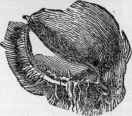
An Eye recently affected with Simple Ophthalmia.
inflammation be excessive, puncture eye-vein, and
place some favorite food on the ground.
Sitfast—Causes.—Ill health; badly-fitting sad
dle ; too energetic a rider; loose girths ; ruck in
the saddle-cloth.
Symptom.—Like a corn on the human foot, but
the hard, bare patch is surrounded by a circle of
ulceration.
Treatment.—-The knife should remove the
thickened skin. Chloride of zinc, 1 grain ; water,
1 ounce, to the wound. Attend to the bowels.
Feed liberally ; exercise well ; and give, night and
morning, liquor arsenicalis, ½ ounce; tincture of
muriate of iron, ½ ounce ; water, 1 pint. Mix, and
give.
Sore Throat—Causes.—In colts, change from
freedom to work, from the field to the stable, is
the cause. Sore throat, however, may be caused
by close stables, or be an indication of some
greater disease.
Symptoms.—Perpetual deglutition of saliva;
want of appetite; inability to swallow a draught
of liquid—the fluid returning partly by the nos
trils, and each gulp being accompanied with an
audible effort.
Treatment.—Forbear all work; clothe warmly;
house in a large, well-littered, loose box. Gruel
for drink; three feeds of bruised and scalded
oats, also beans, daily. If the bowels are obsti
nate, administer a drink composed of solution 01
aloes, 4 ounces; essence of anise-seed, ½ ounce,
water, 1 pint. Should the throat not amend, dis
solve ½ ounce of extract of belladonna in a gallon
of water; hold up the head: pour half a pint of this
preparation into the mouth, and in thirty seconds
let the head down ; do this six or eight times
daily. No improvement being observed, try per
manganate of potash, ½ pint; water, 1 gallon : to
be used as directed in the previous recipe. Still
no change being remarked, prepare chloride of
zinc, 3 drachms; extract of belladonna, ½ ounce
tincture of capsicums, 2 drachms; water, I gallon.
All being useless, give two pots of stout daily,
and blister the throat.
No alteration ensuing, cast the horse, and mop
out the fauces with a sponge which is wet with
HORSES AND THEIR MANAGEMENT. 187
nitrate ot silver, 5 grains ; water, 1 ounce. Give
a ball daily composed of oak-bark and treacle.
If none of these measures succeed, the throat
must be complicated with some other disease.
Spasm of the Diaphragm.—Cause.—Imprudently
riding too far and too fast.
Symptom.—Distress, and a strange noise heard
from the center of the horse.
Treatment.—Pull up; cover the horse's body;
lead to the nearest stable. Give as soon as pos
sible a drink composed of sulphuric ether, 2
ounces; laudanum, 1 ounce; tincture of camphor,
½ ounce; cold water or gruel, 1 pint. Give four
drinks, one every quarter of an hour; then an
other four, one every half-hour, and then at longer
intervals as the animal recovers. Bandage the
legs, and sponge the openings to the body. This
done, and sweat and dirt removed, clothe per
fectly after the skin is quite dry.
Spasm of the Urethra.—Cause.—Acridity in the
food or water.
Symptoms. — Small and violent emissions;
straddling gait. Roached back; pain; total sup
pression of urine.
Treatment.—Insert the arm up the rectum, and
feel the gorged bladder. Give, by the mouth, 4-
ounce doses of sulphuric ether and of laudanum
mixed with a quart of cold water, and, as injec
tion, mixed with three pints of cold water. Re
peat these medicines every quarter of an hour
until relieved. If no physic be at hand, open
both jugular veins, and allow the blood to flow
until the horse falls. Should the urine then not
flow forth, insert the arm and press upon the
bladder.
Spasmodic Colic; Fret; Gripes. — Causes.—Fast
driving; change of water, change of food ; get
ting wet; fatiguing journeys ; aloes; and often
no cause can be traced.

Spasmodic Colic.
Symptoms. 1st Stage.—Horse is feeding; be
comes uneasy; ceases eating; hind foot is raised
to strike the belly; fore foot paws the pavement;
the nose is turned toward the flank, and an attack
of fret is recognized. 2d Stage.—Alternate ease
and fits of pain; the exemptions grow shorter as
the attacks become longer ; the horse crouches;
turns round; then becomes erect; pawing, etc.,
follow; a morbid fire now lights up the eyes. 3d
Stage.—Pains lengthen; action grows more wild;
often one foot stamps on the ground ; does not
feed, but stares at the abdomen ; at last, without
warning, leaps up and falls violently on the floor;
seems relieved; rolls about till one leg rests
against the wall; should no assistance be now
afforded, the worst consequences may be antici
pated.
Treatment.—Place in a loose box, guarded by
trusses of straw ranged against the walls. Give
1 ounce each of sulphuric ether and of laudanum
in a pint of cold water, and repeat the dose every
ten minutes if the symptoms do not abate. If no
improvement be observed, double the active
agents, and at the periods stated persevere with
the medicine. A pint of turpentine, dissolved in
a quart of solution of soap, as an enema, has
done good. No amendment ensuing, dilute some
strong liquor ammonia with six times its bulk of
water, and saturating a cloth with the fluid, hold
it by means of a horse-rug close to the abdomen.
It is a blister; but its action must be watched or
it may dissolve the skin. If, after all, the symp
toms continue, there must be more than simple
colic to contend with.
Spavin.—Cause.—Hard work.
Symptom.—Any bony enlarge
ment upon the lower and inner
side of the hock. Prevents the
leg being flexed. Hinders the
hoof from being turned outward.
Causes the front of the shoe to be
worn and the toe of the hoof to be
rendered blunt by dragging the
foot along the ground. Leaves the
stable limping; returns bettered by
exercise.
Treatment.—View the suspected joint from be
fore, from behind and from either side. After-

Bone-Spavin.
A swelling or
bony tumor,
situated upon
the lower and
inner part of
the hock-
joint.
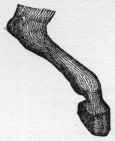
The Natural Position of
the Healthy Foot when
raised from the earth
during an Easy Trot.

The Foot, incapable of be
ing FREELY RAISED FROM
the Ground, by a Horse
which is badly spavined.
ward feel the hock. Any enlargement upon the
seat of disease, to be felt or seen, is a spavin.
188 THE FRIEND OF ALL.
Feed liberally, and rest in a stall. When the part
is hot and tender, rub it with bella
donna and opium, 1 ounce of each
to an ounce of water. Apply a poul
tice. Or put opium and camphor
on the poultice. Or rub the spavin
with equal parts of chloroform and
camphorated oil. The heat and
pain being relieved, apply the fol
lowing, with friction: Iodide of
lead, 1 ounce; simple ointment, 8
ounces.
Specific Ophthalmia.—Cause.—The fumes of im
pure stables.
Symptoms.—A swollen eyelid ; tears ; a hard
puise; sharp breathing; a staring coat; a clammy
mouth ; the nasal membrane
is inflamed or leaden-colored ;
the lid can only be raised
when in shadow. The ball
of eye reddened from the
circumference; the pupil
closed; the iris lighter than
is natural. The disease may
change from eye to eye ; the
duration of any visitation is
very uncertain; the attacks
may be repeated, and end in the loss of one or
both eyes. If one eye only is lost, the remain
ing eye generally strengthens.
Treatment.—Remove from the stable and place
in a dark shed. Open the eye-vein, and puncture
the lid if needed; put a cloth saturated with cold

The Inner Side
of the Hock
afflicted
with High or
in c ura ble
Spavin.

Diagram of the Horse's
Eye when Suffering
from Specific Oph
thalmia.
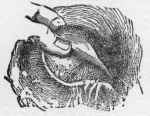
Raising the Upper Lid of an Eye affected with Specific
Ophthalmia.
water over both eyes. If the horse is poor, feed
well; if fat, support, but do not cram ; if in con
dition, lower the food. Sustain upon a diet which
requires no mastication. Give the following ball
twice daily: Powdered colchicum, 2 drachms;
iodide of iron, 1 drachm ; calomel, 1 scruple. Make
up with extract of gentian. So soon as the ball
affects the system, change it for liquor arsenicalis,
3 ounces; muriated tincture of iron, 5 ounces.
Give ½ ounce in a tumbler of water twice daily.
See that the stable is rendered pure before the
horse returns to it.
Splint.—Causes.—Early and hard work ; blows,
kicks, etc.
Symptom.—Any swelling upon the inner and
lower part of the knee of the fore
leg, or any enlargement upon the
shin-bone of either limb. On the
knee they are important, as they
extend high up. On the shin they
are to be dreaded, as they interfere
with the movements of the ten
dons. All are painful when grow
ing, and in that state generally
cause lameness.
Treatment.—Feel down the leg.
Any heat, tenderness or enlarge
ment is proof of a splint. If, on
the trot, one leg is not fully flexed,
or the horse “dishes” with it, it
confirms the opinion. Time and
liberal food are the best means of
perfecting them. When they are
painful, poultice, having sprinkled
on the surface of the application
1 drachm each of opium and of camphor. Or
rub the place with 1 drachm of chloroform and
2 drachms of camphorated oil. When a splint
interferes with a tendon, the only chance of cure
is to open the skin and to cut off the splint,
afterward treating the wound with a lotion com
posed of chloride of zinc, 1 grain; water, 1
ounce. To check the growth of a splint, rub it
well and frequently with iodide of lead. 1 ounce;
simple ointment, 8 ounces.
Sprain of the Back Sinews.—Cause.—Cart-work
upon a hilly country.
Symptom.—Gradual heightening of the hind
heel.
Treatment.—The only possible relief is afforded
by an operation—“ division of the tendons.”
Staggers.—Sleepy staggers and mad staggers
are only different stages of the same disorder.
Cause.—Over-gorging.
Symptoms.—Excessive thirst; dullness or sleep
iness; snoring; pressing the head against a wall.

Splints of a
Serious Kind.
1. A splint in
volvingthe bones
of the knee-joint.
2. A splint in
terfering with the
action of the back
sinews.
3. A small splint
situated under the
tendon of an ex
tensor muscle.
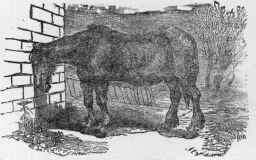
Sleepy Staggers, from Over-Gorging.
Some animals perish in this state ; others com
mence trotting without taking the head from the
wall, and such generally die, but sometimes re-
HORSES AND THEIR MANAGEMENT. 189
cover. Other horses quit the sleepy state; the
eyes brighten ; the breath becomes quick. Such
animals exhibit the greatest possible violence, but
without the slightest desire for mischief.
Treatment.—Allow no water. Give a quart of
oil. Six hours afterward give another quart of
oil, with 2o drops of croton oil in it, should no
improvement be noticed. In another six hours,
no amendment being exhibited, give another
quart of oil, with 30 drops of croton oil. After
a further six hours, repeat the first dose, and ad
minister the succeeding doses, at the intervals
already stated, until the appearance changing
indicates that the body has been relieved.
For the full development of the mad stage no
remedies are of the slightest avail.
Strain of the Flexor Tendons.—Cause.—Hard work
on uneven ground, or the rider punishing a horse
with the snaffle and the spurs.
Symptoms.—The animal goes oddly, not lame.
The defective action will disappear upon rest, but
stiffness is aggravated by subsequent labor. Any
attempt to work the horse sound induces incura
ble lameness or contraction of the tendons.
Treatment.—Allow several hours to elapse be
fore any attempt is made to discover the disease.
A small swelling, hot, soft and sensitive, may
then appear. Bind round it a linen bandage, and
keep it wet with cold water. Bathe this for the
first three nights; afterward apply moisture only
by day. Stop working the horse. Give 4 drachms
of aloes. Do not turn out, but allow two feeds of
corn each day. Keep in a stall, and do not put
to work till more than recovered.
Strangles.—Cause.—Something requiring to be
cast from the system, so as to suit the young
body to a sudden change.
Symptoms. — A slight general disturbance,
which, however, remains. The colt continues
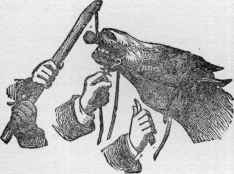
Opening the Abscess of Strangles.
sickly. After a day or two, the neck becomes
stiff, and a swelling appears between the jaws.
The enlargement at first is hard, hot and tender.
A discharge from the nose comes on. The symp
toms increase; the throat becomes sore. Breath
ing is oppressed; coat stares; appetite is lost
tumor softens, and, being opened, the animal
speedily recovers.
Treatment.—Neither purge nor bleed. Give all
the nourishment that can be swallowed. Corn,
ground and scalded, may be offered, a little at a
time, from the hand. No grooming; light cloth
ing; ample bed ; door and window of loose box
should be open. Gently stimulate the throat
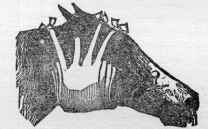
A Horse with Strangles wearing an Eight-Tailed
Bandage.
with the following ? Spirits of turpentine, 2 parts;
laudanum, 1 part; spirits of camphor, 1 part.
Apply with a paste-brush morning, noon and
night, until the throat is sore. After every appli
cation, take three pieces of flannel, place these
over the part, and bind on with an eight-tailed
bandage. So soon as the tumor points, apply the
twitch, and have one foreleg held up. Then open
the swelling with an abscess-knife. It may be
necessary to make another incision.
Stringhalt.—Cause.—Over-exertion.
Symptom.—Raising both hind legs, one after
the other, previous to starting.
Treatment.—None is possible.
Surfeit. -Cause.—Heat of body.
Symptom.—An eruption of round, blunt and
numerous spots.
Treatment.—If the pulse is not affected, the
symptom may disappear in a few hours. Look

A Horse affected with Surfeit.
to the food. Abstract eight pounds of hay, and
allow two bundles of cut grass per day. Even
increase the oats, but with each feed give a hand
ful of old crushed beans. The following drink
will be of service: Liquor arsenicahs, 1 ounce;
190 THE FRIEND OF ALL.
tincture of muriate of iron, 1½ ounces; water, 1
quart. Mix. Give daily, 1 pint for a dose.
Symptom.—If a young horse has been neglected
through the winter, the surfeit lumps do not dis
appear. An exudation escapes; the constitution
is involved, and the disease is apt to settle upon
the lungs.
Treatment.—Do not take out. Keep the stable
aired, and attend to cleanliness. Feed as pre
viously directed, and allow bran mashes when the
bowels are constipated. Administer the drink
recommended above, night and morning. Clothe
warmly; remove from a stall to a loose box.
Should the pulse suddenly sink, allow two pots
of stout each day. If the appetite fail, give gruel
instead of water, and present a few cut carrots
from the hand. The shortest of these cases oc
cupy a fortnight.
Swollen Legs.—Cause.—Debility.
Treatment.—Place in a loose box. No hay
for some weeks. Dampen the corn, and sprinkle
a handful of ground oak-bark on each feed. At
tend to exercise. If the legs continue to enlarge,
hand-rub them well and long.
Teeth.—Cause.—A thickening of the membrane
sometimes conceals the upper tushes and pro
vokes constitutional symptoms.
Treatment.—Lance the membrane.
Symptoms of Toothache,—Head carried on one
side, or pressed against the wall; saliva dribbles
from the lips ; quidding or partial mastication of
the food, and allowing the morsel to fall from the
mouth. Appetite capricious; sometimes spirit
is displayed—then the horse is equally dejected.
The tooth dies ; the opposing tooth grows long.
The opposite teeth become very sharp, from the
horse masticating only on one side. The long
tooth presses upon the gum and provokes nasal
gleet.
Treatment.—Chisel off projecting tooth ; file
down the sharp edges of the opposite teeth, and
look to the mouth frequently.
Tetanus.—Causes.—Cold rain; draughts of air;
too much light; wounds.
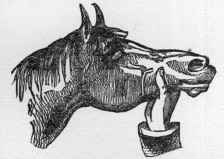
The Test for Tetanus, when not fully developed.
Symptoms.—The wound often dries up. The
horse grows fidgety. Upon lifting up the head,
“the haw” projects over the eye. The tail is
raised ; the ears are pricked ; the head is elevated;
the limbs are stiff; the body feels hard. Any ex
citement may call up a fearful spasm.
Treatment.—Give a double dose of purgative
medicine. Place in solitude and in quiet. Put
a pailful of gruel and a thin mash within easy
reach of the head.
Thorough-Pin.—Cause.—Excessive labor.
Symptom.—A round tumor going right through
the leg, and appearing anterior
to the point of the hock. It is
nearly always connected with bog-
spavin.
Treatment.—Never attack thor-
ough-pin and bog-spavin at the
same time. Relieve the thorough-
pin first by means of rags, cork
and an India-rubber bandage, cut
so as not to press on the bog-
spavin. If the corks occasion con
stitutional symptoms, use a truss
to press upon the thorough-pin,
which being destroyed, apply a perfect bandage
and wetted cloths to the bog-spavin. When
attempting to cure bog-spavin, however, continue
the remedy to the thorough-pin, or the cure of
one affection may reproduce the other.
Thrush.—Cause.—Standing in filth, when It ap
pears in the hind feet; navicular disease, when
seen in contracted feet.
Symptoms.—A foul discharge running from the
cleft of the frog. This decomposes the horn.

Dissection of
Thorough-Pin
andBog-Spavin.
demonstrating
the Junction
of the Two Af-
fections.

Thrush in the Fore Foot, with
a Thick Crust, a Concave
Sole, and a Small Frog.

Thrush in the Hind Foot.
The surface of the frog becomes ragged, and the
interior converted into a white powder. The
affection does not generally lame; but should the
horse tread on a rolling stone, it may fall as
though it were shot.
Treatment.—Pare away the frog till only sound
horn remains, or until the flesh is exposed. Then
tack on the shoe and return to a clean stall.
Apply the chloride-of-zinc lotion—three grains to
the ounce of water—to the cleft of the frog by
means of some tow, wrapped round a small bit of
stick. When the stench has ceased, a little
liquor of lead will perfect the cure. For con
tracted feet pare the frog, and every morning
dress once with the chloride-of-zinc lotion; but
do not strive to stop the thrush.
Tread.—Cause,—Fatigue and overweight.
HORSES AND THEIR MANAGEMENT. 191
Symptom.—In light horses it occurs towards
the end of a long journey. The hind foot is not
removed when the fore foot is put to the ground.
The end of the fore shoe consequently tears off a
portion of the coronet from the hind foot. In
cart-horses, after the horse is fatigued the load
has to be taken down a steep hill; the animal,
being in the shafts, rocks to and fro ; the legs
cross, and the calk of one shoe wounds the coronet
of the opposite hoof.
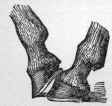
Tread in Light Horses.
The hind foot, from fa
tigue not being removed
soon enough, is wounded
by the heel of the fore
shoe being placed upon
its coronet.
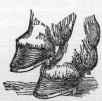
TREAD UPON THE HlND
Foot of Cart-horses.
The animal become un
steady from exhaustion;
the feet cross, and a
wound results.
Treatment.—Bathe the sore with the chloride-
of-zinc lotion, one grain to the ounce of water.
Continue to do this thrice daily ; feed liberally.
A slough will take place, and the animal be well
in about a month; the only danger being the
after-result of a false quarter.
Tumors.—These are so various and of such
different natures, that in every case a surgeon
should be consulted.
Warts.—Cause.—Unknown.
Symptom.—There are three kinds of warts.
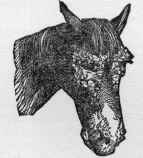
Head of a Horse with Warts.
1st. Some are contained in a cuticular sac, and,
upon this being divided, shell out. 2d. The
second are cartilaginous and vascular. These
grow to some size, and are rough on the surface.
They are apt to ulcerate. 3d. Consists of a
cuticular case, inclosing a soft granular sub
stance.
Treatment.—When of the first kind, slit up,
and squeeze them out; the second kind, excise
and apply a heated iron to stop the bleeding.
The third kind are better let alone.
Water-Farcy.—Cause.—Overwork and coarse
feed, succeeded by periods of stagnation. It is
the warning that true farcy threatens the stable.
Symptoms.— Load less and work less.
Treatment.—Improve the diet, and never allow
the horse to remain a day in the stable without
exercise. Saturate the swollen limb with cold
water every morning, and have it afterward
thoroughly hand-rubbed until it is perfectly dry.
Should lameness remain after the first day, a few
punctures may be made into the limb, but only
through the skin. Give the following ball every
morning: Iodide of iron, 1 drachm; powdered
cantharides, 2 grains; powdered arsenic, 1 grain ;
Cayenne pepper, 1 scruple; sulphate of iron, 1
drachm; treacle and linseed meal, a sufficiency.
Mix. The delay even of a day in treatment is
attended with danger in this disease.
Wind-Galls.—Cause.—Hard work.
Symptoms.—Small enlargements, generally up
on the hind legs and below the
hocks; no lameness; two wind-
galls appear above the pastern,
one beneath that joint; after
extraordinary labor, the round
swellings disappear and the
course of the flexor tendons be
comes puffy. Sometimes con
tinued irritation will cause the
wind-galls to greatly enlarge, and
ultimately provokes their case to
change into bone. During these changes the
horse is very lame.
Treatment.—Fold pieces of rags; wet them ;
put these on the wind-galls ; place on the rags
pieces of cork, and over the cork lace on an
India-rubber bandage. Mind this bandage is
constantly worn, save when ridden or driven by
the owner. Rest is the only alleviation for the
change of structure.
Windy Colic.—Causes.—Gorging on green food ;
but more commonly impaired digestion, con
sequent upon severe labor and old age.
Symptoms.—Uneasiness ; pendulous head ; ces
sation of feeding. Breathing laborious ; fidgets;
rocking the body; enlargement of the belly;
pawing. Standing in one place; sleepy eye;
heavy pulse ; flatulence, the abdomen greatly
enlarged. Breathing very fast; pulse very feeble ;
blindness ; the animal walks round and round till
it falls and dies.
Treatment.—Three balls of sulphuret of am
monia, 2 drachms, with extract of gentian and
powdered quassia, of each a sufficiency, may be
given, one every half-hour. Next, 1 ounce of
chloride of potash, dissolved in a pint of cold
water, and mingled with sulphuric ether, 2 ounces,
should be horned down. In an hour‘s time, 2
ounces each of sulphuric ether and of laudanum,
½ ounce of camphorated spirits, 1 drachm of

The Situations
and Shapes of
Wind-Galls.
192 THE FRIEND OF ALL.
carbonate of ammonia, may be administered. No
good effect being produced, throw up a tobacco-
smoke enema. As a last resort, procure a stick
of brimstone and light it. Remain in the stable
while it burns, to see that the sulphureous fumes
do not become too powerful for life to inhale
them. Continue this measure for two hours;
then repeat the remedies previously recom
mended.
Worms are of four kinds: the Tænia, the
Lumbrici, the Strongulus and the Ascarides.
The Tœnia mostly affect the young.
Cause.—Starving the mare when with foal, and
breeding from old animals.
Symptoms.—Checked development; large head;
low crest; long legs, and swollen abdomen. Ap
petite ravenous; body thin; coat unhealthy;
breath fetid. The colt rubs its nose against a
wall, or strains it violently upward; picks and
bites its own hair.
Treatment.—Give spirits of turpentine. To a
foal, 2 drachms; to a three-months-old, ½ ounce;
six months, 1 ounce; one year, 1½ ounces ; two
years, 2 ounces; three years, 3 ounces ; four years
and upwards, 4 ounces. Procure 1 pound of
quassia chips ; pour on them 3 quarts of boiling
water. Blend with the turpentine a proportionate
quantity of the quassia infusion, by means of yelks
of eggs ; add 1 scruple of powdered camphor, and
give first thing in the morning. Good food is
essential afterward. Subsequently give every
morning, till the coat is glossy, liquor arsenicalis,
from 1 to 8 drachms; muriated tincture of iron,
from 1½ to 12 drachms; extract of belladonna,
from 10 grains to 2 drachms; ale or stout, from
½ pint to a quart.
The Lumbrici prey upon the old and the
weakly.
Treatment.—Tartarized antimony, 2 drachms;
common mass, a sufficiency to make one ball.
Give one every morning.
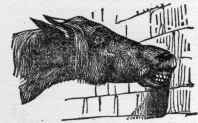
Irritation Caused by Worms. The Nose rubbed violently
against a Wall.
The Strongulus, during life, is generally not
known to be present.
The Ascarides cause great itching posteriorly,
which provokes the horse to rub its hair off
against the wall.
Treatment.—Try injections of train-oil for one
week. Then use infusion of catechu, 1 ounce
to 1 quart of water. On the eighth morning,
give aloes, 4 drachms; calomel, 1 drachm. To-
bacco-smoke enemas are sometimes useful, and the
following ointment may be placed up the rectum
night and morning: Glycerine, ½ ounce; sperma
ceti, 1 ounce ; melt the spermaceti, and blend ;
when cold, add strong mercurial ointment, 3
drachms ; powdered camphor, 3 drachms.
Wounds.—A lacerated wound is generally accom
panied by contusion, but with little hemorrhage.
Shock to the system is the worst of its primary
effects. The danger springs from collapse. A
slough may probably follow. The slough is
dangerous in proportion as it is tardy. The
horse may bleed to death if the body is much
debilitated.
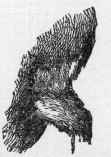
Diagram of a Severe
Lacerated Wound.
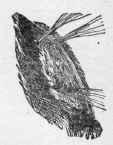
Diagram of an Incised
Wound.
Treatment.—Attend first to the system. Give a
drink composed of sulphuric ether and laudanum,
of each 1 ounce ; water, ½ pint. Repeat the medi
cine every quarter of an hour if necessary, or till
shivering has ceased and the pulse is healthy.
A poultice, made of ¼ brewer‘s yeast, ¾ of any
coarse meal; or a lotion, consisting of tincture
of cantharides, 1 ounce; chloride of zinc, 2
drachms; water, 3 pints, may be employed.
When the slough has fallen, apply frequently a
solution of chloride of zinc, 1 grain to the ounce
of water; and regulate the food by the pulse.
An incised wound produces little shock. The
danger is immediate, as the horse may bleed to
death.
Treatment.—Do not move the horse. Dash
the part with cold water, or direct upon the
bleeding surface a current of wind from the bel
lows. When the bleeding has ceased and the
surfaces are sticky, draw the edges together with
divided sutures. When the sutures begin to
drag, cut them across. After copious suppuration
has been established, bathe frequently with the
solution of chloride of zinc, one grain to the
ounce of water.
An abraded wound generally is accompanied by
grit or dirt forced into the denuded surface. The
HORSES AND THEIR MANAGEMENT. 193
pain is so great, the animal may sink from irri
tation.
Treatment.—Cleanse, by squeez
ing water from a large sponge
above the wound, as was directed
for broken knees, and allow sup
puration to remove any grit that
is fixed in the flesh. Support
the body, and use the chloride-of-
zinc lotion.
A punctured wound is danger
ous, as the parts injured are
liable to motion. On this ac
count those above the stifle are
very hazardous. Sinuses form
from the torn fascia opposing
the exit of the pus; also because
the small hole in the skin gener
ally bears no proportion to the internal damage.
Treatment. —A1ways
enlarge the external
opening to afford egress
to all sloughs and pus.
Regulate the food by the
symptoms, and use the
chloride-of-zinc lotion.
A contused wound, when
large, causes more con
gealed blood than can
be absorbed. This cor
rupts, and a slough must
occur or an abscess must
form. Either generates
weakness, produces irri
tation, and may lead to fatal hemorrhage. Or
sinuses may form. Don‘t judge hastily.
Treatment.—When the con
tusion is slight, rub the part
with iodide of lead, 1 drachm of
the salt to 1 ounce of lard. When
large, divide the skin, every
eighth inch, the entire length of
the swelling. Bathe the injury
with the chloride-of-zinc lotion,
and support the body, as the

Diagram of an
Abraded Wound.
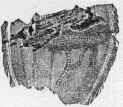
Diagram of a Punctured
Wound.
The engraving supposes the
soft parts to have been divi
ded, in order to show the
ragged nature and large ex
tent of the injury, with the
comparatively small opening
by which this amount of harm
is characterized.

Diagram of a Con
tused Wound.
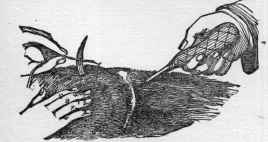
The Manner of using the Fixed Seton Needle.
A second person pushes the wound together, and, when the
point of the needle appears, threads it with a piece of zinc wire
or soft string. The needle is then retracted, and released from
the wire or string, whereby a suture is left in the wound.
I3
symptoms demand liberality in the matter of
food.
In all wounds, gain, if possible, a large depend
ing orifice, and cover the denuded surfaces with
a rag saturated with oil of, or in solution of,
tar.
REMEDIES, AND THEIR ADMINISTRA
TION.
Warm Mashes.—Put a peck of bran into a per
fectly clean pail. Stir the bran as briskly as
possible, and empty enough boiling water into the
pail to render the contents a pultaceous mass.
Cover up the vessel, and when cool throw the
mash into the manger. Bran mashes, four daily,
will relax the animal‘s system ; but the groom
likes to employ these agents merely as prepara-
tory to his favorite dose of aloes ; and, though
repeated mashes will induce purgation in the
equine patient, the groom is not satisfied unless
that result be aggravated by a dose of aloes.
Bran mashes of themselves do not debilitate,
though, from the length and size of the horse's
intestines, purgation cannot be long maintained
without inducing serious exhaustion; and it is
never safe to work the animal while any loose
ness is observable. A tendency to inflammation
is often announced by repeated liquid discharges ;
therefore, never let the horse be taken out while
the bowels are in a state of excitement, for exer
cise may increase that action to one of positive
disease. Bran mashes, however, are the safest
and the gentlest of laxatives. Any condition
may be induced, according to the number and
frequency of the potions. In general, they act
mildly, without inducing that bodily discomfort
and that constitutional weakness which throw
the animal out of condition and render rest an
absolute necessity for recovery.
Horses not all Alike.—However, one horse will
devour bran mashes with avidity; another will
not touch them. This will not partake of the
potion unless it be partially warm ; another will
not eat until it is perfectly cold ; while most will
partake of the mess if it be flavored by the ad
mixture of a little salt or a few crushed oats. So,
also, with water. Certain horses, when feeding
upon bran mashes, refuse all drink ; others enjoy
frequent draughts of cold liquid; a third set
seem to crave warm water ; and a fourth will
neither imbibe freely nor entirely abstain, being
wholly indifferent as to the temperature of the
liquid. Thus the order, which is often printed,
to give to the horse, after the animal has swal
lowed a dose of aloes, copious draughts of warm
water, is frequently rendered futile ; for, as the
proverb teaches, “ one man may lead the horse
to the pond, but forty men cannot make him
drink.”
194
THE FRIEND OF ALL.
Horse-Balls.—A horse-ball represents some sub
stance in powder mixed into a mass with a moist
ingredient, such as soft-soap, treacle, palm-oil,
etc. The compounds, when united, are usually
rolled into sticks about three quarters of an inch
in diameter. These sticks are then cut into
lengths of two and a half to four inches in ex
tent, according to the amount required for a dose.
They are generally sent to stables by the dozen.
Physic is thus placed at the pleasure or the ca
price of ignorance to administer. Aloes is the
common purgative of the stable. So general
was the use of the drug, that this medicine al
ways took the precedence in every sickness, and
engrossed to itself the significant term of “ physic.”
" Has this horse had physic ?" “ Prepare this
horse for physic”—when spoken in the stable,
signify, Has he had aloes? or imply an order that
another quadruped is to be prepared for a dose of
aloes. An ignorant groom can only imagine
that to be worthy of the title “ physic,” which is
capable of producing visible effects; and, cer
tainly, when judged by the stable-man's standard,
aloes merits the distinction bestowed upon its
drastic results.
Aloes.—On the other hand, aloes can, in no
form, be administered to some horses. Many
cannot take a full dose. Others can safely swal
low the medicine only when highly spiced or in
solution. A few are all but insensible to its
action. Alarming spasms often follow the use of
a moderate quantity of aloes, which always ren
ders the quadruped sick ere the effects are visible.
The drug, in most instances, lies dormant twenty-
four hours, during which period the appetite is
lost, the spirits oppressed, the coat dull, and
the entire system evidently shaken. It is not
esteemed prudent to work the patient till several
days’ rest have been allowed. It used once to be
the custom to trot the animal which was sicken
ing under a dose of aloes; but experience has
shown the danger of the practice. The horse is
now left in the stable, has an extra rug thrown
upon his back, and a pail of warm water in the
manger.
Very many animals, when suffering from chronic
debility, may be slaughtered by a moderate dose
of aloes, while many others never sufficiently
recover from its effects to do a day's work after
the medicine has ceased to operate. Of the
preparations the veterinarian has at his com
mand, it is one of the most dangerous. Another
fact renders the aloetic ball an unsafe agent to
be intrusted to the keeping of a groom. These
things, as commonly compounded, become, in a
short time, as hard as stones, and such bodies
are not in a fit condition to be thrust down a
horse‘s throat.
Previous to a ball being delivered it is cus
tomary to pinch the sharp edge of the forward
end until it becomes rounded. The intention is
so to modify the shape as to facilitate the passage
of the body down the gullet. Whether the
present practice in any degree is beneficial to the
animal is doubtful: at all events, the horse would
be more fortunate if the sharp edges of the for
ward extremity were the only danger it encoun
tered from swallowing the physic.
Other Physics.—Several potent caustics rank
among common horse physics, as bichloride of
mercury, arsenic, nitrate of silver, sulphate of
copper, etc. These burning compounds are fre
quently administered in substance and in enor
mous doses. Even where the quantity pre
scribed is not objectionable, the form in which
the caustic is generally given is highly injurious.
The com pounder does not bestow much care
upon the accuracy of the weight—a scruple more
or less being commonly esteemed of no impor
tance. Then, small thought is bestowed upon
the necessity of incorporating such fiery com
ponents with more mild ingredients before the
mass is forced down the sensitive throat of a
living creature. A ball made of linseed meal
and treacle is taken; the powerful agent is
speedily reduced to powder, and emptied into
the cavity formed for its reception; and the whole,
having been rewrapped in fresh paper, is esteemed
ready. When such an article has been swallowed,
the paper or covering is speedily removed by the
action of the stomach. Then the burning mass
falls out upon the fine, moist and velvet coat
lining the viscus; this fact may explain why
stomachic diseases are so general with the ma
jority of old favorites. As such substances are
caustics when applied to the external flesh, it is
only reasonable to infer that no tissue within the
body can long withstand their burning properties.
Balling-Iron.—We give the form of an instru
ment for administering balls, which seems free
from the objections belonging to the old instru
ment, and to possess all the qualities that such an
instrument can show. The restraining bars are
formed of polished steel, and are covered with a
stout piece of India-rubber tubing, thus in some
measure protecting the mouth of the creature
from injury by what hitherto was the exposed
metal. The lower bar, moreover, is attached to
the handle, and the handle can be readily raised
or depressed by turning the nut situated at its
base. It can be quickly adapted to any possible
capacity of jaw.
The Old Way.—Such a form of immunity is,
however, seldom sought. A sufficient security is
in all ordinary cases afforded by the horse's
tongue, which, when a ball is to be administered,
is grasped by the left hand, and withdrawn to the
right side of the mouth. The hand thus em-
HORSES AND THEIR MANAGEMENT.
195
ployed is fixed, being lightly pressed against the
inferior margin of the lower jaw; for, when
retained in such a position, the tongue is pressed
upon the foremost of the huge molar teeth. Of
course, the animal, thus held, cannot approximate
its iaws so as seriously to harm the operator
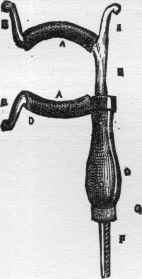
New Balling-Iron.
A A. India-rubber tubing, to protect the mouth from the.
harshness of the metal bars.
B B B. Side pieces to keep the iron in its situation.
C The handle.
D. The lower bar, attached to the handle.
E. The side piece, which can be raised or depressed.
F. The screw, at the extremity of the side piece.
G. The nut which, fastened to the handle, acts upon the
screw and fixes its position.
without biting its own flesh ; by that circum
stance is safety supposed to be rendered certain.
But should violence be exerted, animal fear is
apt to be superior to bodily pain ; the tongue and
arm may be simultaneously bitten through. The
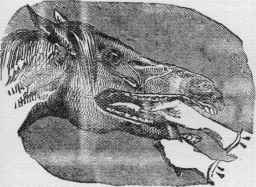
The Usual Manner of giving a Ball.
practiced veterinarian, however, takes advantage
of the first emotion of surprise which the crea
ture experiences at the liberties taken with it.
Having the ball ready in the right hand, he,
standing on the left side, quickly introduces the
bolus into the wondering quadruped‘s mouth.
The medicine is lodged at the back part of the
tongue, whence, as the horse does not expecto
rate, he cannot expel it, except by coughing.
During the spasm which accompanies this act,
the soft palate is raised and the ball is carried
outward with the volume of violently-expired
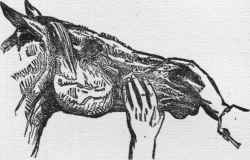
The Customary Mode of distracting the Horse's At-
tention, after it has received a ball.
breath. Some horses acquire a habit of thus
returning all forms of physic, and will cough up
a ball twenty times. This illustrates the neces
sity of distracting the attention of the quadruped
the instant the hand is retracted; for in the
confusion of the moment the most inveterate
“dodger” may be surprised into swallowing any
morsel.
The hand, during the delivery of the ball, being
rapidly thrust into the mouth, is frequently cut
by the sharp edges of the molar teeth. No
knowledge can point out in advance the animal
possessed of grinders of this dangerous descrip
tion, and the only protection as yet suggested is
to cover the hand with a glove. But the use of
a glove is objectionable. The medicine being
delivered, the hand is quickly withdrawn, and
the jaws of the animal are clapped together.
The nose is then rubbed somewhat roughly, with
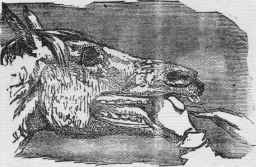
New Way of administering a Ball.
the design of preventing the quadruped from
dwelling too intently on the substance just forced
into its mouth.
A New Way.—An excellent veterinary surgeon
has endeavored to remove the objections tc
which the previous manner of delivering a ball is
196 THE FRIEND OF ALL
liable. He grasps the tongue rather higher up
than usual; and does not retract it, but fixes it
upon the gums which cover the upper margin of
the lower jaw. The point of the tongue pro
trudes between the thumb and fingers, and it is
then plain that the animal cannot close the
mouth without biting upon its own flesh. Even
this does not obviate the danger of the horse
biting the hand through its own tongue.
The same gentleman proposes an unobjection
able method of delivering a ball. The knuckles

Excellent Manner of delivering a Ball.
are not elevated ; but the hand is extended, the
thumb and fingers being all brought upon one
level and held close together. The ball is placed
between the fore and middle fingers, and re
tained simply by slight lateral pressure. In this
position it is introduced, and evidently demands
less space for its entrance than was required
according to the former system. When the
ball has been advanced to the desired situa
tion, a separation of the fingers allows it to drop
into place. Veterinary surgeons, however, soon
learn to give a ball with greater speed and less
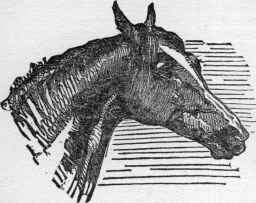
A Ball passing down the Horse's Gullet.
ceremony. They go alone up to the head, and
play for a time with the quadruped‘s face. Con
fidence being thus established, the practitioner
gently withdraws the creature's tongue. Thus
the jaws are sundered ; when, without flurry, the
hand is introduced into the cavity and the medi
cine properly lodged.
The physic being introduced into the mouth,
the person who has undertaken to deliver it
should on no account esteem his business fi
nished. He should watch the neck. In that
position, when the animal swallows, any sub
stance can be seen to travel down the gullet;
this proof having been had, the horse may be
left.
Drinks or Draughts. — Sometimes veterinarians
pour liquids down the nostril of the horse.
The nostrils terminate immediately over the
larynx, and any fluid administered after so un
natural a method will probably find its way on
to the lungs. Veterinary medicines are too ge
nerally composed of pungent and of caustic ma
terials, while the nostrils are lined with a high
ly sensitive and delicately moist mucous mem
brane. The nostril was created to come in con
tact with the air, to which it affords the only
legitimate passage. The notion of disregarding
the mouth and selecting so tender a channel,
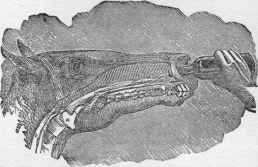
The Consequence to be expected whenever the Cruel
Custom of pouring Drinks into the Nose op a Horse is
adopted.
a a. The windpipe, b b. The .gullet c c. The soft palate
d. The tongue.
down which to pour acrid and burning solutions
is a refinement upon ordinary barbarity.
Process of Drinking. — The natural process
through which the horse drinks, is as follows:
Its mouth is peculiar in that it has at its back
ward extremity a fleshy screen, hanging from
the bony roof. This soft palate explains why
the quadruped, under ordinary circumstances,
breathes only through the nose ; and why, when
it vomits, the matter is ejected through the nos
trils. That specialty is of service, however,
during the act of drinking. The posterior en
trance to the nasal chamber being open and the
head in a pendulous position, were there no
special provision to the contrary, the water,
after having passed the mouth, would, from the
mere force of gravity, have a tendency to return
by the nostrils. This actually occurs whenever
cold, strangles, influenza, sore throat, or their
like, interferes with the use of these parts. Dis
ease renders the organ sensitive, and the animal
exerts its volition to prevent the employment of
the inflamed structure. The nasal chambers are
imperfectly closed, and a great portion of the
fluid imbibed by the mouth flows out again
HORSES AND THEIR MANAGEMENT. 197
through the nostrils. Such a tendency is, dur
ing health, effectually prevented by the soft
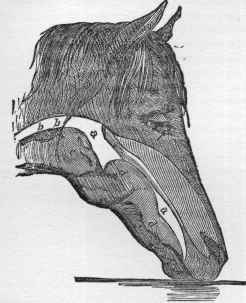
Diagram (Fig. i) explanatory of the Compound Act of
Drinking in the Horse.
a a. The water drawn into the mouth and forced into the
fauces by the compression of the forward part of the tongue
and the enlargement of the backward portion of the organ.
b b. The fluid passing down the oesophagus or gullet, c. The
larynx, lowered to admit the passage of the liquid. dd. The
tongue, dilated at one place and contracted at another, e. The
soft palate, floated upward and effectually closing the nasal
passages.
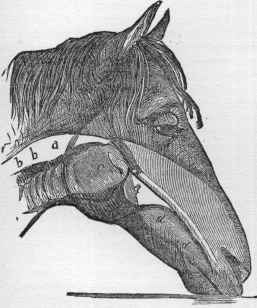
Diagram (Fig. 2) explanatory of the Compound Act of
Drinking.
a a. The water driven backward by the forward dilatation
of the tongue and the upward movement of the larynx, b b.
The full current forced down the gullet, c. The larynx pro
pelled against the soft palate, d d. The tongue, dilated ante
riorly and compressed posteriorly, e. The soft palate.
palate. Before any substance can pass from the
mouth toward the throat, that appendage must
be raised, and its rising closes the posterior en
trance to the nasal chambers.
Tongue and Mouth.—The tongue is the primary
agent employed when the animal slakes its
thirst. The backward portion of the organ is
contracted, and the forward part compressed by
muscular volition. A vacuum would thereby be
created, were not the water propelled by atmos
pheric pressure into the void thus formed. The
posterior of the tongue is then relaxed, while
the anterior division of the organ is pressed
against the roof of the mouth. The fluid is
thereby driven to the backward part of the ca
vity. The tongue, during the act, continues to
alternate the states of contraction and relaxa
tion, each motion serving to pump the water
into the fauces. But, before that can be accom
plished, the soft palate must be elevated. The
soft palate then closes the nostrils, and also in
its course to take this position sets in motion
the cartilages of the larynx. The last covering
and effectually protecting the windpipe, the fluid
is forced onward by the contraction of the
tongue, passes into a secure chamber, the roof
and floor of which are but of temporary forma
tion. Here it remains only during the inactivity
of the larynx. The upward motion of the latter
body propels the fluid into the pharynx, whence
contractility sends it into the gullet, the muscu
lar action of which conveys it onward to the
stomach.
Giving Draughts.—A common method is de
picted above, where a loop of string is hung
A Tin Bottle
to hold Three
Pints.
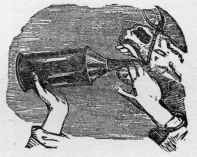
The Manner of using the Tin Bottle.
upon the prong of a pitchfork. Should the
operator fill the mouth too full, or the animal
cough during the time of its administration, he
is saturated with the medicine. Any irritation
of the larynx is invariably productive of this
effect. The misfortunes which the delivery of
drinks almost necessarily involves, will very readi
ly account for dislike to the fluid form of medi
cine. The danger that exists of the horse cough
ing and spasmodically drawing the fluid upon
the lungs, constitutes the strongest argument
urged against the administration of drinks,
198 THE FRIEND OF ALL.
Let the person who intends to deliver a drink
fearlessly approach the animal: allow him to
smell his new acquaintance, and not till then pro
ceed to such trivial familiarities as may establish
trustfulness between the two. As soon as the
steed's confidence is gained, he is all submission.
Then uncork the bottle, and, putting the left hand
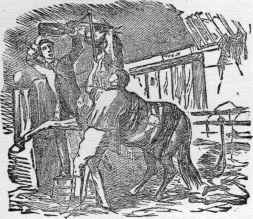
General Method of administering a Drink to a Horse.
gently under the quadruped's jaw, empty with the
other the contents, gradually, through the inter
space which divides the incisors from the molar
teeth. But the operator must be alone. No pain
must be inflicted ; no angry words employed ; no
violent or hasty action used to frighten the horse.
Should the animal be slow to swallow a nauseous
draught, he must not be. scolded for a natural
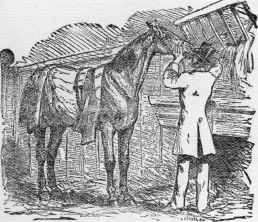
Giving a Drink, according to the Quiet Method.
dislike ; but should be encouraged by kind and
cheerful accents, spoken as softly as though the
words were addressed to a sick child.
Blisters.—The use of blisters is founded upon a
maxim enunciated by the celebrated Dr. John
Hunter, that “two great inflammations cannot
exist in the same body at the same time.” With
this view, stimulating acrimonious substances are I
! applied to the skin, to excite external inflamma
tion, and to lessen or draw away inflammation in
some deeper-seated, and generally not far-distant,
part. Thus we blister the sides, in inflammation
of the lungs ; the belly in that of the bowels; the
legs in that of the cellular substance surrounding
the sheaths of the tendons, or the sheaths them
selves ; and the coronet or the heel in inflamma
tion of the navicular-joint. Mayhew, however,
teaches: “ Let no man blister a horse‘s legs.
There is no motor agent situated in or near to
those parts. The shin, foot and pastern are
almost without muscles. There is nothing,
therefore, which could be freshened or rendered
more brisk. But these parts are susceptible of
I the acutest agony. They are largely supplied
with purely sensitive nerves. Consequently, let
all gentlemen discharge the veterinary surgeon
who proposes to blister the legs of their horses.“
He afso denounces the employment of hot iron
on a horse, and declares that blisters, as usually
employed, are far too powerful.
Blisters have likewise the property of increas
ing the activity of the neighboring vessels: thus
we blister to bring the tumor of strangles more
speedily to a head; we blister to rouse the ab
sorbents to more energetic action, and take away
tumors, and callous and even bony substances.
The judgment of the practitioner will decide
when the desired effect will be best produced by
a sudden and violent action, or by a longer and
milder one. Inflammation should be met by
active blisters; old enlargements and swellings
will be most certainly removed by milder stimu
lants—by the process which farriers call sweating
down.
There is no better blister ointment or active
blister than the Spanish fly, mixed with four
parts of lard and one of resin. The lard and the
resin should be melted together, and the pow
dered flies afterward added. Perhaps the best
liquid or sweating blister is an infusion of the fly
in turpentine, and that lowered with neat's-foot
oil according to the degree of activity required.
In preparing the horse for blistering, the hair
should be clipped or shaved as closely as possible,
and the ointment thoroughly rubbed in. Much
fault is often found with the ointment, if the
blister does not rise, when the real blame should
be attributed to the idleness of the operator.
The head of the horse must be tied up for the first
two days; except that when the sides are blistered,
the body-clothes may be so contrived as to pre
vent the horse from nibbling and blemishing the
part, or blistering his muzzle. At the expiration
of twenty-four hours, a little olive or neat‘s-foot
oil may be applied over the blister, which will
considerably lessen the pain and soften the part,
I and prevent cracks in the skin that may be diffi-
HORSES AND THEIR MANAGEMENT. 199
cult to heal. The oil should be applied morning
and night, until the scabs peel off. When they
begin to loosen, a lather of soap and water ap
plied with a sponge may hasten their removal;
but no violence must be used. All litter should
be carefully removed from the stall; for the
sharp ends of the straw, coming in contact with
a part rendered so tender and irritable by the
blister, will cause very great annoyance to the
animal. After the second day, the horse may be
suffered to lie down ; but still, the possibility of
blemishing himself should be prevented by a
cradle, or wooden necklace, consisting of round
strips of wood strung together, reaching from the
lower jaw to the chest, and preventing the horse
from sufficiently turning or bending his head to
get at the blistered part.
A blister thus treated will rarely produce the
slightest blemish. When the scabs are all re
moved, the blister may be repeated, if the case
should appear to require it, or the horse may be
turned out.
In inflammations which threaten life, a blister
can scarcely be too active or too extensive. In
inflammation of the lungs, it should reach over
the whole of the sides, and a greater part of the
brisket; for should a portion of the fly be ab
sorbed, and produce strangury (inflammation, or
spasmodic affection of the neck of the bladder),
even this new irritation may assist in subduing
the first and more dangerous one ; but in blister
ing for injuries or diseases of the legs or feet,
caution is necessary. A blister never should be
used while any heat or tenderness remains about
the part; for we should then add to the super
ficial inflammation, instead of abating the deeper-
seated one ; and enlargements of the limb and
ulcerations might follow, which would ruin the
horse. When there is a tendency to grease, a
blister is dangerous, and has often aggravated
the disease. In winter, the inflammation of the
skin produced by blistering is apt to degenerate
into grease; therefore, if it should be necessary
to blister the horse during that season, great care
must be taken that he is not exposed to cold,
and, particularly, that a current of cold air does
not come upon the legs.
Bleeding.—This practice was a few years, ago as
general in the treatment of horses as of men.
Sheds full of horses used to be bled, each horse
in turn, on general principles: as the New Eng
land mother a couple of generations ago and
Mrs. Squeers were wont to adminster “ brimstone
and treacle,” alias “ sulphur and molasses,” to
the children at stated times, not because anything
ailed them, but because the mess was “good for
the blood.” The bleeding of human beings has
become nearly obsolete; and that of lower ani
mals is fast following suit. Still, high veterinary
authorities do not quite give it up. Mayhew
says : “ Nevertheless it is possible that a timely
depletion may, upon certain occasions, save life.”
Youatt has not a word against it. Another au
thority : “ Still, bleeding is valuable in cases of
congestion, when there is a full, strong pulse and
no weakness, but only in the first stage—never
when the temperature of the patient is abnor
mally high and the system has become weak
ened.”
The instruments needed are a fleam, or horse-
lancet, and a pail. The pail may be a two-gallon
Fleam, open and shut.
one, marked by lines into eight equal sections,
each section holding a quart. One or two quarts
is the limit of an ordinary bleeding. Authorities
tell of a “ bloodstick,” which is unnecessary, as
the fist is just as good.
For general bleeding the jugular vein is selected.
The horse is blindfolded on the side on which he
is to be bled or his head turned well away; the
hair is smoothed along the course of the vein
with the moistened finger; then with the third
and little fingers of the left hand, which holds the
fleam, pressure is made on the vein sufficient to
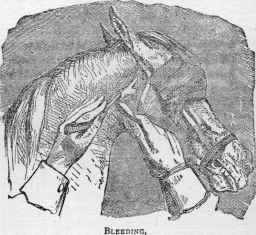
bring ft fairly into view, but not to swell it too
much, for then, presenting a rounded surface, it
would be apt to roll or slip under the blow. The
point to be selected is about two inches below the
union of the two portions of the jugular at the
angle of the jaw. The fleam is to be placed in a

200 THE FRIEND OF ALL.
direct line with the course of the vein, and over
the precise center of the vein, as close to it as
possible, but its point not absolutely touching the
vein. A sharp rap with the bloodstick (as in the
cut) or the hand on that part of the back of the
fleam immediately over the blade, will cut through
the vein, and the blood will flow. A fleam with
a large blade should always be preferred, for the
operation will be materially shortened, which will
be a matter of some consequence with a restive
horse; and a quantity of blood drawn speedily
will have far more effect on the system than
double the weight slowly taken ; while the wound
will heal just as readily as if made by a smaller
instrument.
When the blood begins to flow, it should be
received in the pail already mentioned, which is
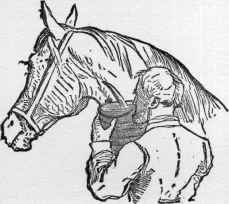
Holding the Pail.
pressed against the horse's neck, thereby imped
ing the downward stream within the vessel and
causing the blood to gush out.
When sufficient blood has been taken, remove
the pressure below the orifice and the outward
stream will cease. Then put a pin through each
side of the wound, and twist, after
the fashion of a figure of 8, some
tow or thread, or a hair pulled
from the horse's tail, round each
end. Subsequently remove so
much of the pin as may protrude,
and the orifice will be closed by
what surgeons denominate a twist
ed suture. The head of the horse
should be tied up for several hours, to prevent
his rubbing the part against the manger. In
bringing the edges of the wound together, and
introducing the pin, care should be taken not to
draw the skin too much from the neck, as blood
will insinuate itself between the skin and the
muscles beneath, and cause an unsightly and
sometimes troublesome swelling. Twenty-four
hours after the operation, the edges of the wound
will have united, and the pin should be with

drawn. When the bleeding is to be repeated, if
more than three or four hours have elapsed, it
will be prudent to make a fresh incision rather
than to open the old wound.
OTHER METHODS OF TREATMENT.
As would naturally be expected, there are
various theories and systems of treating ailing
horses. Patent-medicine men have not neg
lected him ; and offer unnumbered remedies as
certain speedily to relieve him of every possible
ailment, as are the countless nostrums certified
to be equally efficacious in the case of his human
brethren. Nor has Homeopathy overlooked him :
Similia Similibus Curantur offers its priceless
discoveries to dumb as well as to speaking ani
mals; and a diminutive medicine-chest, with
numbered specifics, is heralded as sufficient for
the largest stable, with perhaps a call on the
Homeopathic practitioner in an extreme case.
The Turkish Bath.—David Urquhart, who was
mainly instrumental in the introduction of the
Turkish Bath into Western Europe, whence it
long ago emigrated to the United States, had
great faith in its benefits to lower animals, no
tably horses and cattle, as well as to men. As
long ago as 1865 Dr. Sir John Fife compiled and
published from Mr. Urquhart's writings a book
entitled “Heat a Mode of Cure and Source of
Strength to Men and Animals.” In this the
action of the Bath on a farm is described and
commended ; and many instances are given of
the wonderfully good results following its appli
cation. His theory is, that the horse, who is
indigenous to high and cold regions, but never
theless flourishes in hot and dry zones, should
not be housed and cuddled as if he were a sick
infant, but needs pure heat and cold. He says:
“A large portion of food is expended on the
production of animal heat. The smaller the
size of the animal, the larger is the surface in
proportion to its bulk, and therefore the greater
the escape of heat. A canary-bird in proportion
to its size and weight consumes many times as
much food as a man. Heat escapes far more
rapidly from the man than from the horse. The
effect, then, in the form of saving food, is for the
horse very considerable. It is thus that the
horse is enabled to inhabit the regions adjoining
the limits of eternal snow. Consequently heat,
externally applied to him, has so much greater
power than in man. In the cold regions of Tar-
tary, or the hot ones of Persia, Mesopotamia, the
Nedjd, or the African deserts, he is severally
brought to the highest perfection by heat or cold.
I look therefore to the Bath as capable of furnish
ing a finer breed of horses than has as yet been
obtained.” He denounces the currycomb as a
HORSES AND THEIR MANAGEMENT.
201
stupid and cruel instrument to remove the scurf-
skin, and claims that by the bath—
Its Results.—“The skin is cleansed far more
completely than by any other method of groom
ing ; the system relieves itself, through the skin,
of every kind of impurity; the animal is enabled
to bear, with perfect impunity, the greatest alter
nations of heat and cold ; the appetite, so fre
quently a poor one in training, is increased, and
digestion promoted ; the lungs are brought into
strong play, without increased action of heart
and pulse;" etc. etc.
A friend tells of a visit he made to a farm near
Dublin, where the Turkish Bath was given once
a week to the horses and cattle, regularly, not
waiting for them to get out of order, but as a
tonic and preventive of sickness. The proprietor
said that he could tell by the appearance of his
Stock, if they had been deprived of this hygienic
appliance.
In the stables of the Third Avenue Railroad Com
pany, New York, where some 2000 horses are
kept, a Turkish Bath was introduced early in
1882, and is still in successful operation. A re
porter from the Times “ interviewed” the Bath
and Dr. Hough, and we will freely borrow his
language. “ A space about as large as six or eight
ordinary stalls has been tightly inclosed, with
thick board walls, floor and ceiling. The floor is
covered with movable slats, and under these are
steam-pipes by which the temperature can be run
up to 1000,1500 or 2000, at the will of the operator.
In front of two of the stalls are small square
windows, each large enough for a horse to put
his head through. These windows can be closed
with board shutters, and they are all provided
with heavy curtains opening in the center. When
it is desirable to give a horse a very hot bath in a
room whose temperature must be higher than
the horse could breathe with comfort, the window
is opened, and the horse, with his body in the
bath, puts his head out into the cold air. The
curtains are then drawn tight about his neck, to
prevent the heat from escaping, and the horse
has all the luxury of a Turkish Bath without the
inconvenience of breathing the overheated air.
Horses requiring treatment are left in the bath
from twenty minutes to an hour, and are then
washed with tepid water and thoroughly scrubbed.
After being groomed till he shines like a new
sealskin sacque, a horse on coming out of the
bath is taken into the cooling-room and kept
there an hour or more, the temperature being
lowered gradually till it is the same as in the
body of the stable. When this point is reached,
the horse is ready to be taken back to his stall,
and is to all intents a new animal.
Other Baths.—In these stables, out of the 2000
horses, there will be 50 to 100 ailing, and the
Russian and Electric baths are also employed.
In the Russian baths, the steam is let out of the
pipes into the room, till the atmosphere is wet
enough to bottle. Here the horses sometimes
rebel, but do not make any vigorous resistance.
Several horses, too sick to stand up, have been
treated. For their accommodation there is a
stout blanket, fastened to ropes running through
pulleys in the ceiling. The blanket is put under
the horse's body, the ropes are tightened, and he
takes his bath swinging in a hammock.
Dr. Hough tells of one of the best horses in the
stable that had a very severe attack of pneumon
Her pulse was extremely high, and she had
dangerous rattling in the bronchial tubes. He
put her in the Russian bath, and kept her
nearly all the afternoon, reducing the ternperature
gradually. She perspired very freely, and when
she was taken out of the bath the rattling was
entirely gone. The next day the mare was much
better, and the bath was repeated. On the third
day she was given another bath, and when she
came out her pulse, respiration and temperature
were normal. At the end of a week she was en
tirely well and was put to work. For pink-eye,
which is an aggravated form of influenza, with
bronchial troubles, the baths are very efficacious.
A horse was put in with his eyes entirely closed
and a heavy discharge of white mucus from eyes
and nostrils On the day following the first
bath, the swelling was greatly reduced, and the
discharge had disappeared. Horses have also
been successfully treated for founder.
For strains, sprains and various other ailments,
electric baths are given. The horse to be treated
with electricity is put into the warm room and is
well rubbed down with sponges attached to
electric wires. The animals do not quite know
what to make of the electric shock, but take
kindly to it after a little experience.
In every material point these baths are pre
cisely similar to those provided for men and
women. The horses are heated to a high point,
deluged with water, thoroughly kneaded, slowly
cooled off, the batteries being capable of giving
a shock that could make any human being
“ squirm.”
A Cynic.—We asked a well-known trainer and
driver, “ Do you ever bleed your horses?” “ Never
bled a horse.” “How do you manage when an
animal gets out of order?” “ If it is hot and has
fever, I blanket it heavily and sweat it off.
Otherwise I stop its feed and let it get well, as I
do in my own case.” “ Don't you call in a vet. ?“
“Sometimes, if I am sure the horse is going to
die, anyway.” Of course, this trainer did not ex-
pect his words to be taken literally. But un
doubtedly there is too much, rather than too
little, heroic treatment given to horses,
But first, if you want to come back to this web site again, just add it to your bookmarks or favorites now! Then you'll find it easy!
Also, please consider sharing our helpful website with your online friends.
BELOW ARE OUR OTHER HEALTH WEB SITES: |
Copyright © 2000-present Donald Urquhart. All Rights Reserved. All universal rights reserved. Designated trademarks and brands are the property of their respective owners. Use of this Web site constitutes acceptance of our legal disclaimer. | Contact Us | Privacy Policy | About Us |